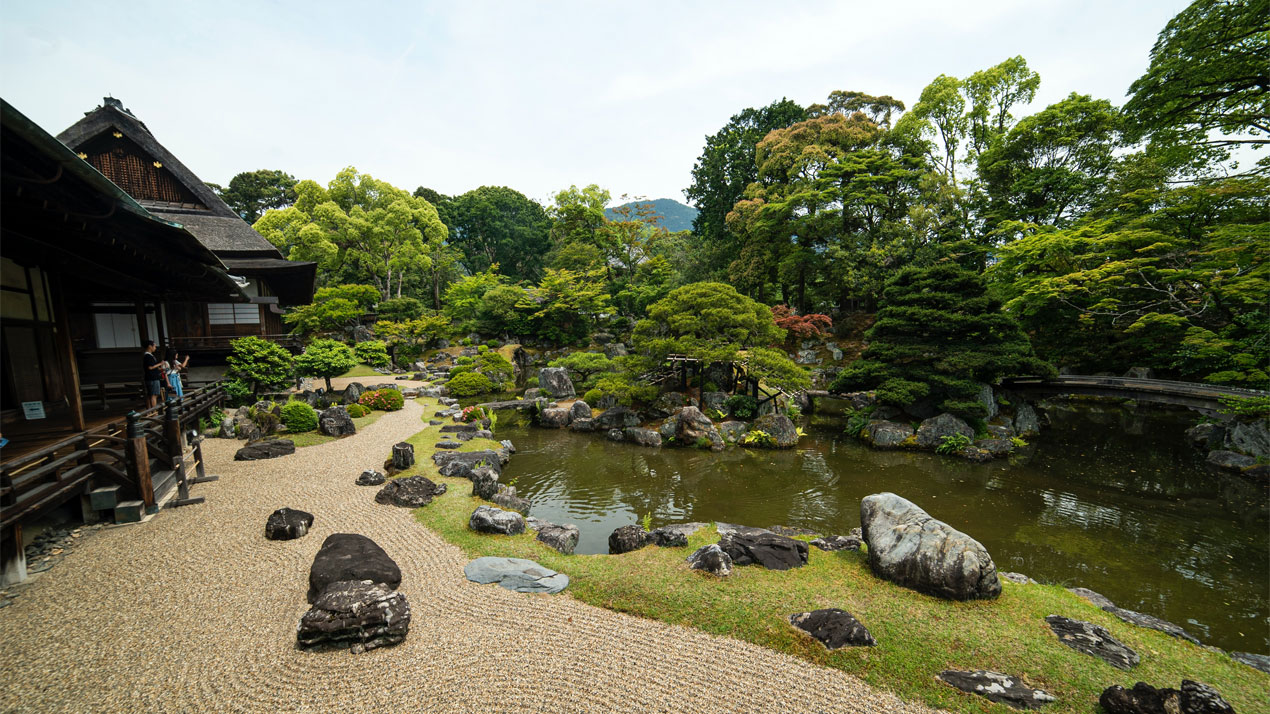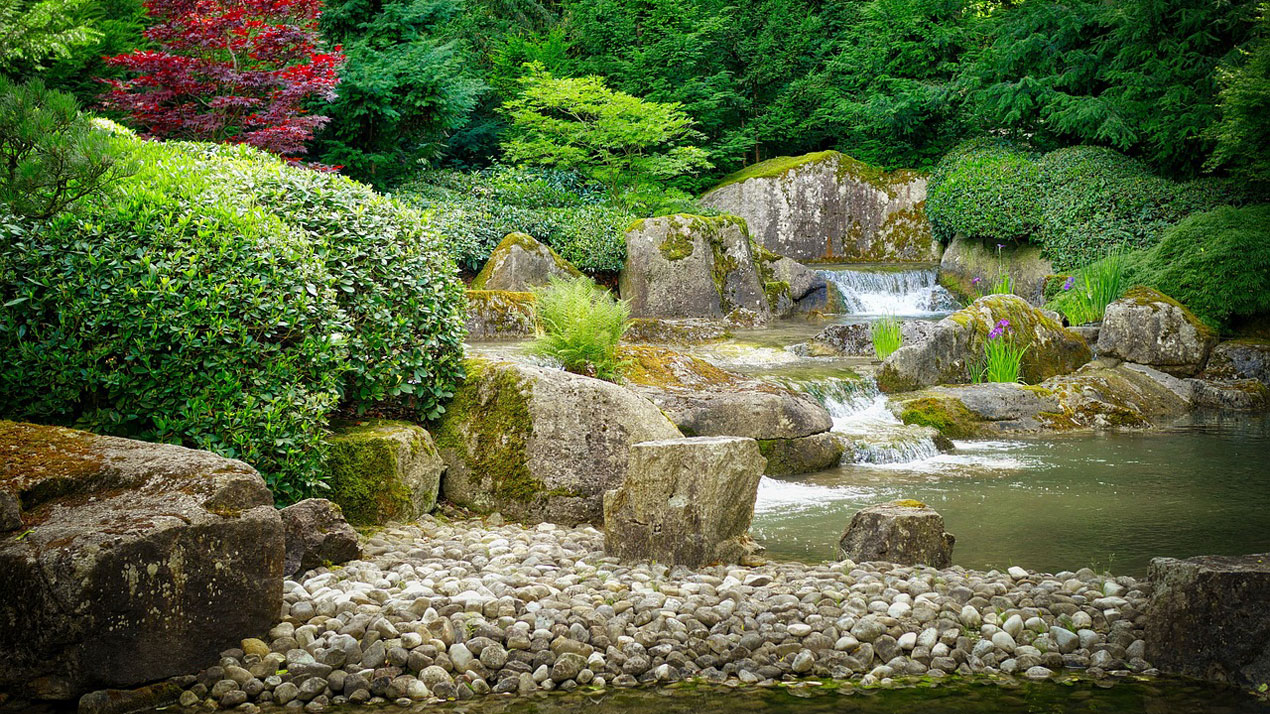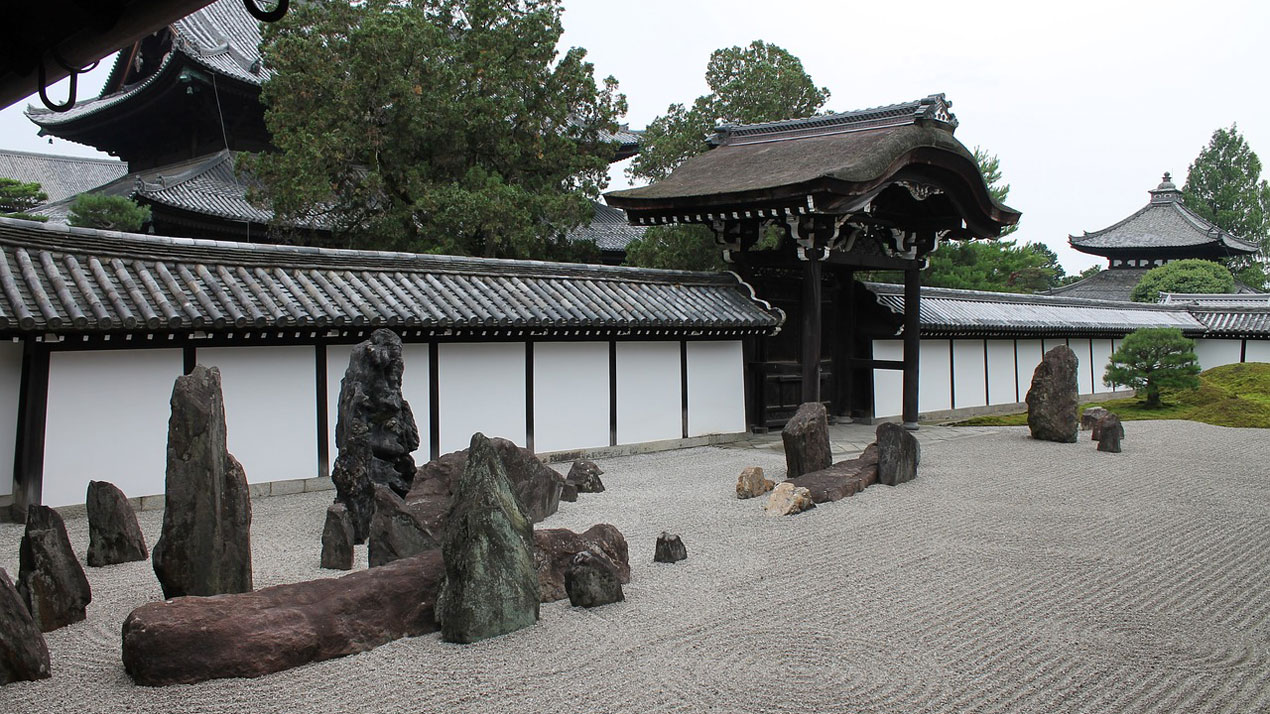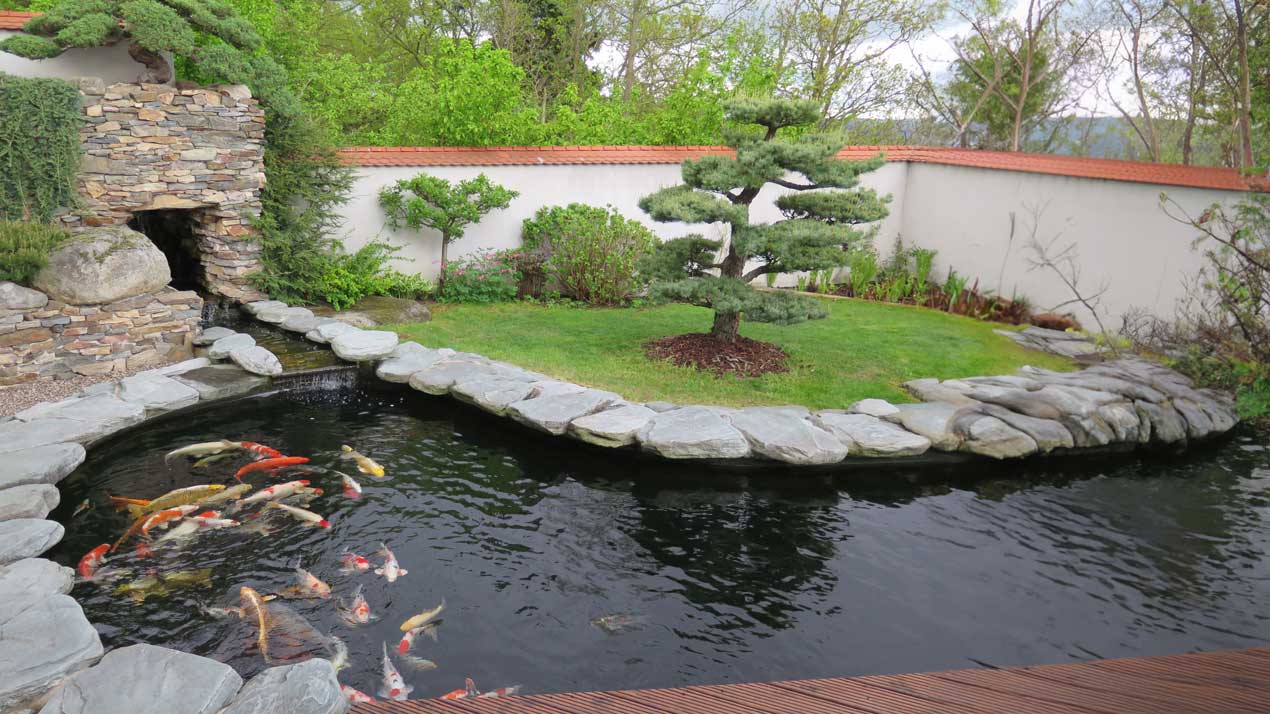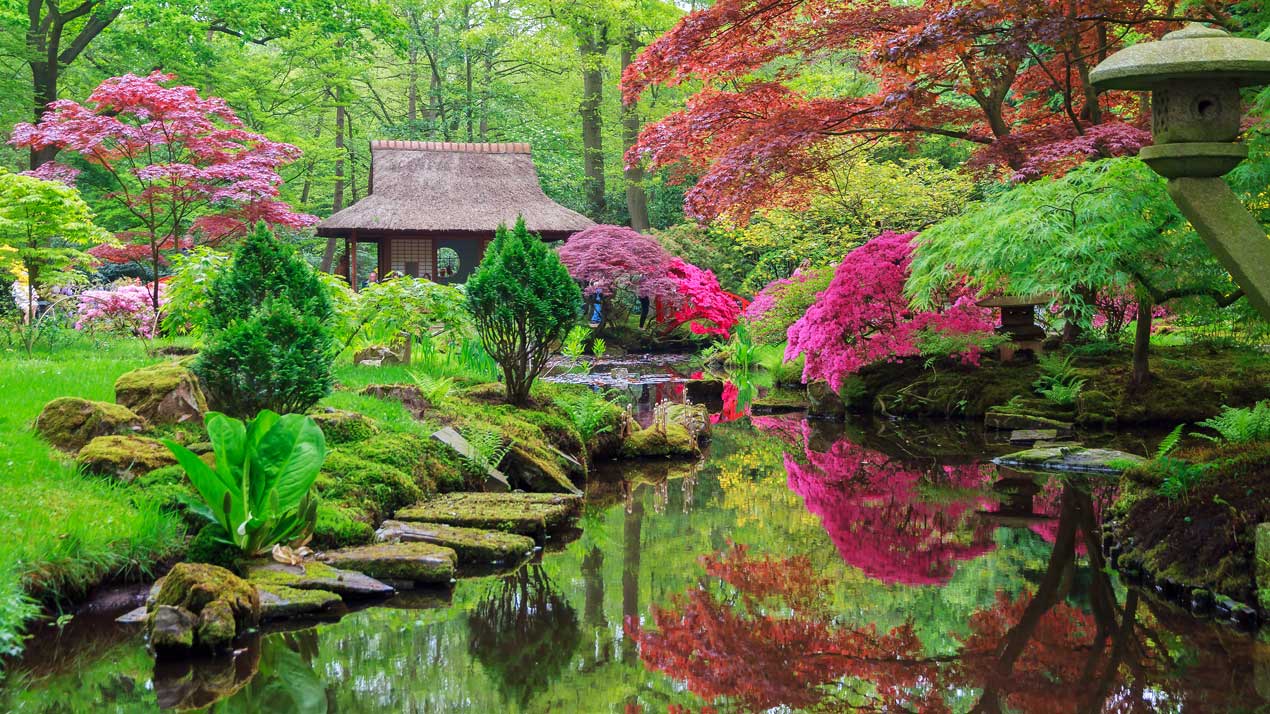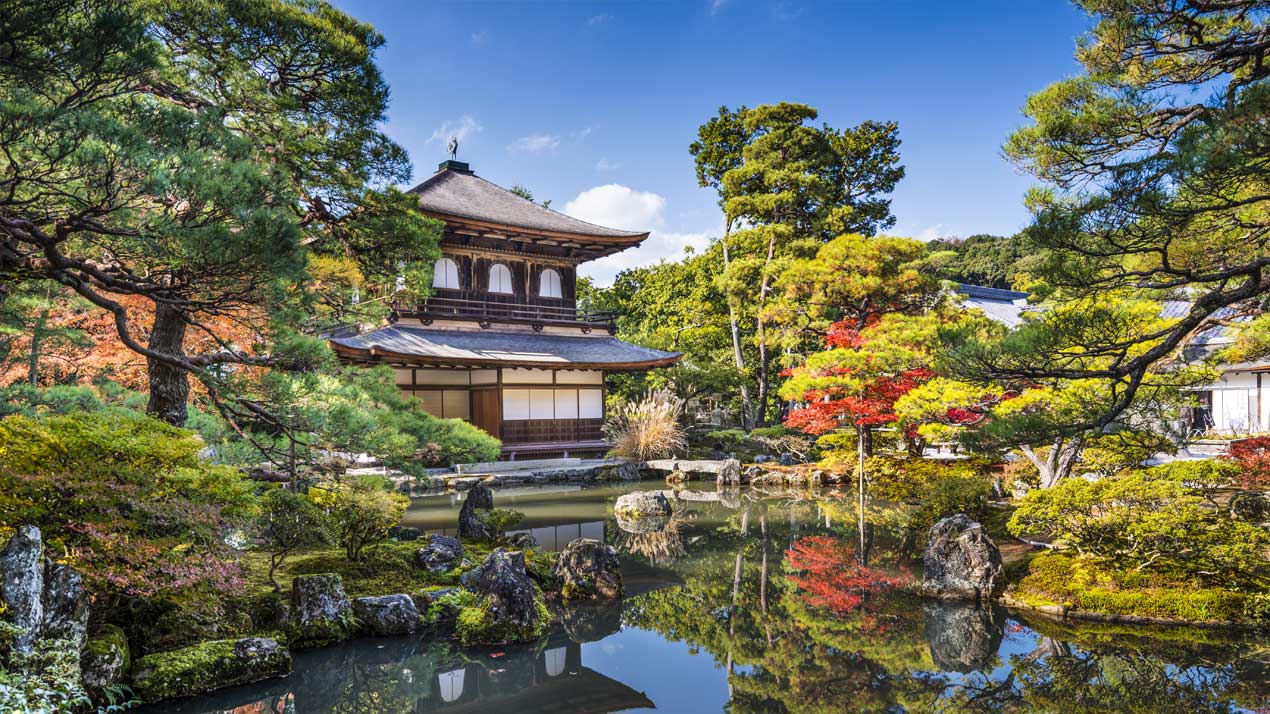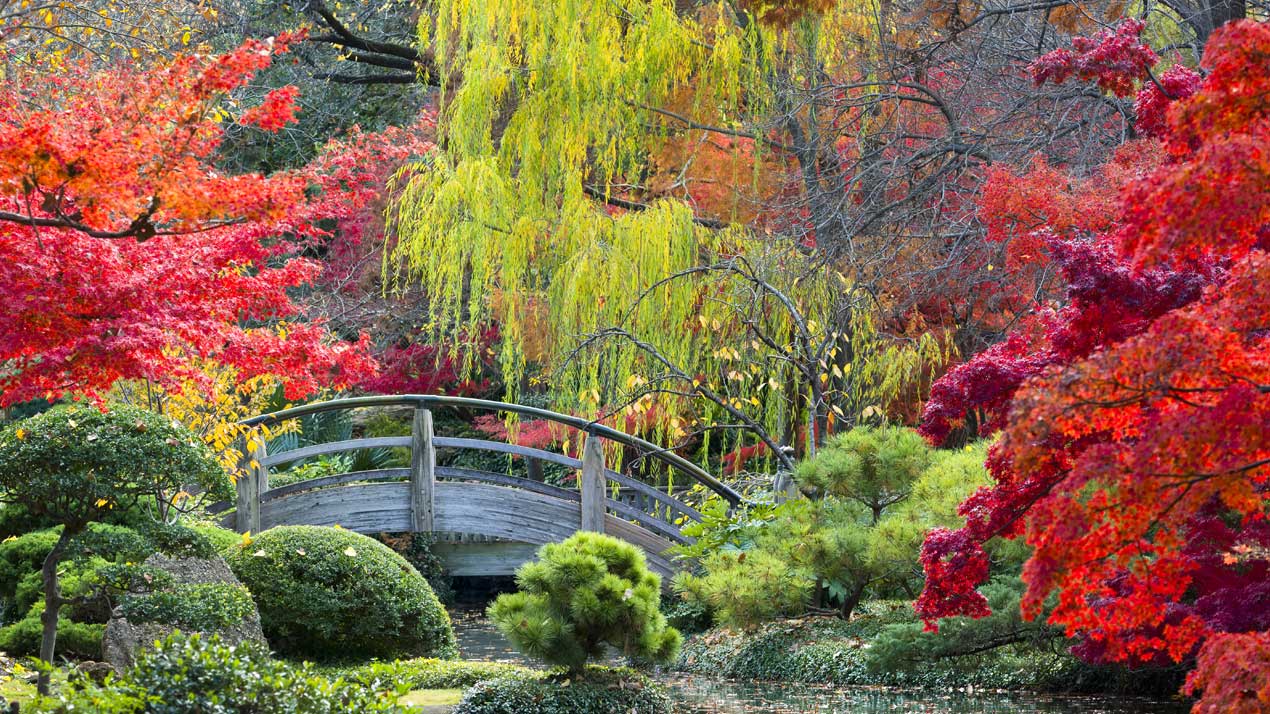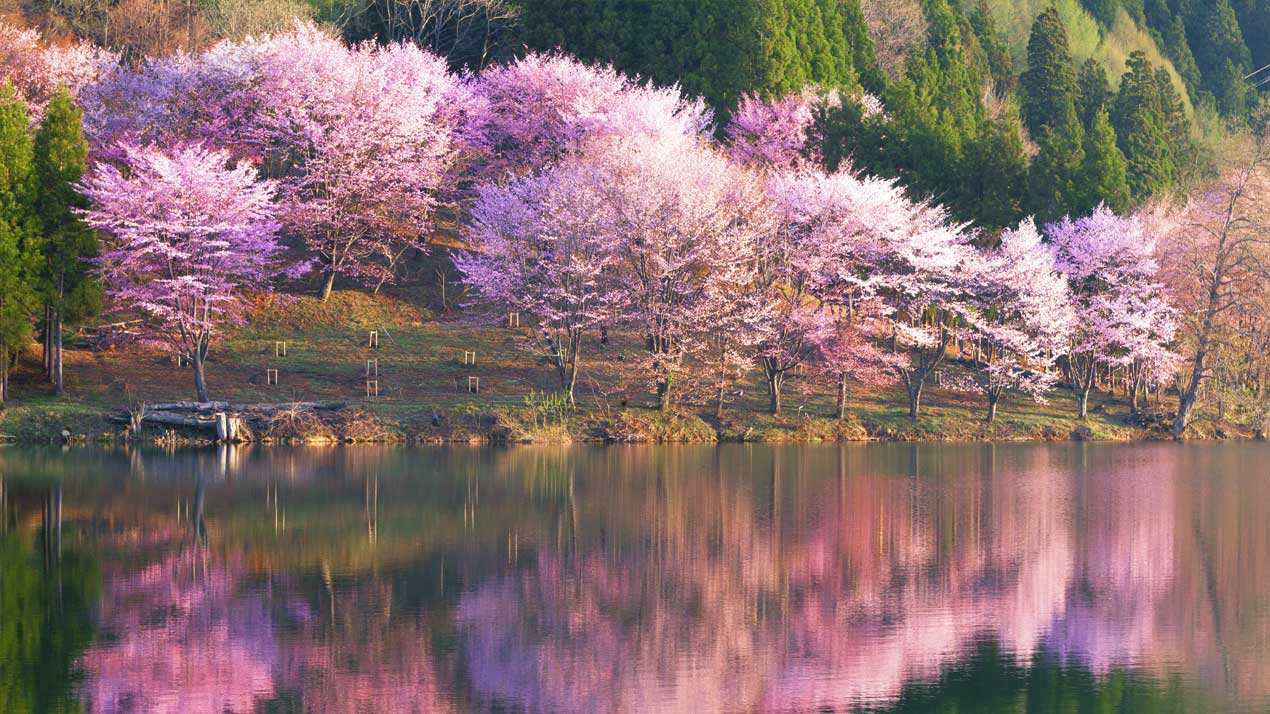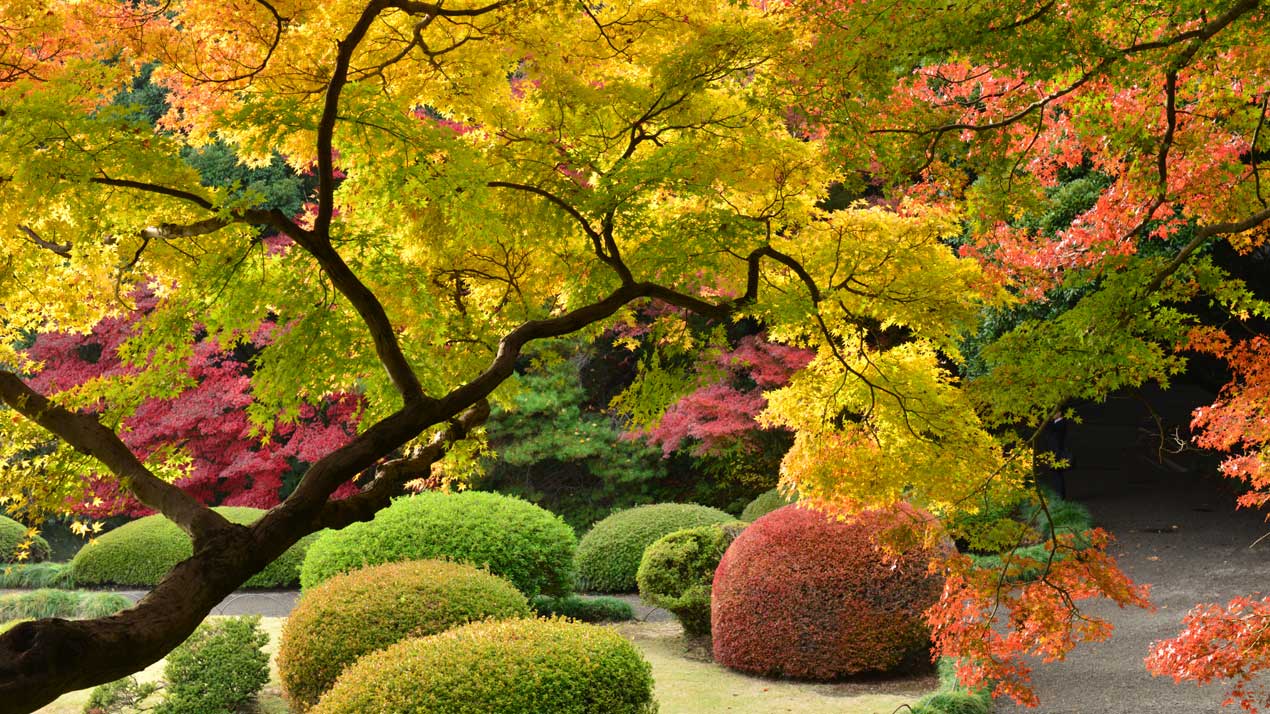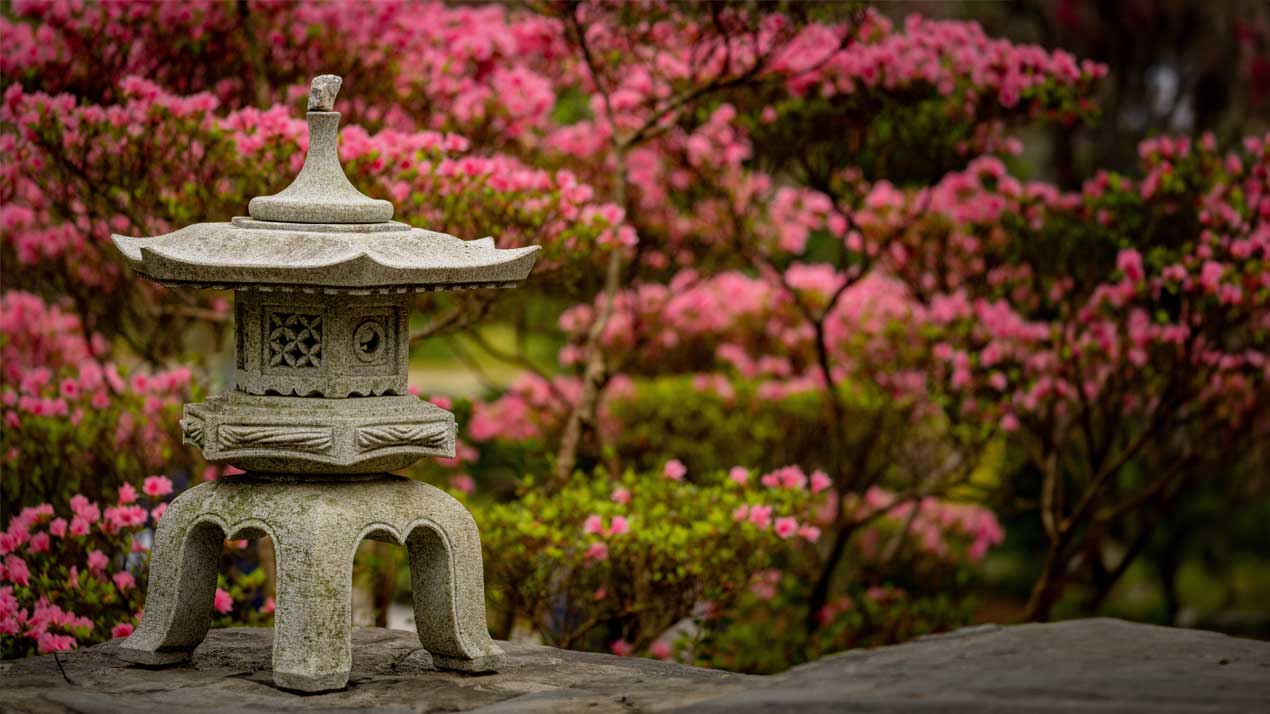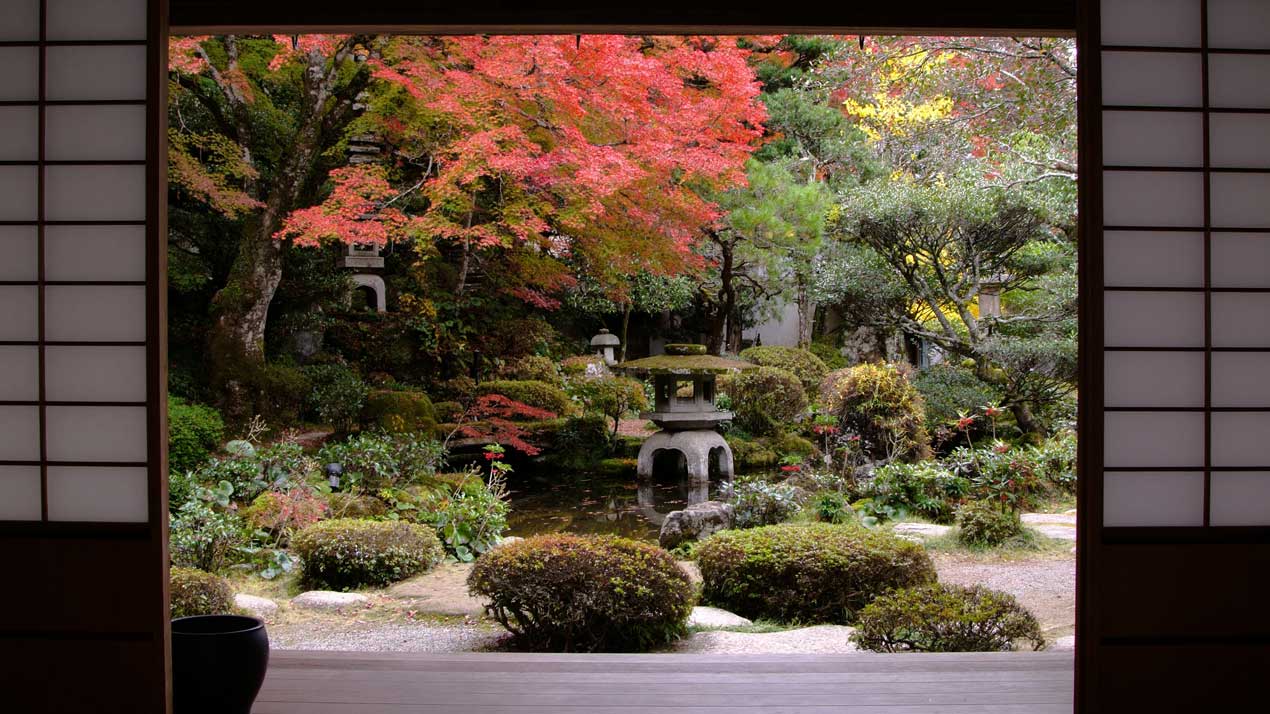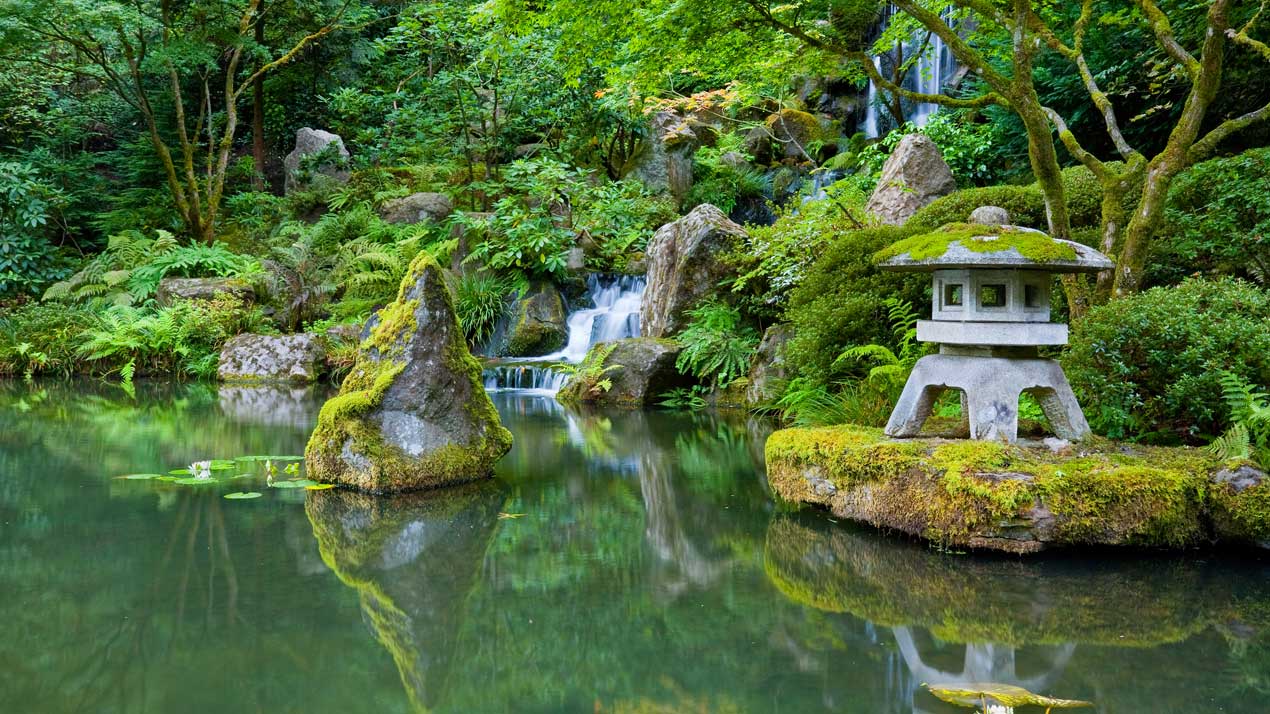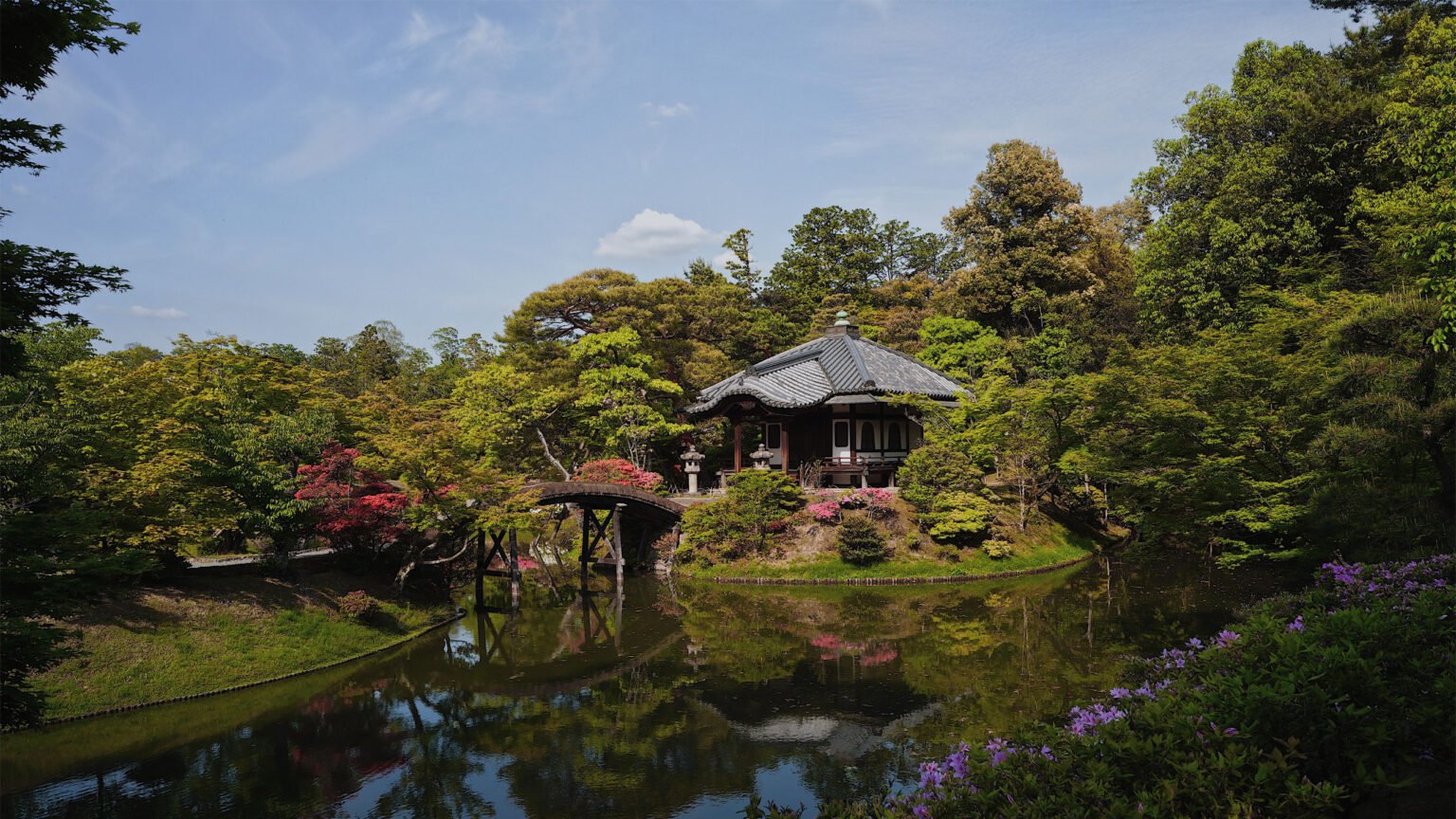
Japanese gardens are serene and harmonious outdoor spaces that encapsulate nature’s beauty and philosophical concepts. Characterized by meticulous design, they blend elements such as rocks, water features, plants, and pathways to create a tranquil atmosphere.
Distinctive features include the use of asymmetry to evoke natural landscapes, reflecting the Japanese appreciation for imperfection and transience. These gardens often incorporate symbolic elements like lanterns and bridges, while carefully composed views encourage contemplation and mindfulness. Every element serves a purpose, reflecting the balance between man-made and natural elements. Japanese gardens invite visitors to experience a sense of calm, fostering a deep connection with nature and cultural aesthetics.
History of Japanese Gardens
The earliest gardens recorded were pleasure gardens of the Emperors and nobles, as noted in the Nihon Shoki, where it mentions Emperor Keiko (71-130 CE) adding carp to the pond in his pleasure garden.
The origin of Japanese garden as we know them is thought to have begun during the Asuka period (592-710 CE) when the art of garden design was first introduced to Japan by merchants returning from China. The first gardens were introduced on the main central island of Honshu, where mountainous volcanic terrain, steep valleys, with streams, cascades and water falls were commonplace, and four distinct seasons were part of the natural cycle of life. These environmental factors were to set some of the main underlying aesthetic sensibilities and influences that define Japanese garden design.
The birth of what we consider to be “Japanese” gardens was begun in the Nara period (710-794 CE) with gardens being built in the city of Nara, as more modest scaled down versions of the Chinese Tang Dynasty’s imperial gardens. They differed from Tang designs by incorporating natural shore lines and stone settings, and an overall more naturalistic and less formal approach to the design.
Heian-kyō’s gardens, in the Heian period (794-1185 CE), exemplified Japanese aesthetics and spirituality. Designed for imperial residences, they embodied tranquility, with ponds mirroring celestial perfection. Gravel raked into intricate patterns suggested flowing water. Symbolic islets and bridges represented mythological themes. Rich vegetation and meticulously placed rocks evoked harmony. Gardens served as poetic metaphors, fostering introspection and connection to the divine. These gardens mirrored the era’s refined culture, where nature and art intertwined, leaving an indelible mark on Japanese garden design.
During the Kamakura period (1185-1333) when the Government reopened contact with China (after a 300-year isolation), the concept of Zen Buddhism was introduced to Japan, and with it came a new approach to garden design. Zen gardens, also known as rock gardens, are simple, minimalist gardens designed to aid in meditation and contemplation. These gardens typically feature carefully arranged rocks, sand or gravel, and small clusters of plants.
Koishikawa Botanical gardens, Japan
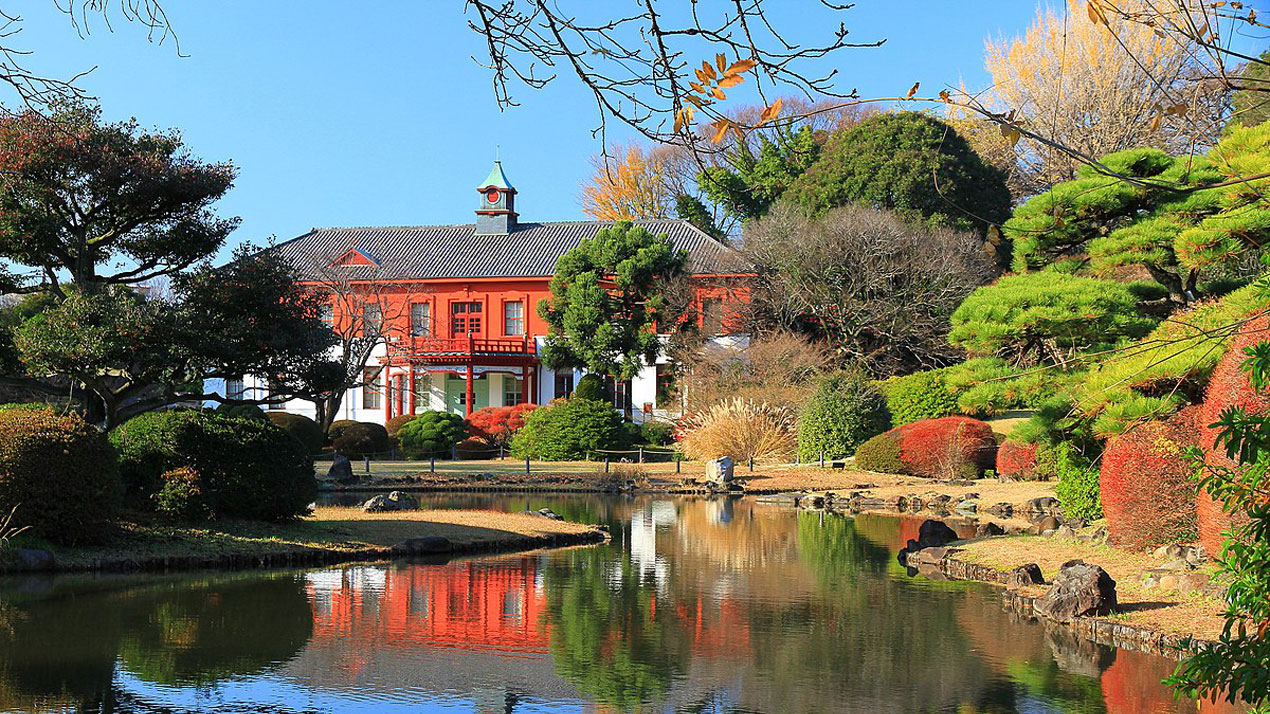
Nestled in Tokyo, Japan, Koishikawa Botanical gardens are a picturesque haven of tranquillity. Since 1684, these gardens have captivated visitors with a delightful blend of traditional Japanese landscapes and contemporary elements. Bursting with diverse plant species and wildlife, it’s a paradise for nature enthusiasts and history lovers alike. Stroll through lush greenery, ponds, and charming bridges, and experience the timeless beauty and serenity of this cherished botanical gem.
In the Muromachi period (1336 – 1573), Japanese gardens began to incorporate more natural elements such as water and trees. The tea garden, or roji, emerged during this time as a separate style of garden design. Tea gardens were designed to be a tranquil and harmonious setting for the traditional tea ceremony.
Tea House in Japan
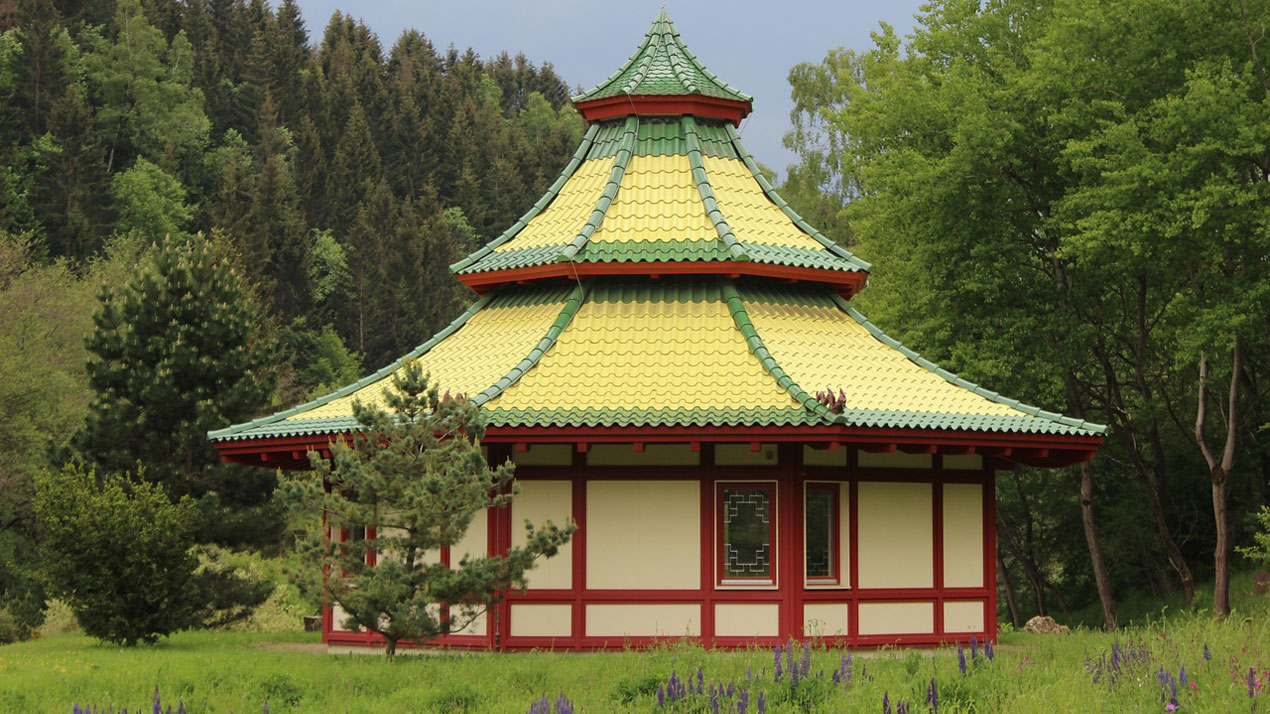
During the Edo period (1603 – 1868), Japanese gardens became more elaborate and sophisticated. Gardens were designed to reflect the changing seasons and to create a sense of tranquillity and harmony with nature. Many famous Japanese gardens, such as the Katsura Imperial Villa and the Kenrokuen Garden, were created during this period.
In the modern era, Japanese gardens have continued to evolve and adapt to changing tastes and styles. Today, Japanese gardens can be found around the world, and are cherished for their beauty, tranquillity, and unique cultural heritage.
Kenrokuen Garden, Japan
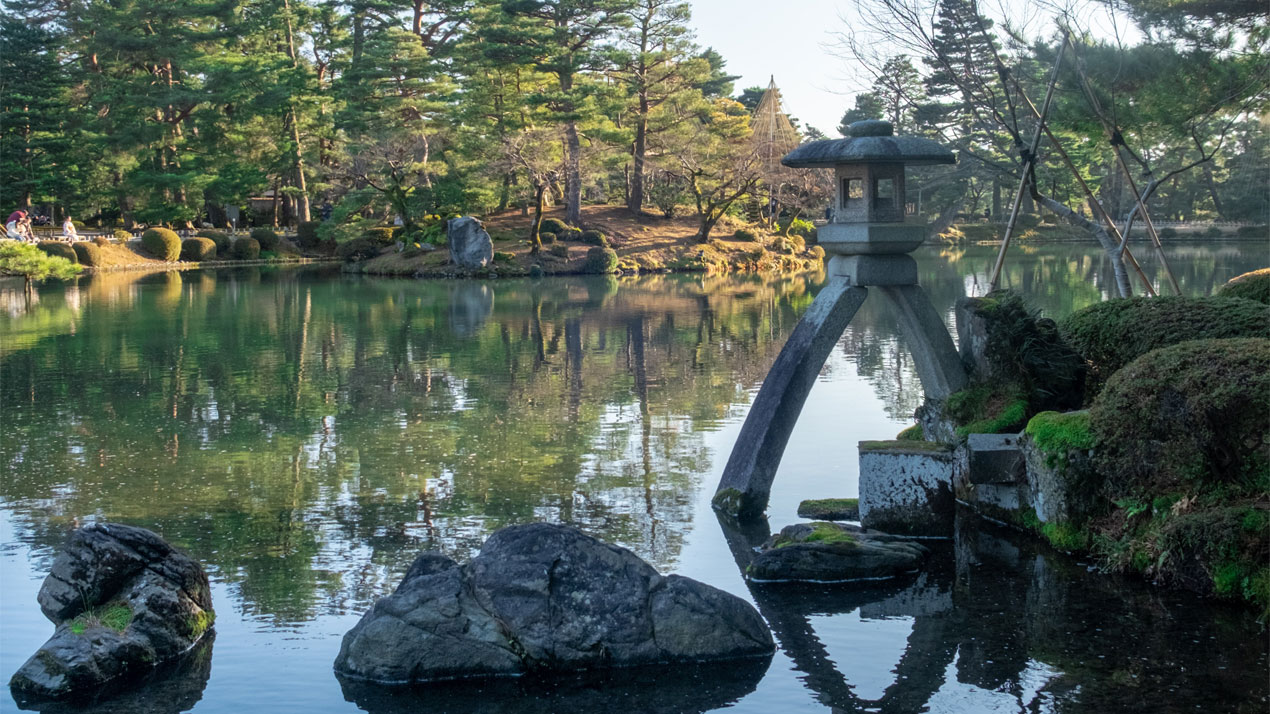
Kenrokuen Garden, situated in Kanazawa in Japan, is a masterpiece of horticultural artistry. Renowned for its exquisite landscapes, it embodies the six essential attributes of a perfect garden: spaciousness, seclusion, artificiality, antiquity, water features, and panoramic views.
Dating back to the 17th century, this enchanting garden offers visitors an unforgettable experience through its meticulously designed scenery, teahouses, and seasonal charm.
Japanese gardens are designed to create calm, harmony and provide a peaceful retreat for reflection and meditation. Their aesthetic is simple and minimalistic, and often leads to self reflection, regardless of their size, whether privately own gardens or large public parks.
Four Elements of Japanese Gardens
A Japanese garden will usually contain four essential elements:
- Rocks
- Water
- Plants
- Human structures
Rock
Four Elements of Japanese Gardens
Rock and stone hold profound significance in Japanese garden design, embodying natural elements and spiritual symbolism. These inert materials evoke mountains, islands, and rivers, reflecting the essence of nature. Placed strategically, they create a harmonious balance with plants and water features, encouraging contemplation and meditation. Rocks are meticulously chosen for their shapes, sizes, and textures, symbolizing endurance and permanence. Through careful arrangement, these elements transform gardens into living art, fostering tranquillity and connection to the world’s rhythms, making them integral to Japan’s revered garden aesthetics.
Japanese Dry Garden (Karesansui)
Karesansui, also known as a “dry landscape” or “zen garden,” is a Japanese garden style that utilizes carefully raked gravel or sand to symbolize water, while rocks and stones represent mountains or islands. This minimalistic design seeks to evoke a sense of tranquillity, harmony, and meditation. The meticulously placed rocks and patterns in the gravel encourage contemplation and introspection, inviting observers to find a connection with nature and their inner selves through the arrangement’s simplicity and symbolism.
The most commonly used rocks in Japanese gardens are:
Granite
Granite is a very hard, durable and almost impervious stone (igneous/volcanic rock). In Japanese gardens, it is often used to create pathways and steps. It is also used to create natural looking features (streams and cascades) and to fabricate stone objects such as lanterns and water bowls.
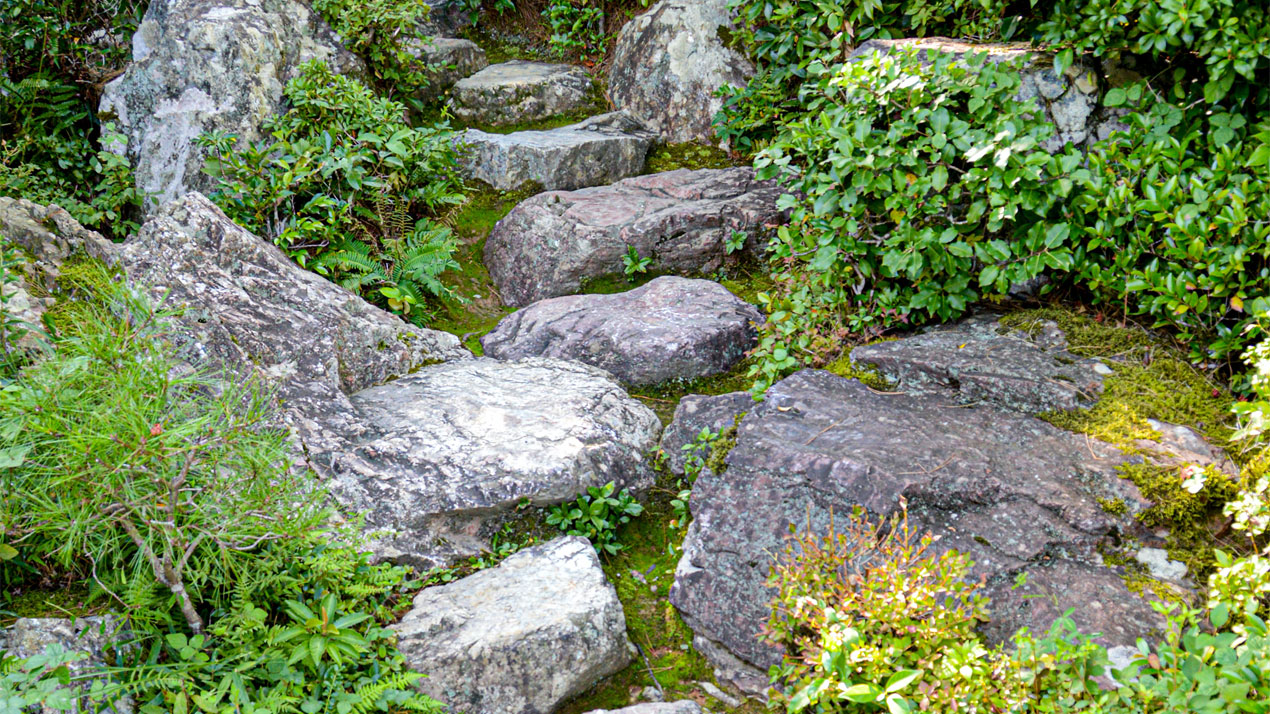
Basalt
Basalt is a hard and durable volcanic rock that is characterised by its dark grey and black colouring. In Japanese gardens, it is commonly used in to create waterfalls and other water features. It is also used to create stepping stones and to build garden walls. Its dark colouring means it is often used adjacent to lighter material to create striking contrasts.
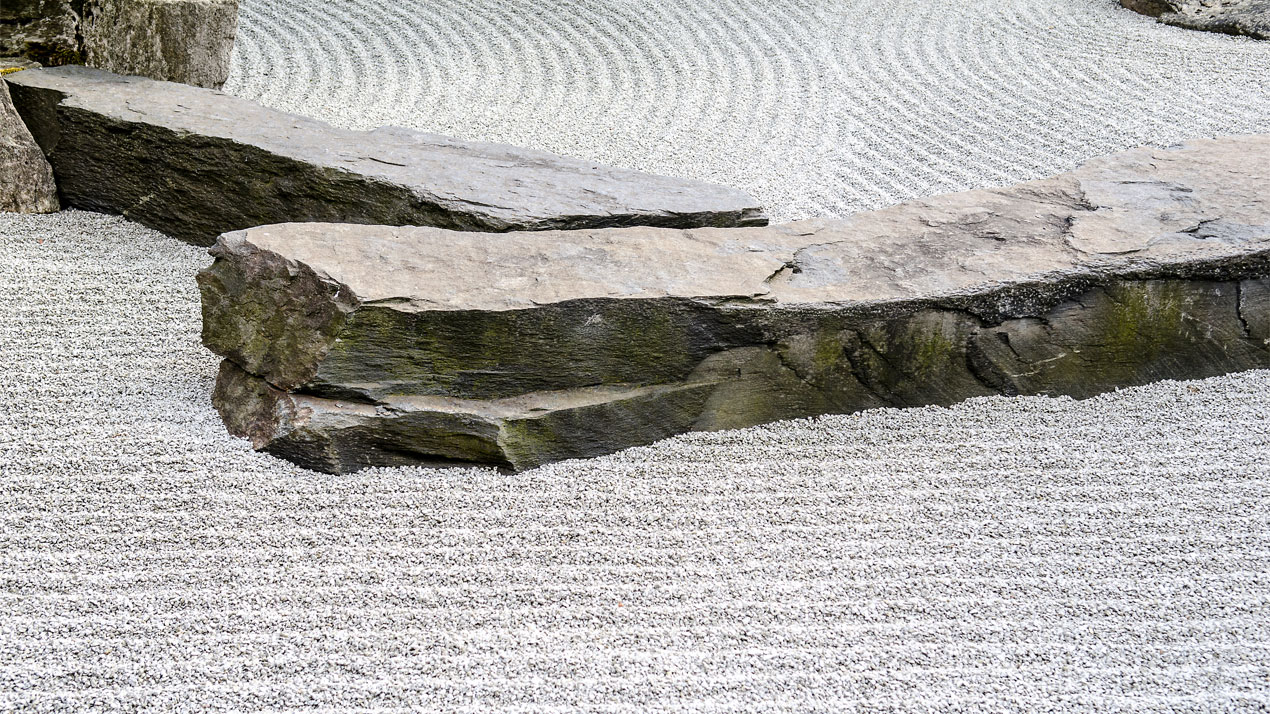
Limestone
Softer and porous than granite or basalt, but still durable and hard-wearing, limestone is a sedimentary rock that can be easily quarried and worked. This has made it a popular material with landscapers across the globe since the dawn of civilisation. In Japanese gardens, limestone is often used to create garden sculptures, ornaments, water features, and to build garden walls.
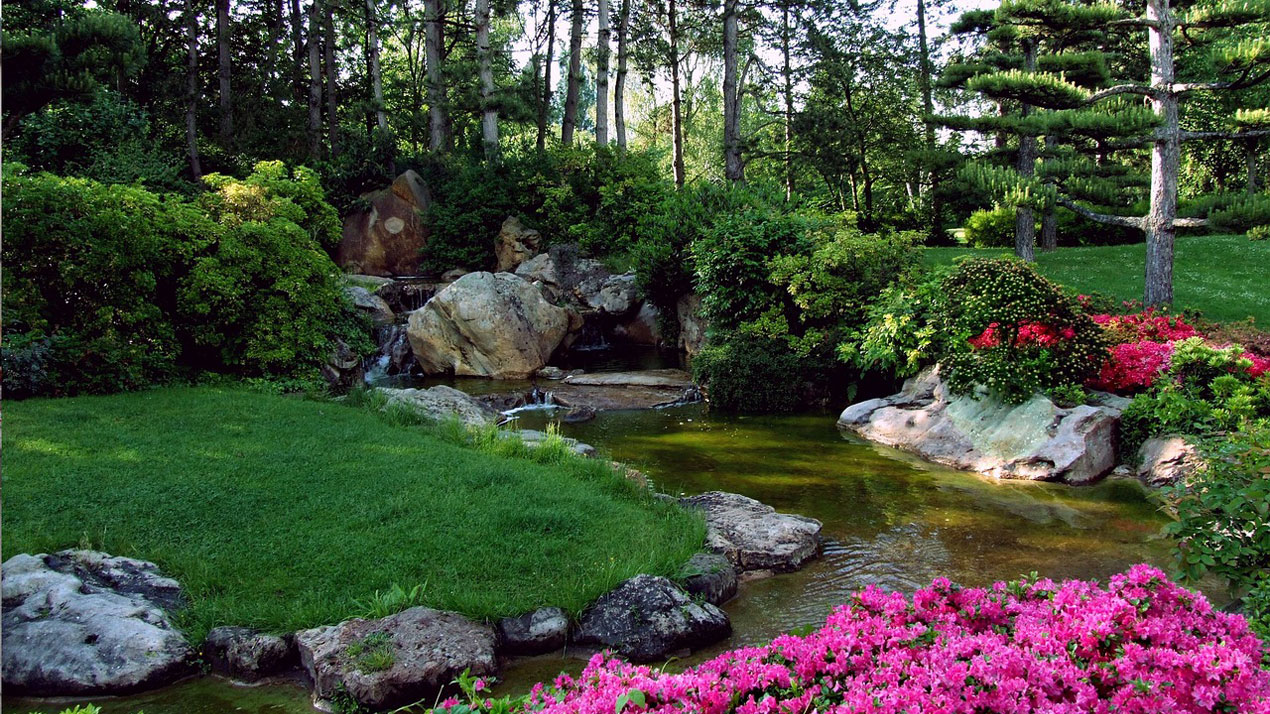
Sandstone
Sandstone is a commonly found sedimentary rock composed of sand-size grains of mineral rock, or organic material. Like limestone, it is easily quarried and worked, making it a popular landscaping material. In Japanese gardens it is largely used to create garden sculpture and ornaments, and to build pathways and garden walls.
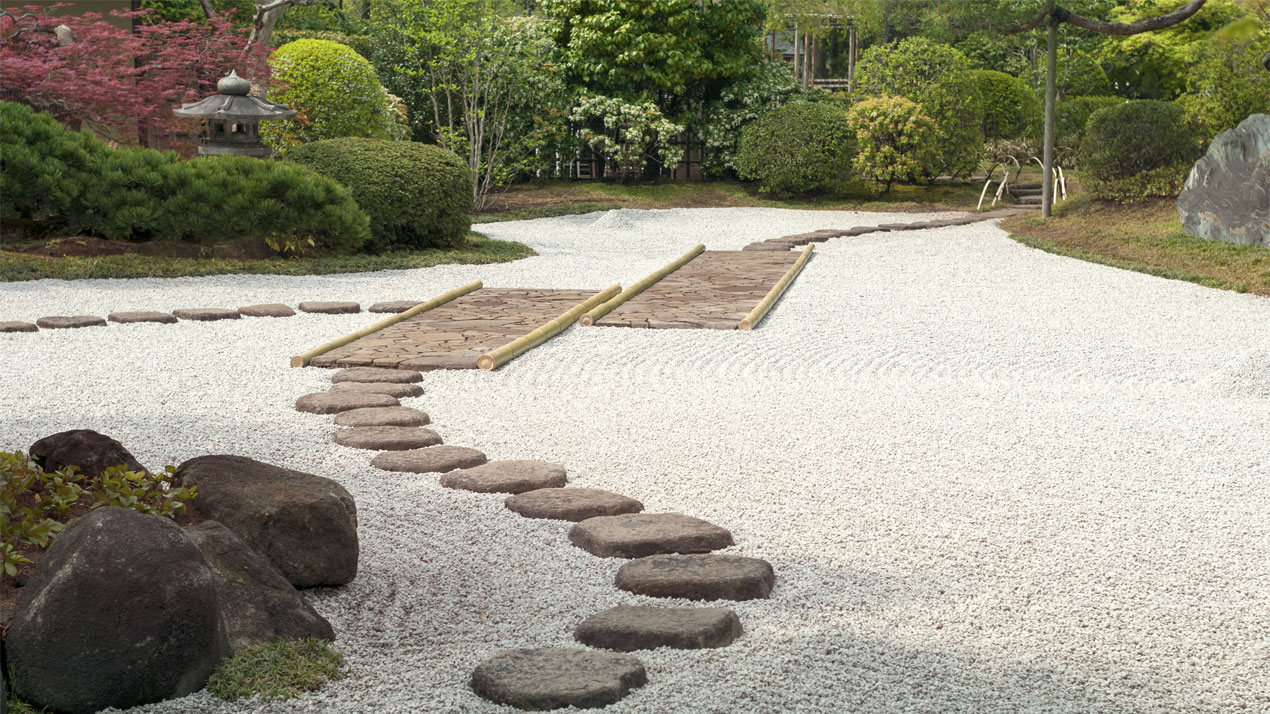
Slate
Slate is a fine-grained foliated, homogeneous metamorphic rock (metamorphic rocks arise from the transformation of existing rock under pressure and/or heating). It is mostly impervious, so great for resisting water penetration. In Japanese gardens it is used to create garden sculptures, ornaments and water features. It is also used to build garden walls.
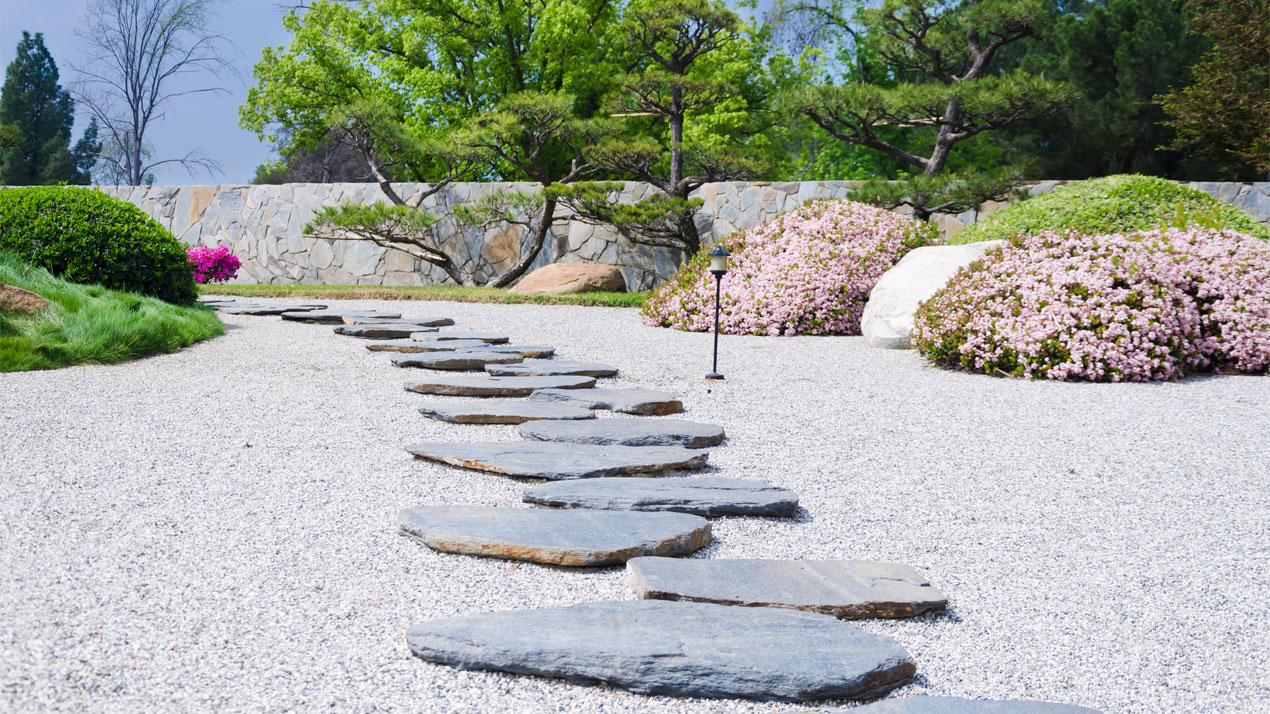
Decorative Aggregate & Sands
Japanese gardens incorporate various decorative aggregates, including crushed granite, pebbles, and river rocks. These materials are meticulously arranged to emulate natural landscapes. Each stone type signifies different elements, from stability to movement, contributing to the garden’s symbolic and aesthetic richness. Traditionally, white and lighter aggregates are favoured, like white fine-grain gravel (shirakawa-suna). Also, black volcanic gravels and sands, play a significant role in Japanese gardens. Raked into patterns, they evoke ripples in water and symbolize dynamic energy. These sands infuse gardens with a sense of calm and impermanence, reflecting the essence of Zen philosophy.
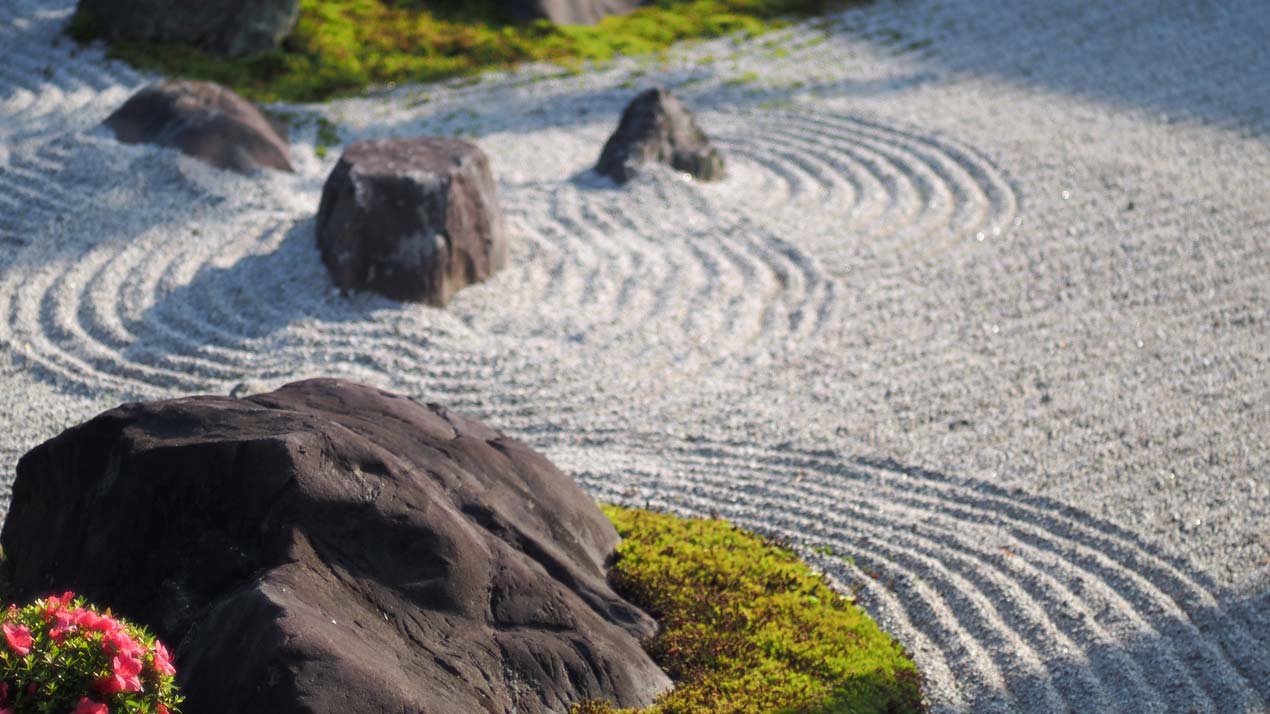
In order to create flow and movement, Japanese gardens often incorporate gravel and sand. The placement of each rock in Japanese gardens is very thoroughly elaborated, to create a harmonious and balanced composition.
Water
Four Elements of Japanese Gardens
Water elements are integral to Japanese gardens, embodying serenity and life’s flow. Ponds, streams, and waterfalls symbolize nature’s dynamic balance, reflecting tranquillity and renewal. Stones and bridges within these aquatic realms evoke contemplation, harmonizing with the garden’s essence, and inviting introspection amidst the beauty of water’s gentle movements.
Ponds, Pools, and Lakes
Water is one of the most essential elements in Japanese gardens. It creates a sense of harmony, peacefulness and natural beauty. The most common use of water in Japanese gardens are ponds and streams.
Japanese garden ponds and streams are usually designed to appear as natural as possible, and are often surrounded with rocks, plants, or other elements to create balance and tranquillity. The water is generally still or slow-moving, to emphasise the calming atmosphere.
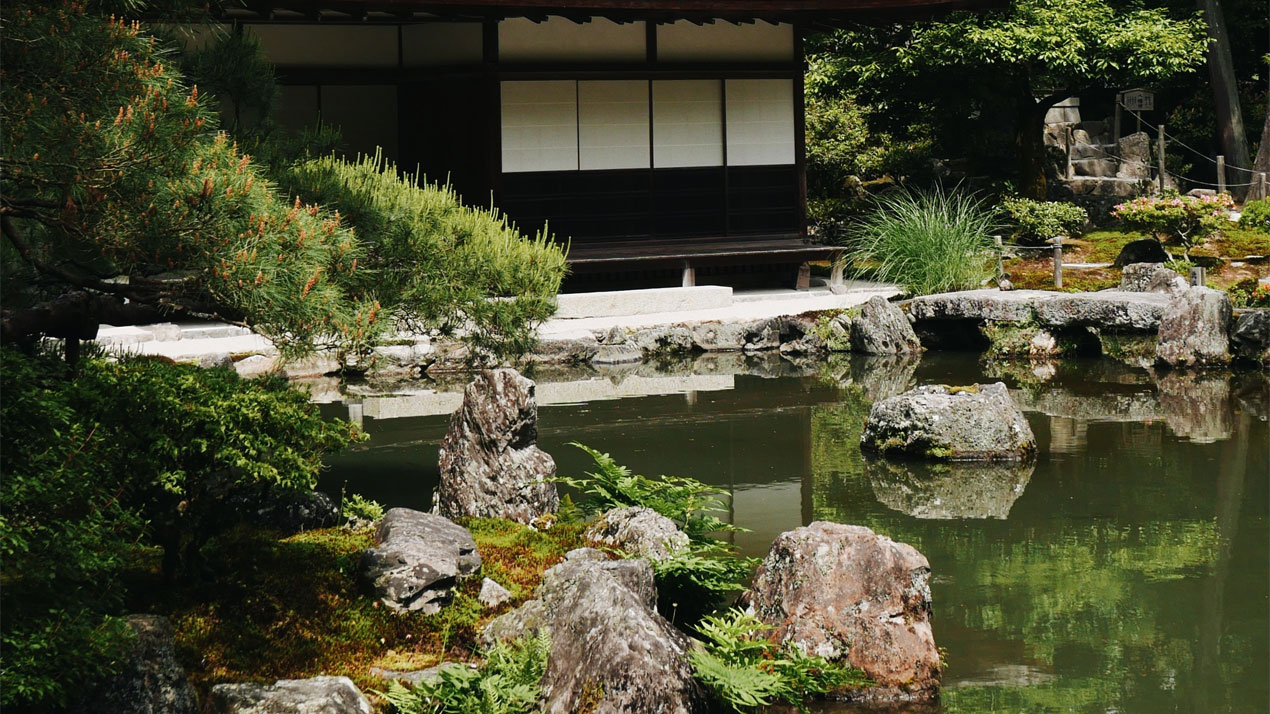
Waterfalls & Cascades
Waterfalls are another frequent feature in Japanese gardens. While the sound of falling water adds to the overall calming ambiance of the garden, waterfalls create a sense of movement and energy.
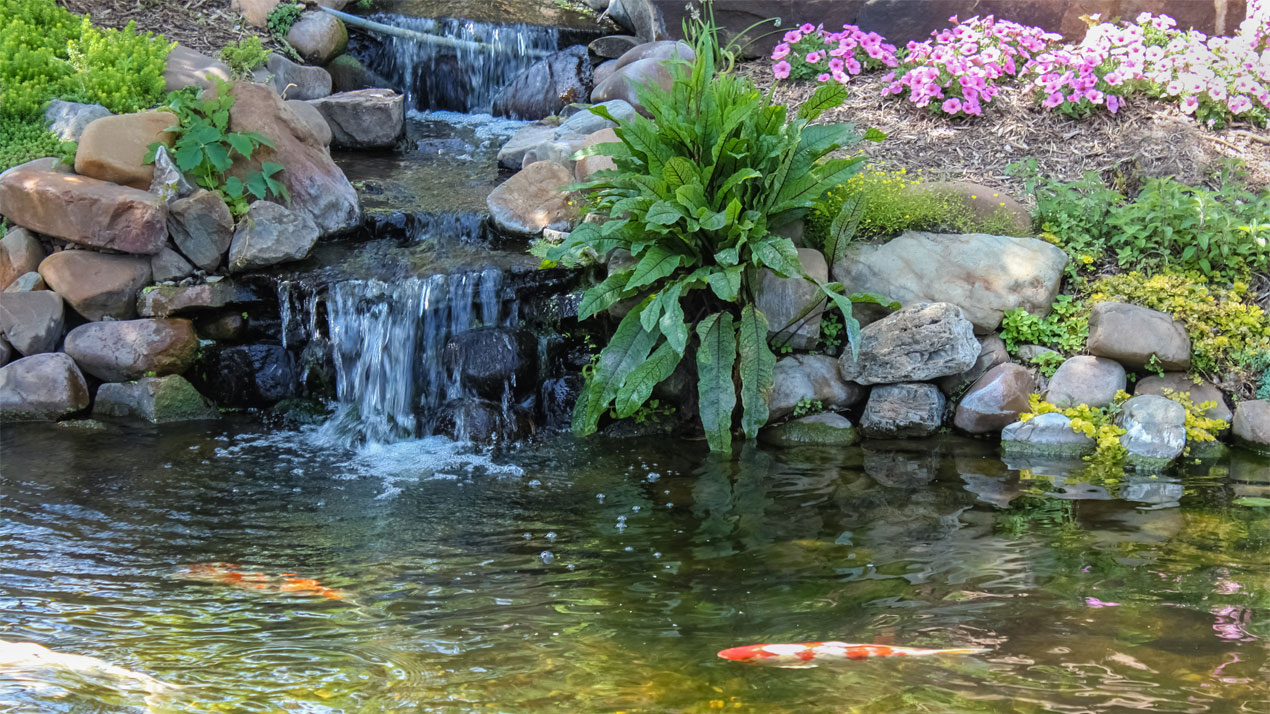
Stone Basins & Fountains
Smaller water features are designed to represent natural springs and are used for ritual purification before entering a temple or tea house. There are different types of stone basins or fountains that are typically found in Japanese gardens:
Tsukubai & Chozubachi
A tsukubai is a type of traditional Japanese stone water basin (chozubachi) with a pipe or fountain that is found in Japanese gardens, particularly in tea gardens (roji and used to clean one’s hand before the traditional tea ceremony. The term “tsukubai” consists of two parts: tsuku means “to bend down” or “to bow,” and hai means “basin”.
Tsukubai is an essential element of the tea ceremony (chanoyu), where it serves both a practical and symbolic purpose. It is used by guests to purify their hands and mouth before entering the tearoom, which is an act of cleansing and preparing oneself for the spiritual and aesthetic experience of the tea ceremony.
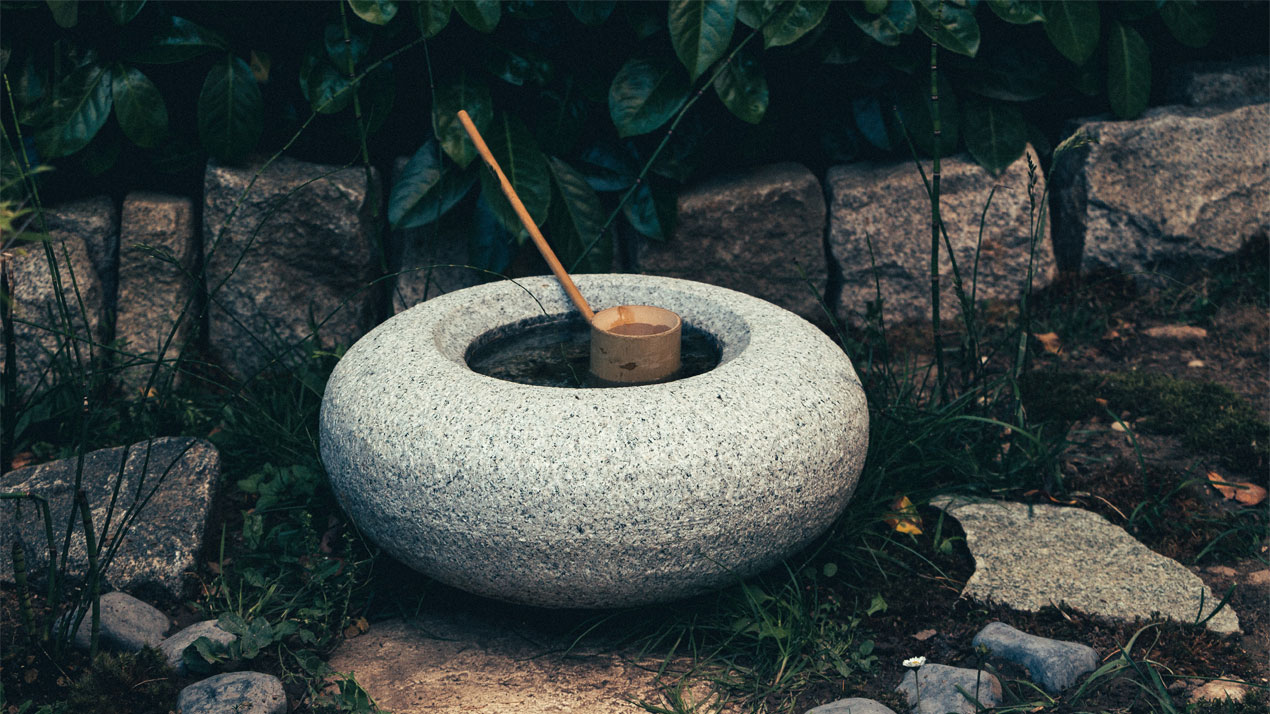
Testu Bachi
These donut-shaped water basin have a shallow bowl and are usually carved from granite. They provide a source of water for visitors to purify their hands before entering tea houses or contemplative spaces, symbolizing the importance of cleanliness and mindfulness.
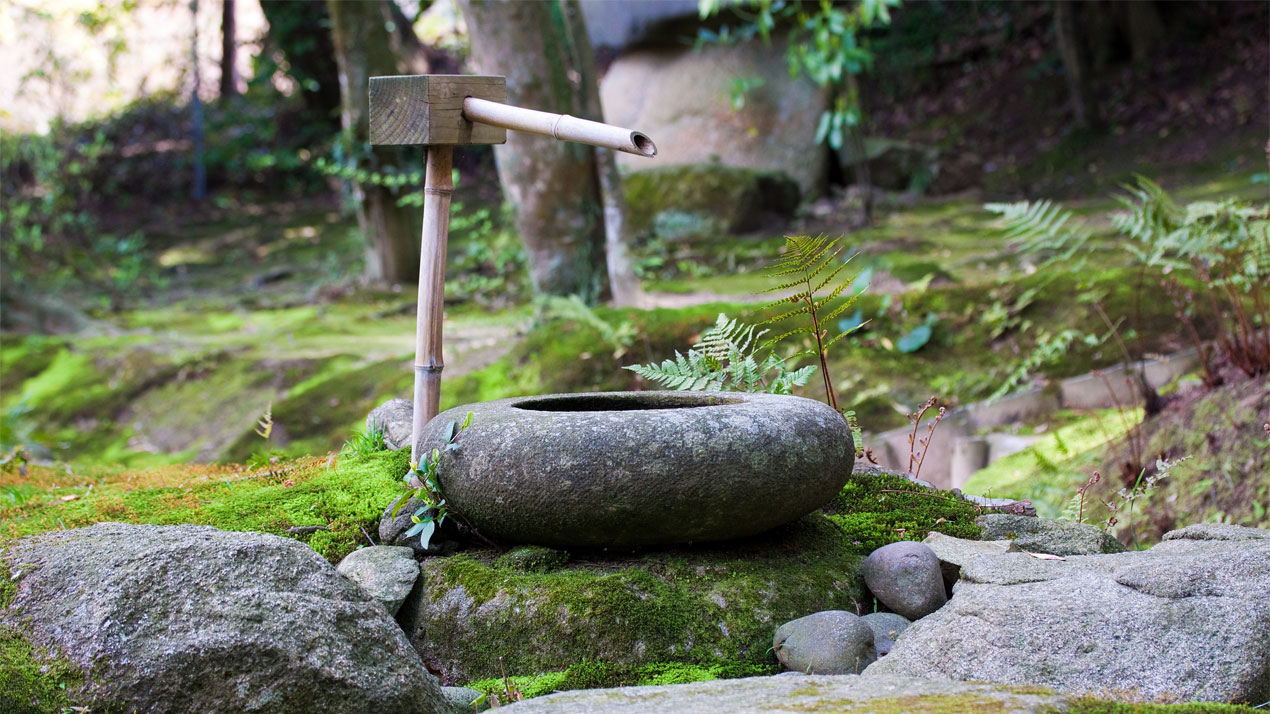
Teppatsugata
The Teppatsugata water basin is a prominent feature in Japanese gardens. It is a spherical-shaped stone basin used for ritual purification and symbolic cleansing before participating in tea ceremonies or other meditative practices. Water is scooped from the basin with a ladle, promoting mindfulness and tranquillity as visitors cleanse their hands, embodying the spirit of purity and respect.
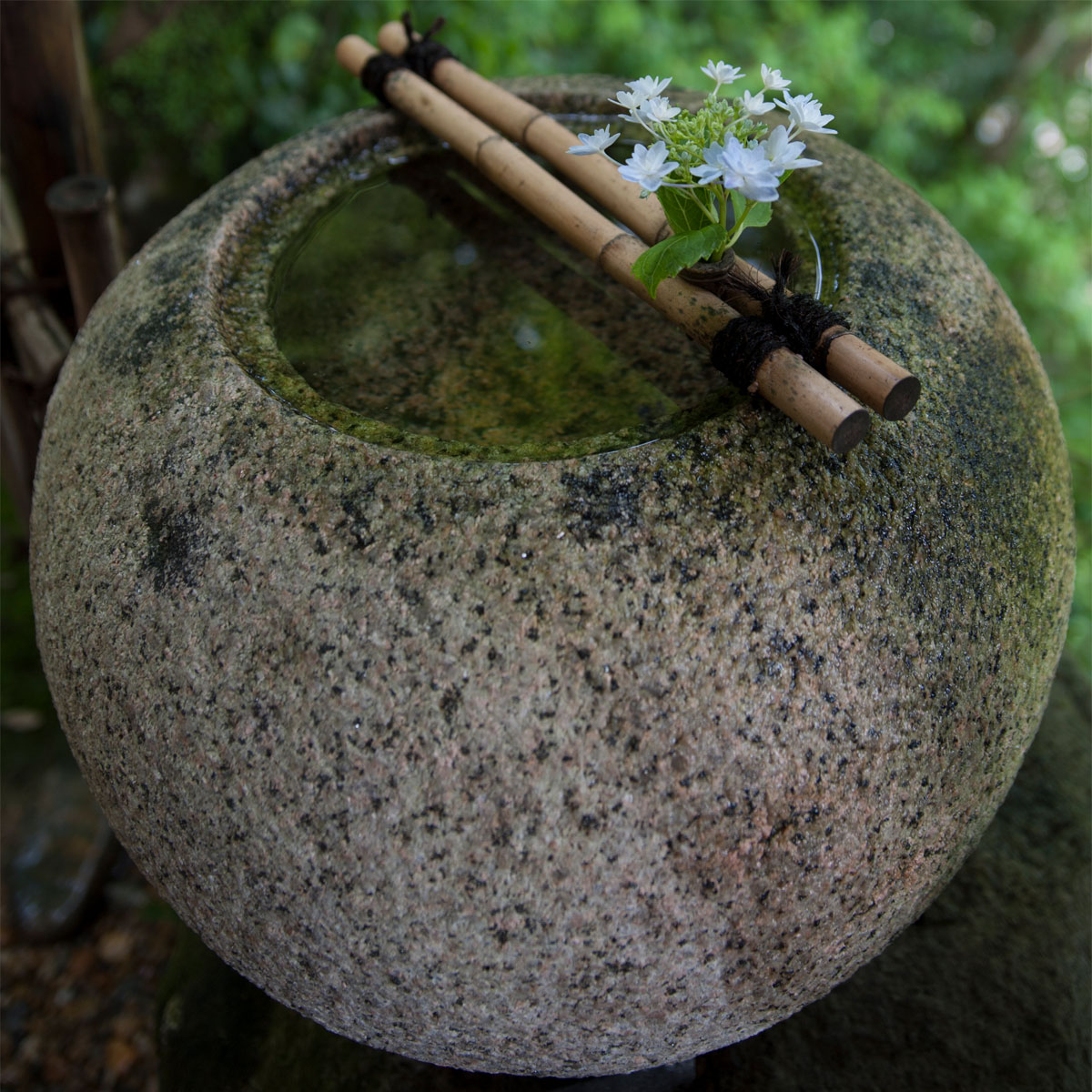
Natsu me bachi
The Natsu me bachi water basin is a characteristic feature in Japanese gardens, used for summer water rituals. It is a cylindrical stone basin with a shallow bowl near the top, allowing for the natural evaporation of water to keep it cool during hot summer days. Visitors use the basin to cleanse their hands, promoting a sense of refreshment and spiritual purification, while enjoying the serene ambiance of the garden.
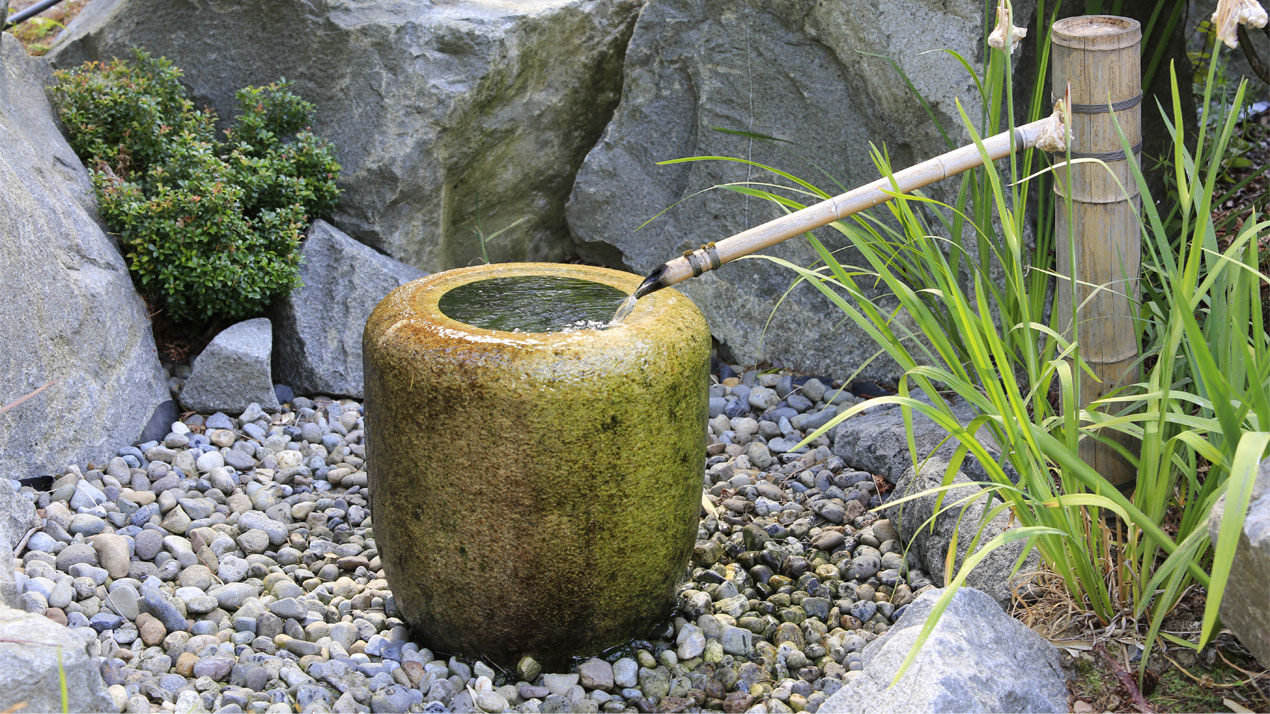
Zeni bachi
Zeni bachi, meaning “coin basin”, has the appearance of a traditional coin, with the characteristic square aperture in the middle which forms the basin. It consists of a stone basin with a slightly sloped surface where water drips slowly. Visitors toss small coins into the basin as a gesture of appreciation for the garden’s beauty and tranquillity. The gentle sound of dripping water adds to the garden’s peaceful atmosphere, creating a harmonious and meditative environment.
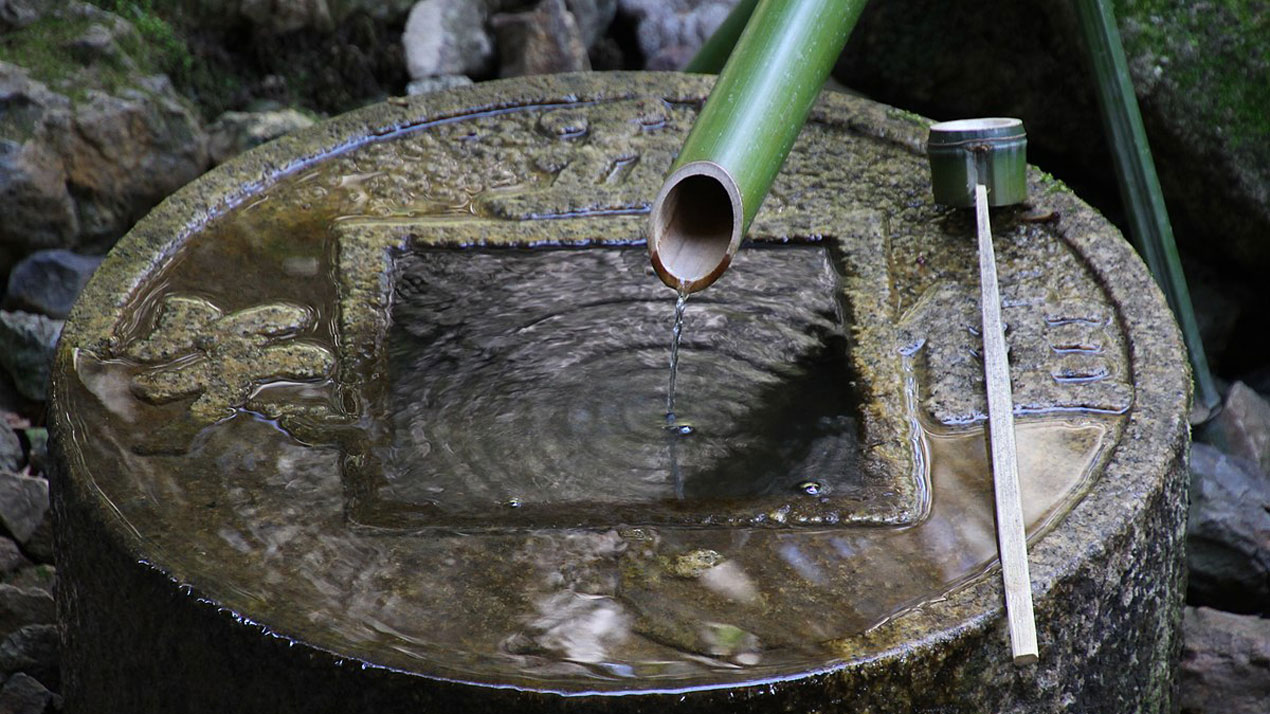
Kiku bachi
Kiku bachi, in Japanese gardens, refers to a chrysanthemum-shaped basin used for displaying and appreciating the beauty of chrysanthemum flowers. This unique stone basin often has petal-like grooves around the rim, resembling a chrysanthemum flower. It holds water for visitors to admire and rinse their hands, enhancing the seasonal charm and cultural significance of chrysanthemums in traditional Japanese garden design.
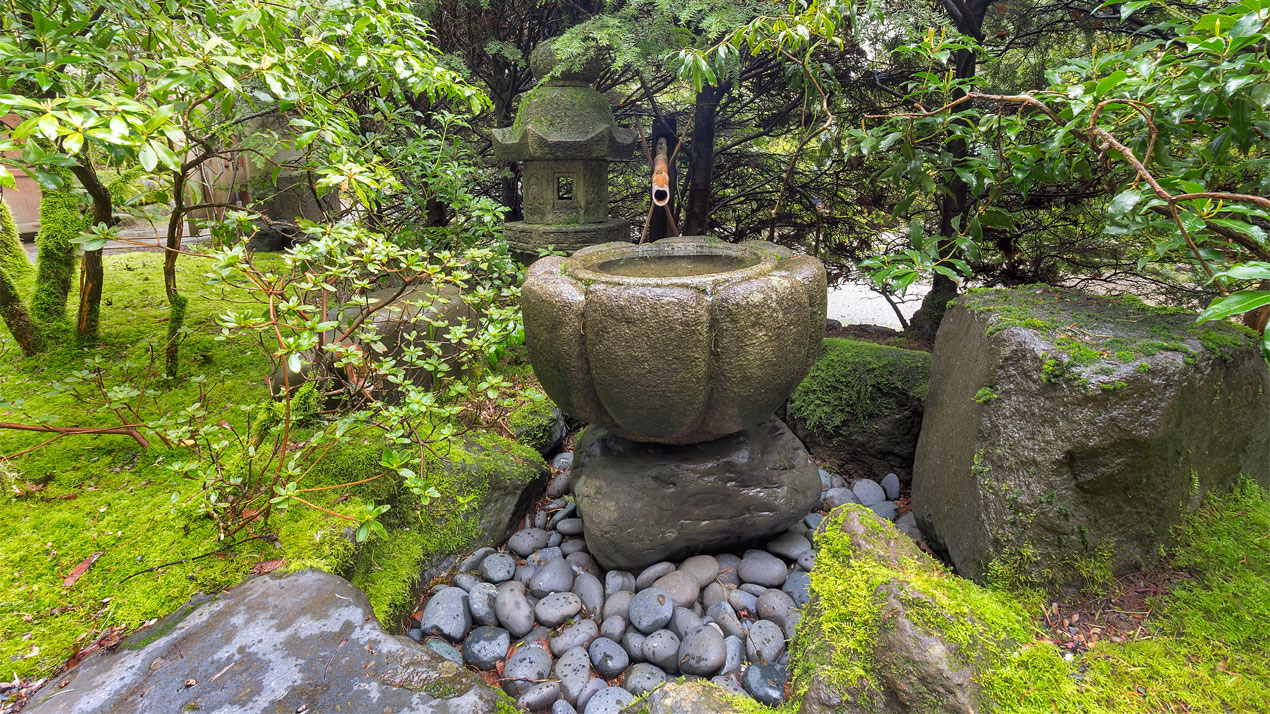
Ginkakuji
Ginkakuji tsukubai is a traditional stone water basin named after the Japanese gardens of Ginkakuji, the Silver Pavilion. The tsukubai has a low, square design with carved side facings and a bamboo ladle for scooping water. Visitors use it for purifying their hands before entering the temple, symbolizing cleansing and mindfulness. The basin’s simple yet artistic form complements the serene atmosphere of the gardens.
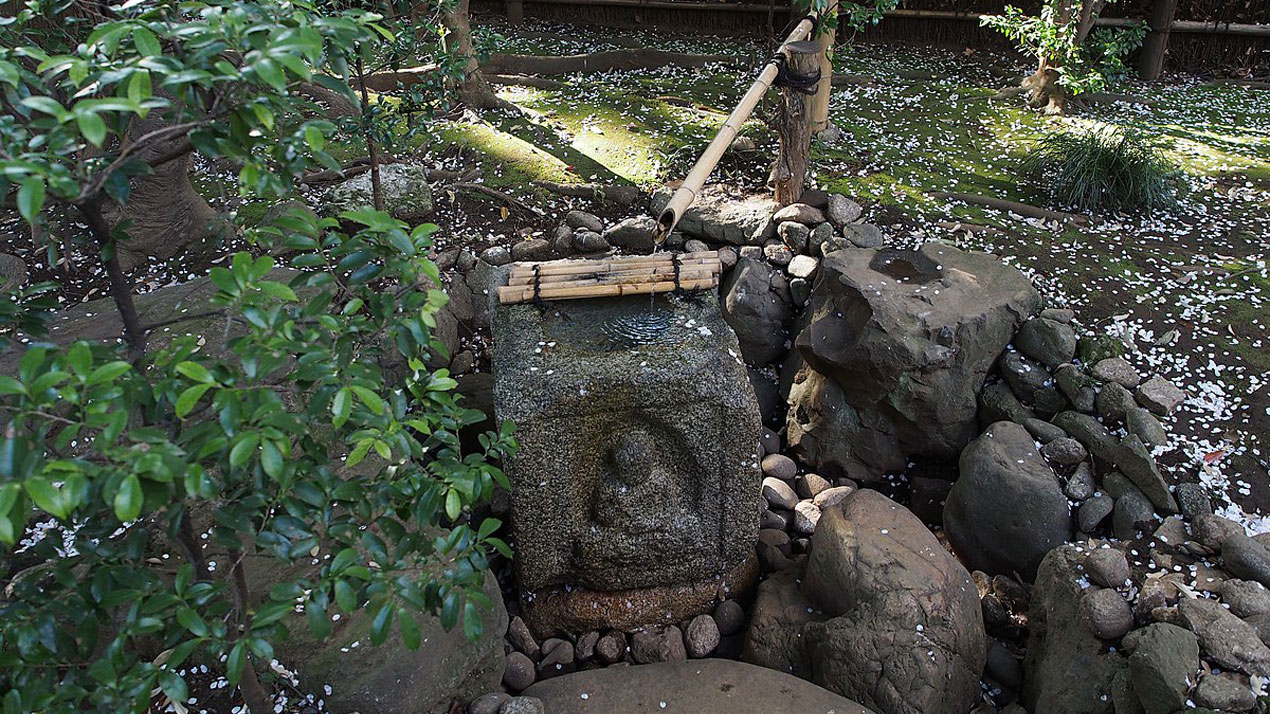
Plants
Four Elements of Japanese Gardens
Specific plants are key to Japanese gardens as they are meticulously chosen and arranged to evoke natural beauty and tranquillity, with elements like cherry blossoms, pine trees, and moss symbolizing various aesthetic and philosophical concepts.
They are usually chosen for their appearance and symbolic qualities to create a harmonious and balanced composition that reflects the natural world in a stylized way. The way the plants are arranged is crucial to accentuate balance and harmony between different elements of the garden.
The most commonly used plants in Japanese gardens are chrysanthemum (their national flower), moss, bamboo, Japanese maple, azaleas, cherry blossoms, and various evergreens. These plants are often pruned and shaped to create a specific aesthetic, such as the tightly clipped shrubs in a traditional Japanese garden.
Chrysanthemum
Chrysanthemum (the national flower of Japan), are an iconic flower of Japanese gardens, symbolizing longevity & rejuvenation. Meticulously pruned & displayed in vibrant hues, reflecting elegance & harmony amidst nature’s serene beauty.
Chrysanthemums enjoy a warm, sunny, sheltered spot, with fertile, well-drained soil. Water and feed regularly, and protect them from frost.
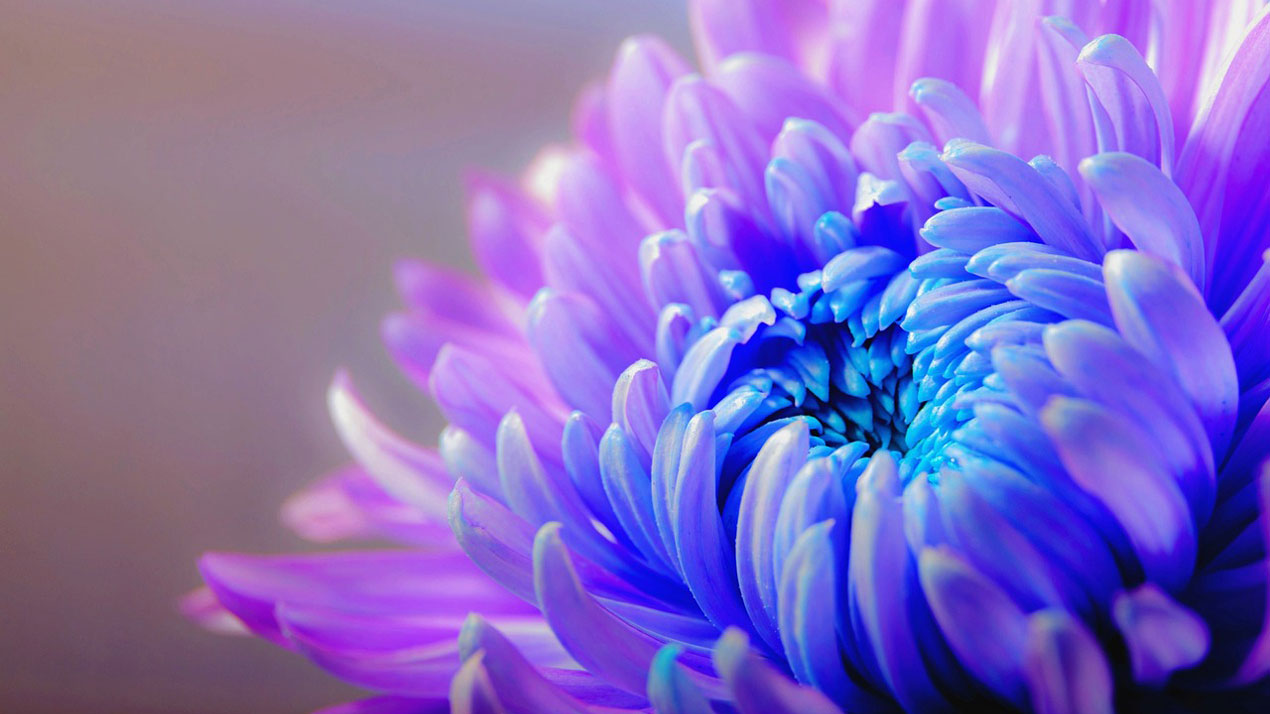
Moss
Moss is a subtle and lush ground cover in Japanese gardens, creating a velvety green carpet. Embodying simplicity, tranquillity, and ancient aesthetics, adding a sense of ageless charm to the landscape.
Moss likes damp conditions and eschews strong direct sunlight. It can be cultivated in specific spots on hard or compact surfaces (that have decent moisture level) using a “moss milkshake” blending moss with yogurt or beer, which can then be painted on to where you want to establish the moss.

Japanese Maple
Graceful and vibrant, Japanese maple’s delicate leaves create a mesmerizing blend of crimson and gold. Adorned in tranquil Japanese gardens, it evokes serenity and beauty.
Japanese Maple’s characteristic colouring is obviously intrinsically links to autumn and the changing seasons. This emphasis on change and the natural progression and inevitability of time is a central philosophical theme underpinning Japanese garden design.
Japanese Maples thrive in partial shade to protect their delicate leaves from scorching sun, though some morning sun is beneficial. They require well-draining, slightly acidic soil, kept consistently moist but not waterlogged. Mulching and protection from strong winds are crucial to maintain their elegant, vibrant foliage and graceful form.
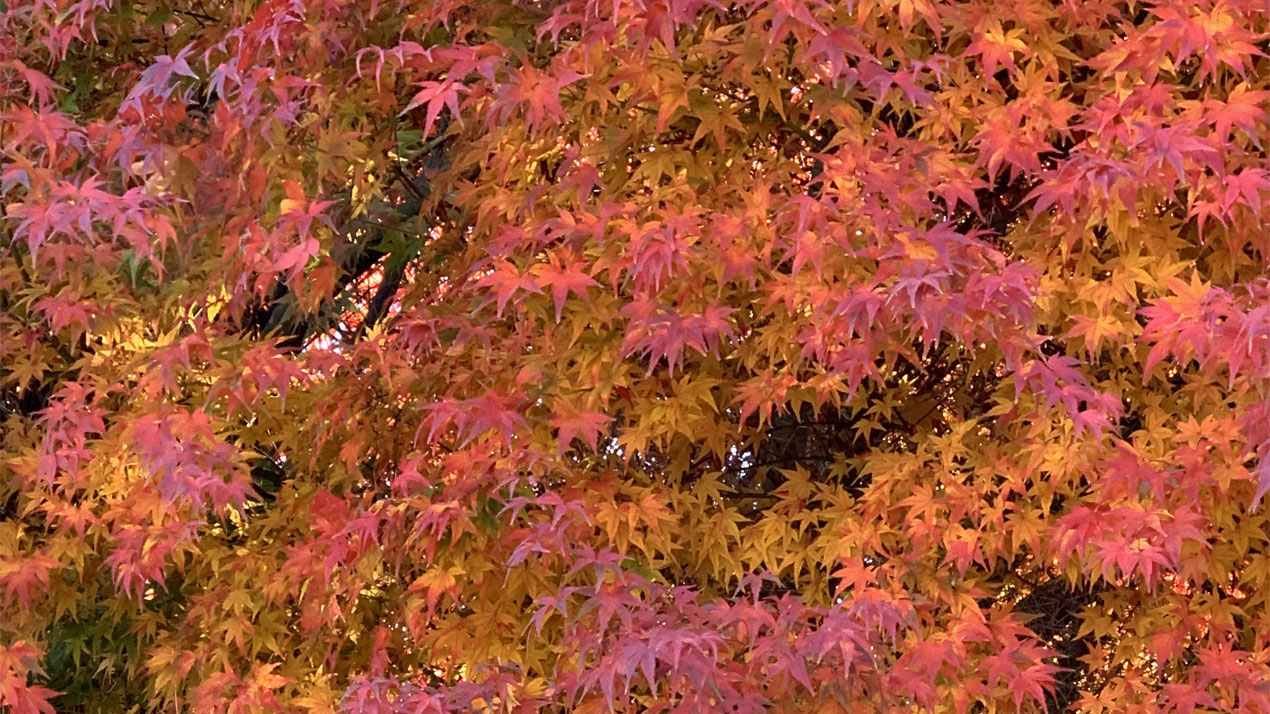
Azalea
Symbolizing passion and elegance, azalea enhances the natural splendour of the landscape. Bursting with colour, its blossoms paint the Japanese gardens with hues of pink, red, and white.
Azaleas flourish in filtered sunlight or partial shade to shield them from harsh sun. They demand well-draining, acidic soil, consistently moist but not waterlogged. Mulching and shelter from strong winds are essential for nurturing their stunning blooms and compact growth.
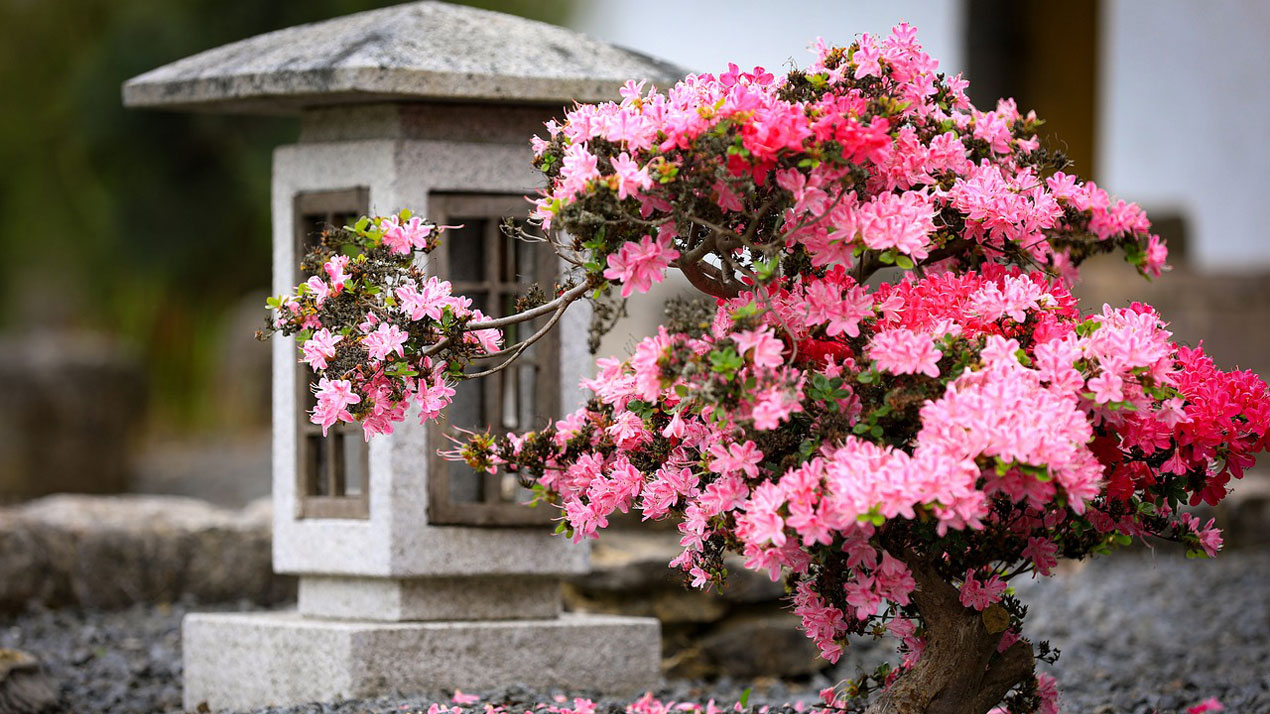
Japanese Black Pine
This evergreen tree (Pinus thunbergii) is often used to create a sense of depth and perspective in a Japanese garden. Its twisted and gnarled branches can be shaped and pruned to create unique, sculptural forms.
Japanese Black Pine thrives in full sun, well-draining sandy soil, and tolerates coastal conditions. It requires minimal water once established and benefits from pruning to shape its unique, rugged form and enhance its dense, dark green needles.

Japanese Iris
The Japanese Iris (Iris ensata) is a stunning flowering plant that is often used to create a sense of tranquillity and calmness in a Japanese garden. Its elegant blooms come in a variety of colours, including white, pink, and blue.
Japanese Irises flourish in full sun to light shade, ideally in consistently moist soil or shallow water, mimicking their natural marshy habitats. Regular fertilization, well-spaced planting, and protection from strong winds promote their vibrant, intricate blossoms and sturdy growth.
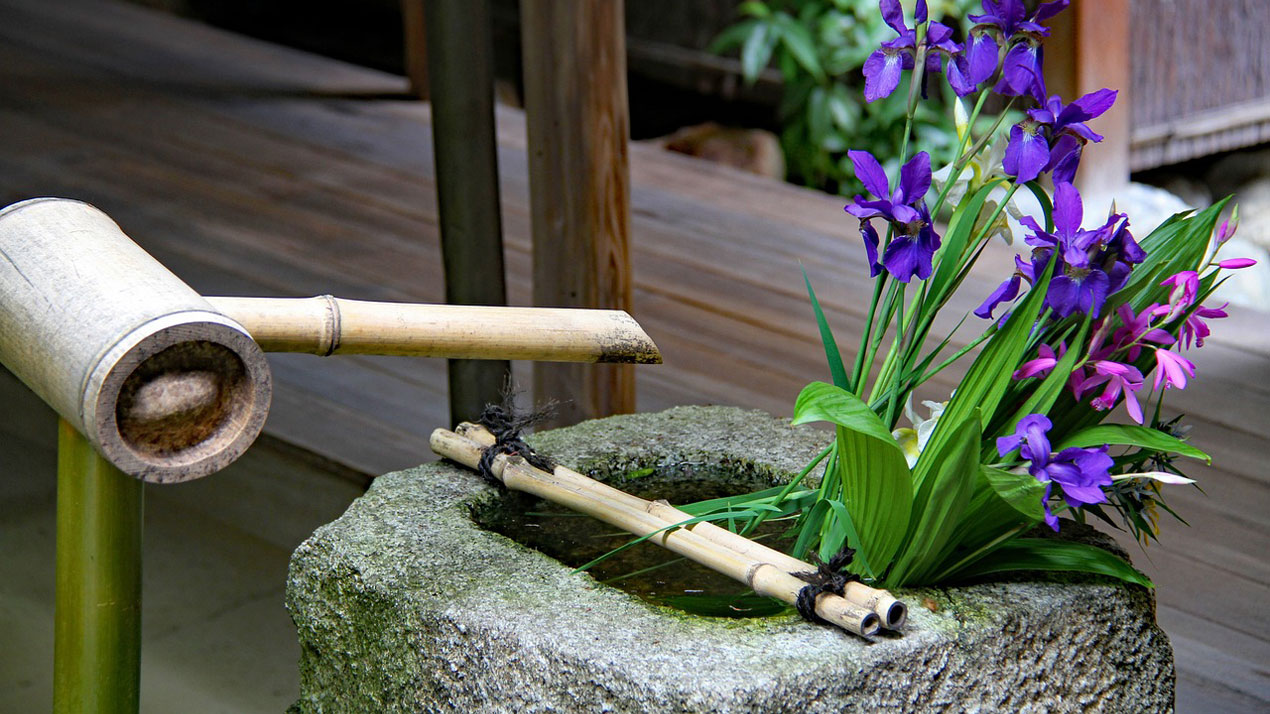
Cherry Blossoms
Cherry Blossoms, or Sakura, grace serene Japanese gardens with delicate petals, painting landscapes in hues of pink and white, evoking beauty, transience, and cultural significance.
Cherry Blossoms (Prunus spp.) thrive in full sunlight, well-draining soil with good organic content. They require a cold dormant period for optimal flowering. Adequate spacing, proper pruning, and protection from strong winds help nurture their iconic, ephemeral pink or white blooms.
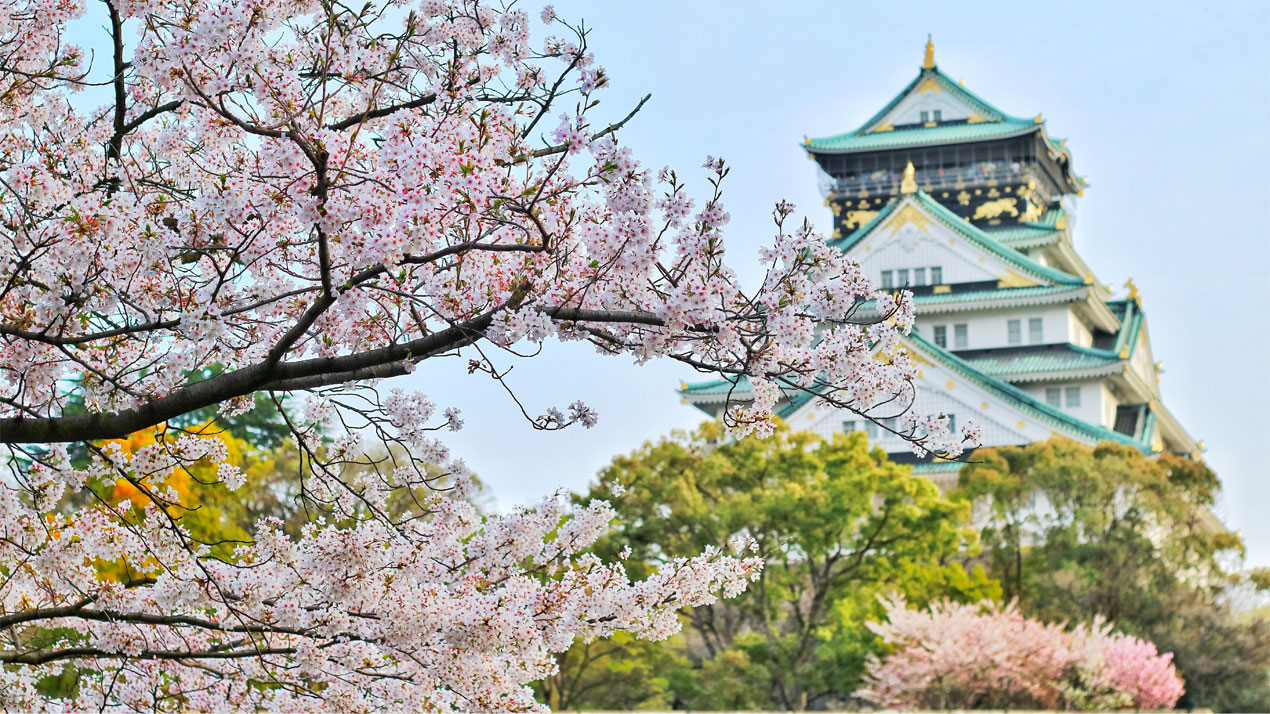
Japanese Cobra Lily
Japanese Cobra Lily (Arisaema ringens) holds cultural and historical importance in Japanese gardens, symbolizing mystery and uniqueness. Its distinctive hooded spathe resembles a cobra, evoking intrigue. Revered for its intriguing form, it complements the aesthetic of Japanese gardens, embodying their appreciation for nature’s beauty and subtle symbolism.
Japanese Cobra Lily thrives in partial to full shade, enriched, well-draining soil. Consistent moisture is vital during its growing season, while a dry dormant period in winter is essential. Mimicking its forest habitat ensures healthy growth and accentuates its role as an enchanting focal point in a Japanese garden.
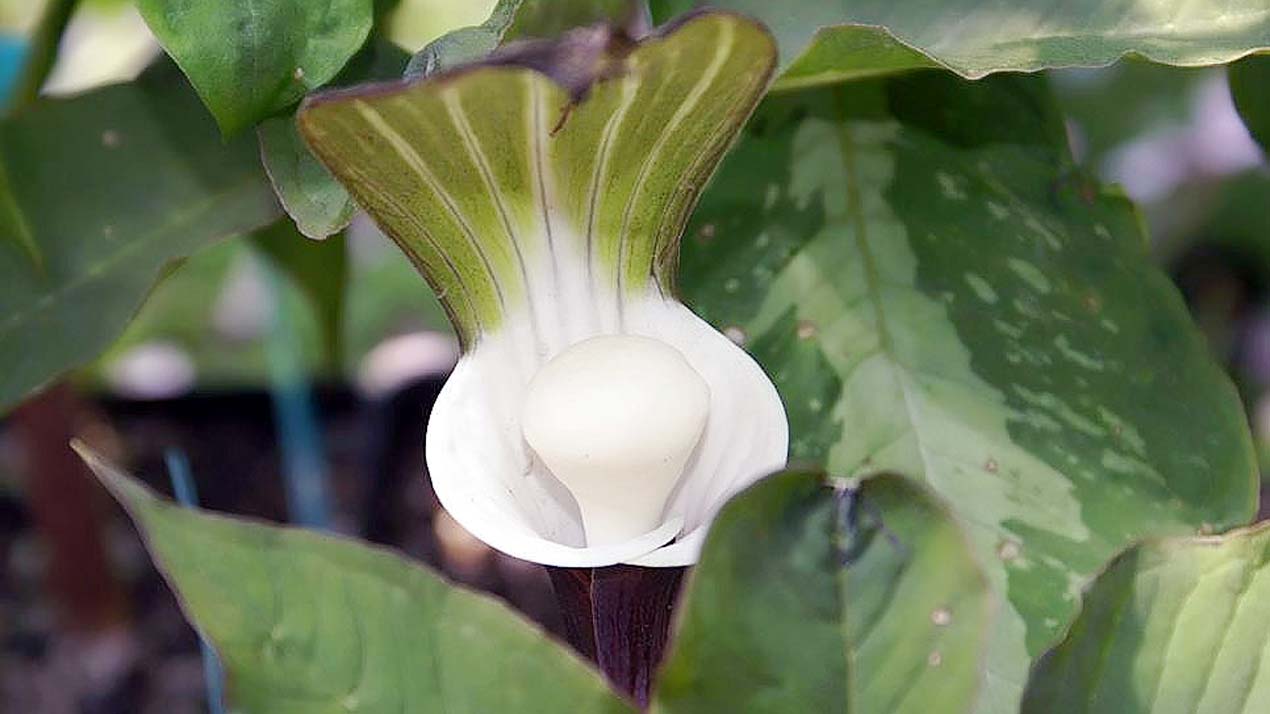
Japanese Quince
Japanese Quince (Chaenomeles japonica) brings timeless charm to Japanese gardens, embodying delicate strength. Its vibrant blossoms symbolize beauty and fortitude, echoing Japanese values. As an enduring presence in traditional gardens, it harmonizes with nature’s balance, offering an exquisite spectacle.
Preferring well-drained soil and partial sunlight, Japanese Quince flourishes with occasional pruning. Its hardy nature and captivating blooms make it a fitting addition to the tranquillity of a Japanese garden.
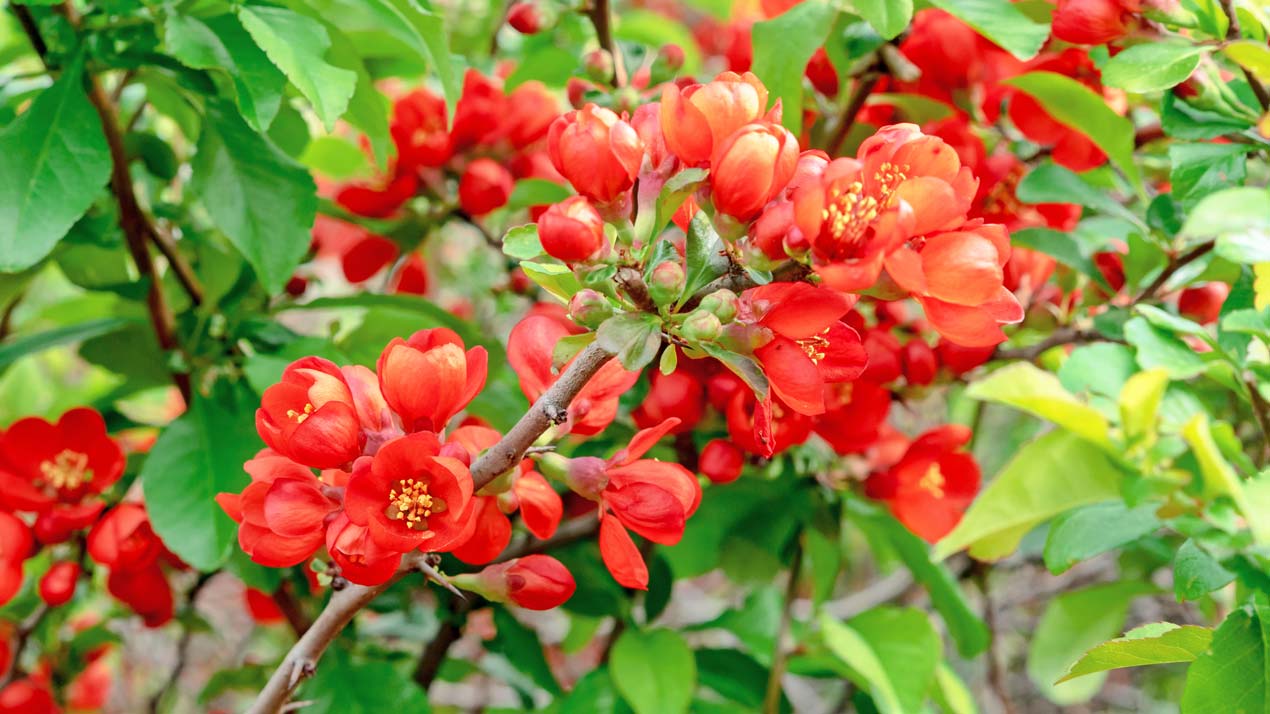
Hakonechloa Macra
Hakonechloa macra, known as Japanese Forest Grass, graces Japanese gardens with its flowing elegance. Symbolizing tranquillity, it mirrors the swaying grasses of natural landscapes, reflecting Zen philosophies. Its vibrant hues and graceful movement evoke a sense of harmony, enriching the garden’s aesthetics and embodying the essence of Japan’s serene beauty.
Does well in dappled shade and well-draining, humus-rich soil, Hakonechloa macra requires consistent moisture. Its low maintenance needs make it an excellent ground cover or border plant, contributing to the garden’s serenity with its calming presence.
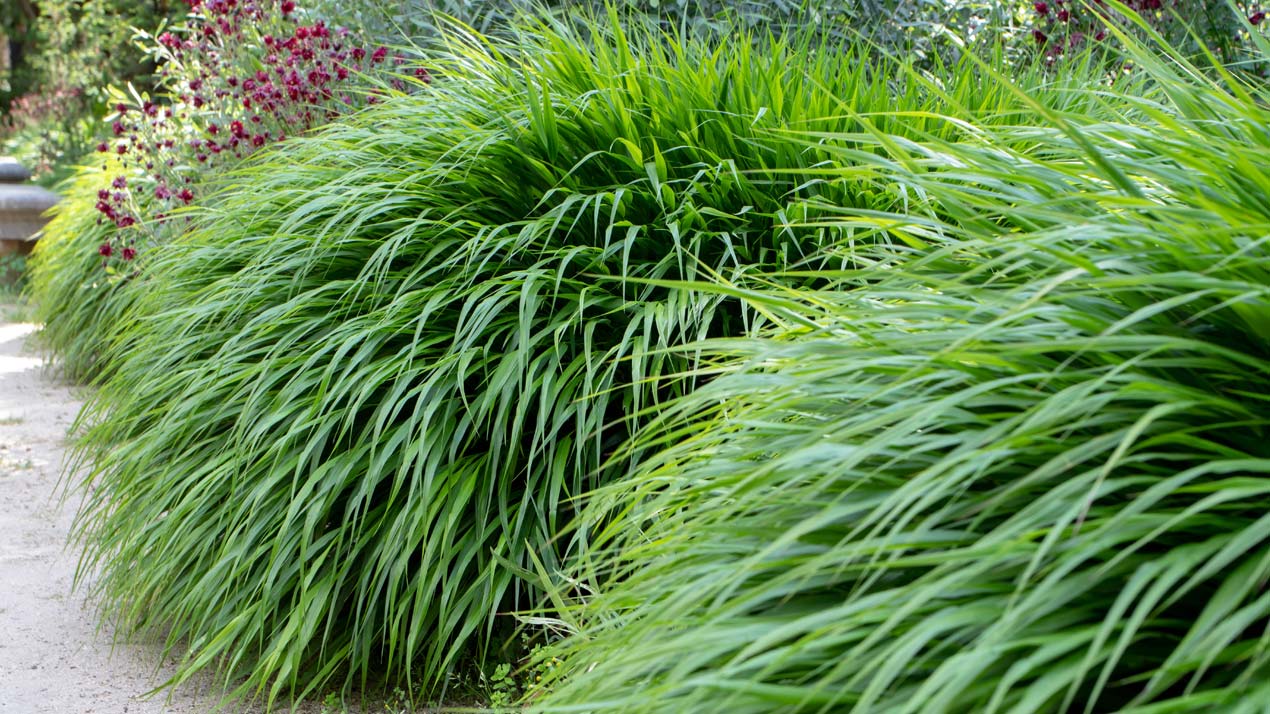
Mugo Pine (Pinus Mugo)
Pinus mugo, or Mugo Pine, finds its place in Japanese gardens as a symbol of rugged resilience. Embodying the beauty of endurance, it echoes Japanese philosophies of adapting to nature’s challenges. Its twisted form and dense foliage impart an air of ancient wisdom, complementing the garden’s harmonious aesthetics.
Burgeoning in well-draining soil and full sun, Mugo Pine prefers minimal pruning to preserve its unique character. Its hardy nature and distinct shape contribute to the garden’s authenticity, embodying the spirit of resilience amidst the serenity of a Japanese landscape.
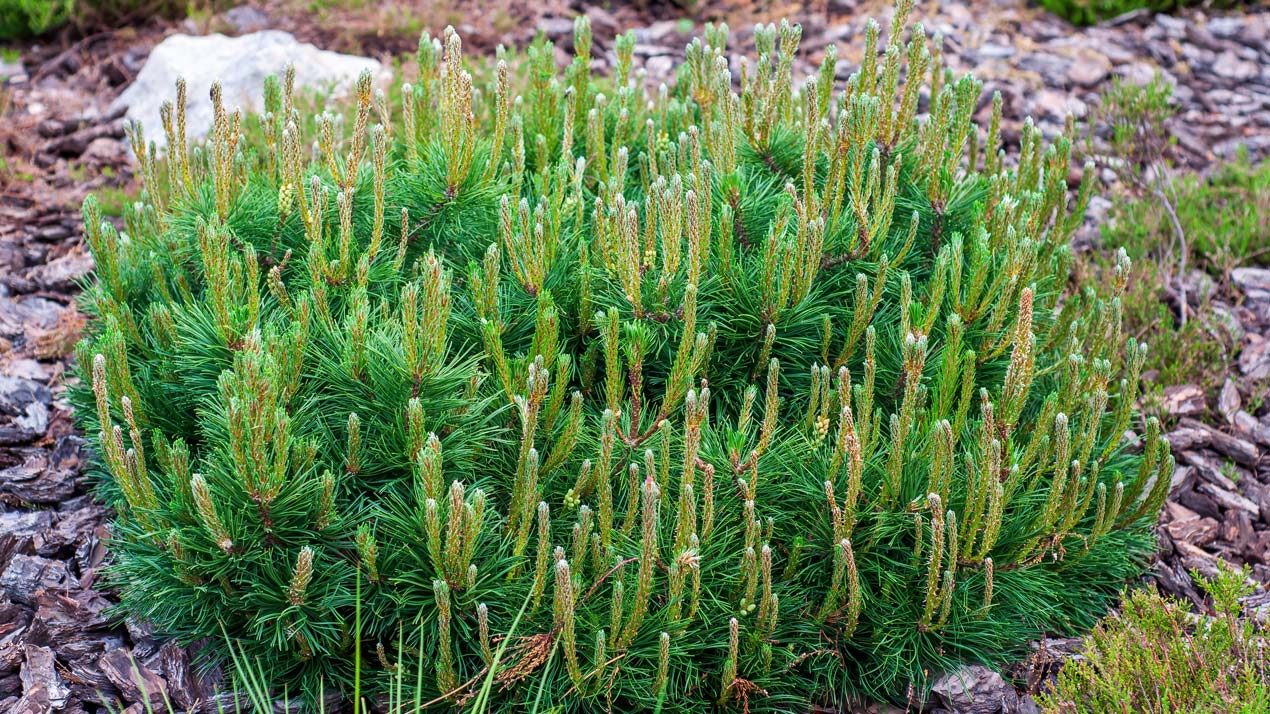
Black Bamboo
Black Bamboo (Phyllostachys nigra) entwines history and aesthetics in Japanese gardens, symbolizing strength through flexibility. Revered for its elegance and versatility, it embodies bamboo’s significance in Japanese culture. Its tall, graceful culms provide vertical interest, while its deep hue adds contrast and depth to the garden’s design, evoking harmony.
Flourishing in well-draining soil with occasional organic mulch, Black Bamboo prefers filtered sunlight to partial shade. Its moisture needs are moderate, requiring consistent watering but avoiding waterlogged conditions. Its adaptability and striking appearance make it a dynamic choice for creating an authentic and harmonious Japanese garden ambiance.
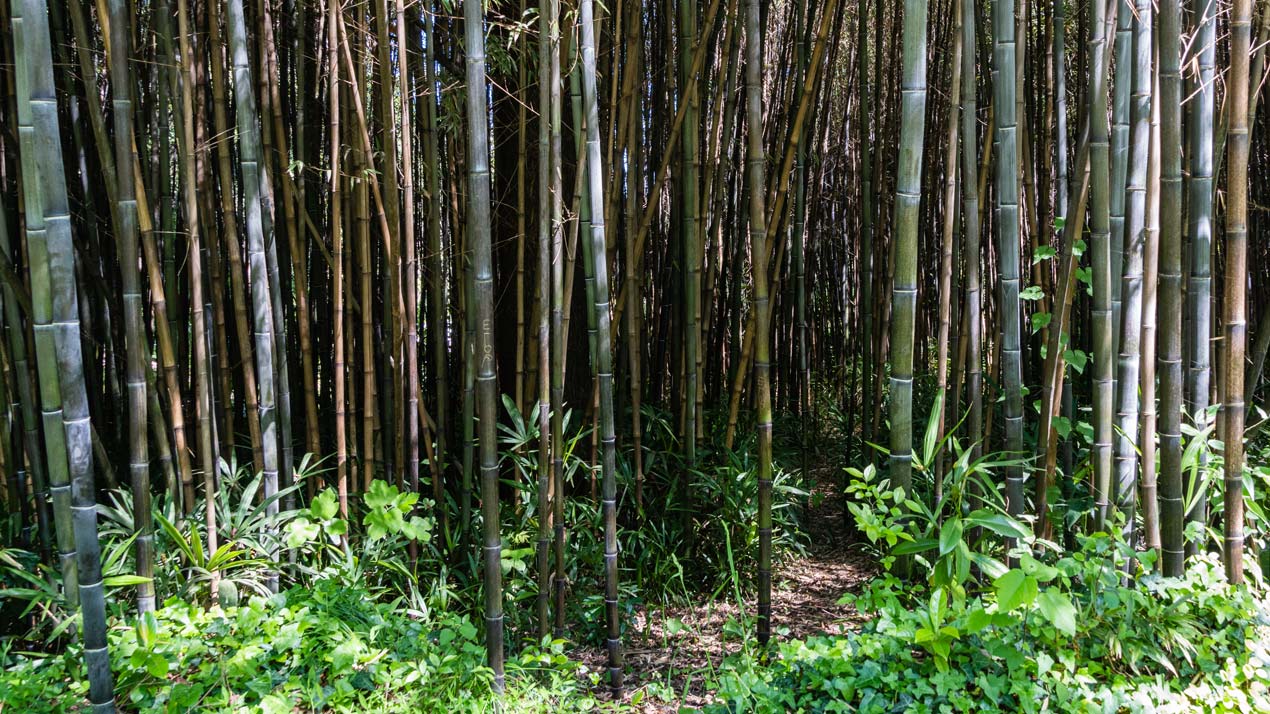
Camellia Japonica
Camellia japonica, a revered presence in Japanese gardens, encapsulates grace and refinement. With deep cultural ties, it symbolizes purity and a life of balance. Its exquisite blossoms mirror the fleeting beauty celebrated in Japanese aesthetics, gracing the garden with elegance and timelessness.
Does well in partial shade and well-draining, acidic soil, Camellia japonica flourishes in a sheltered spot protected from harsh winds. Consistent moisture and organic mulch support its growth. Its vibrant blooms and cultural significance make it an integral part of an authentic and contemplative Japanese garden.
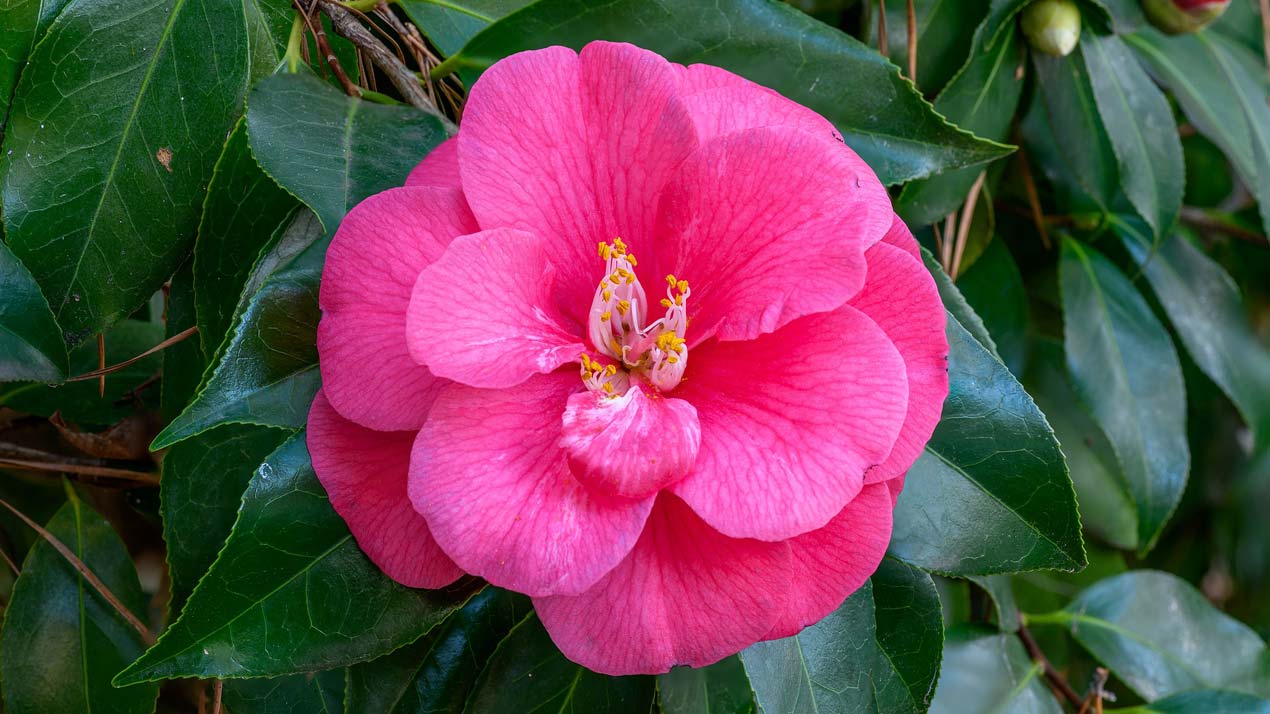
Japanese Anemone (Eriocapitella hupehensis)
Japanese Anemone (Eriocapitella hupehensis), or “nadeshiko,” graces Japanese gardens with its serene beauty. Revered for centuries, it symbolizes love, purity, and enduring grace. These elegant blooms evoke a sense of balance and harmony, embodying the essence of Japanese garden aesthetics and capturing the admiration of all who behold them.
Japanese Anemone does well in partially shaded areas with moist, well-drained soil. Its delicate charm, showcased in shades of white and pink, harmonizes with other garden elements. Plant in early spring or fall for best results. This perennial gem adds timeless allure to Japanese-inspired landscapes.
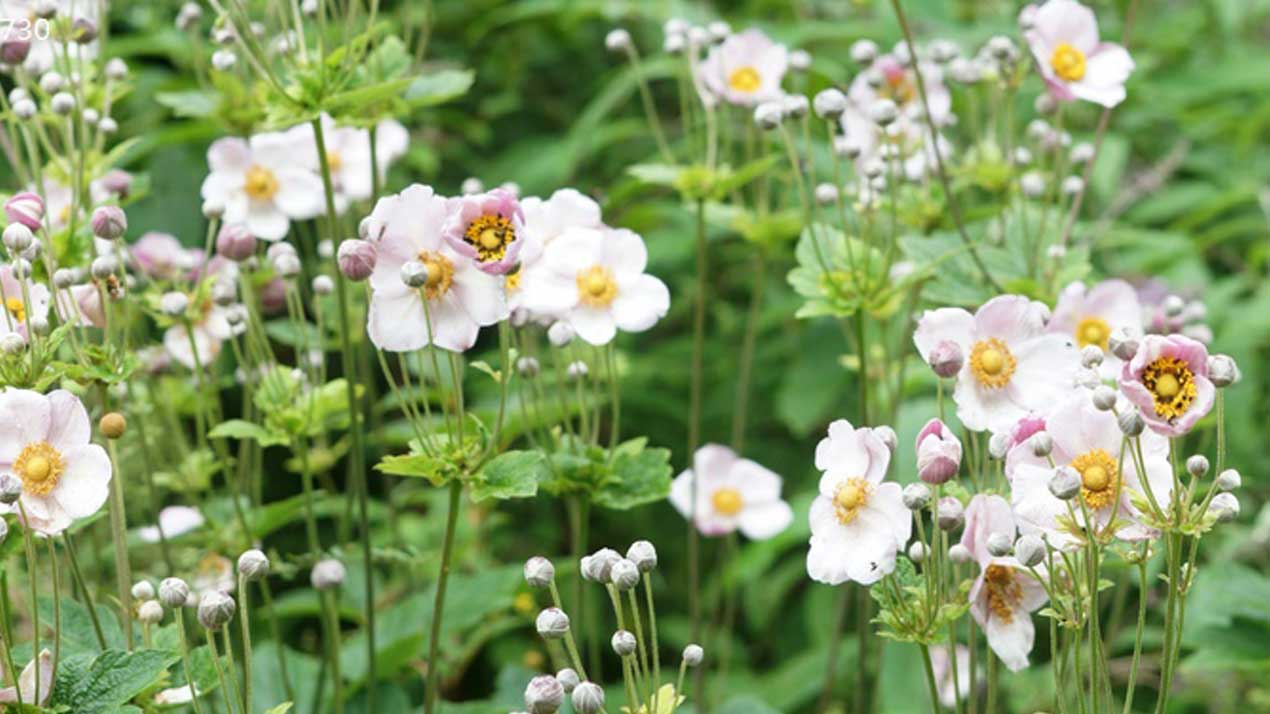
Japanese Wisteria
Wisteria floribunda, an emblem of romance and transience, embellishes Japanese gardens with cascading beauty. Symbolizing love and endurance, it intertwines with historical tales and artistic inspirations. Its enchanting blooms evoke hanami, the cherished tradition of appreciating fleeting cherry blossoms, adding a sense of ethereal allure to serene landscapes.
Loves full sun with well-draining soil, Wisteria floribunda flourishes in temperate climates. Regular pruning promotes its cascading growth and abundant flowering. Its allure and cultural symbolism make it a captivating element, evoking emotions of beauty, passage, and the ever-changing nature of existence within a Japanese garden.
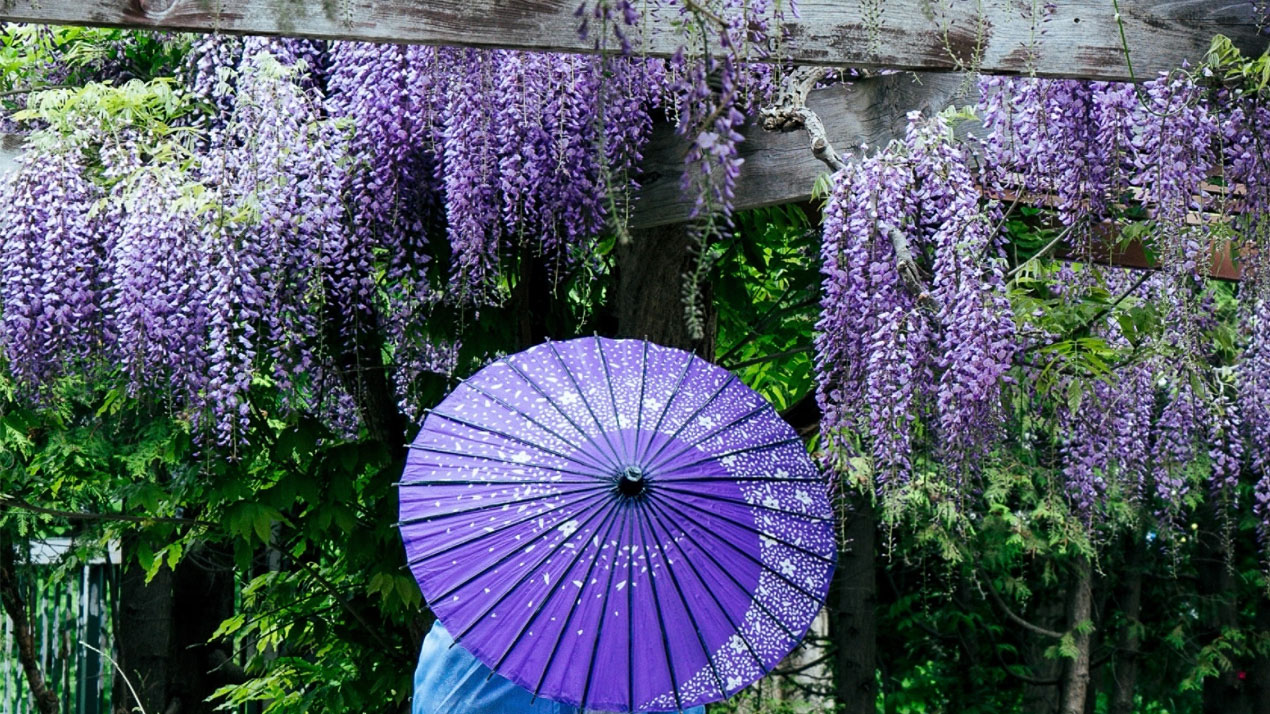
Bamboo (Fargesia and Phyllostachys)
Bamboo, represented by varieties like Fargesia and Phyllostachys, is a quintessential element in Japanese gardens, embodying resilience and versatility. Revered for centuries, it symbolizes strength through flexibility and exemplifies bamboo’s integral role in Japanese culture, from art to construction. Its soothing rustle and graceful sway evoke harmony.
Suited to well-drained soil and partial sunlight, Bamboo forms provide vertical and textural interest. Regular watering sustains growth. Their rapid growth and diverse forms make them ideal for screens, borders, or focal points, adding a sense of vitality and authenticity to the tranquil ambiance of a Japanese garden.
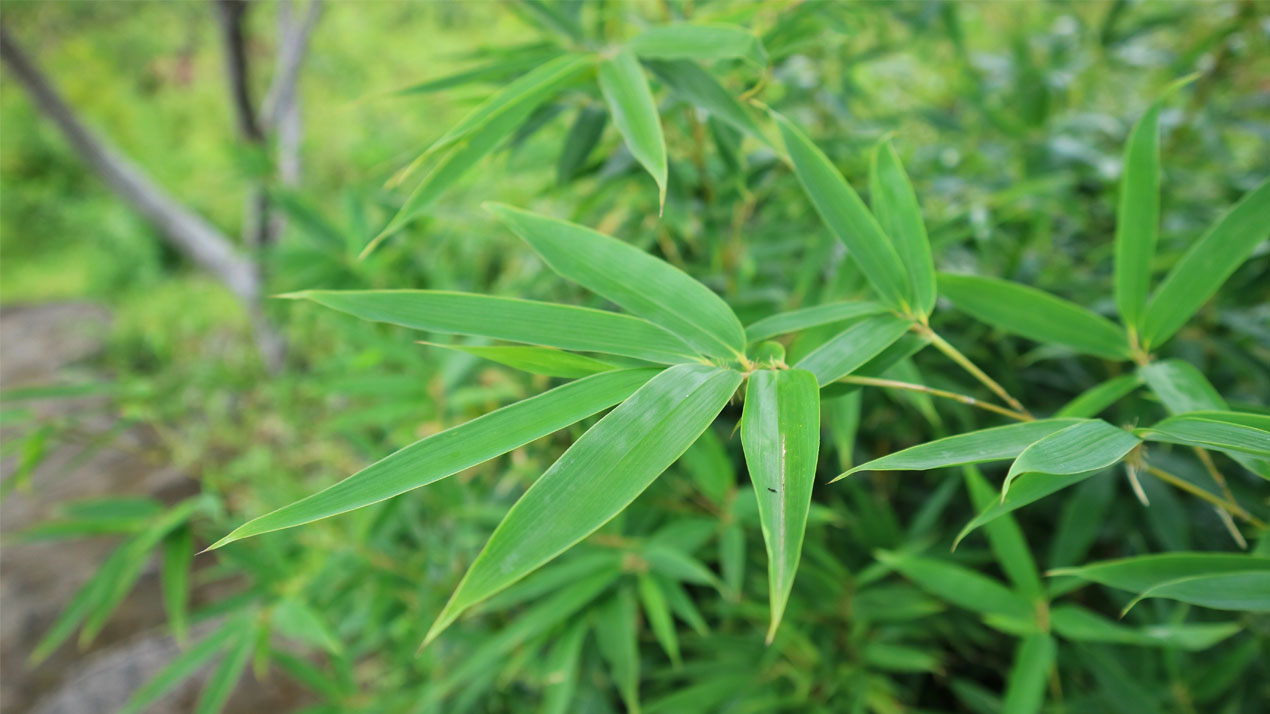
Hydrangeas
Hydrangeas, a symbol of heartfelt emotions, grace Japanese gardens with their vibrant blooms. Evoking nostalgia and gratitude, they’re cherished in cultural festivals and art, representing change and impermanence. Their lush clusters harmonize with the garden’s rhythm, adding colour and depth to the serene landscape.
Thriving in partial shade and well-drained soil, Hydrangeas benefit from consistent moisture. Their versatile nature and captivating flowers make them a cherished feature, embodying emotions and the evolving beauty of life within the contemplative realm of a Japanese garden.

Japanese Silver Grass (Miscanthus sinensis)
Japanese Silver Grass holds cultural and historical importance in Japanese gardens. Known as “susuki,” it symbolizes autumn’s grace and resilience. Its feathery plumes sway like gentle whispers, evoking tranquillity. This grass, admired for centuries, exemplifies the harmony between nature and design.
Japanese Silver Grass thrives in well-drained soil and full sun, though it tolerates light shade. With moderate water needs, it’s adaptable but prefers consistent moisture. Plant in spring or early fall. Its graceful presence complements water features and borders, making it an ideal choice for Japanese-inspired landscapes.
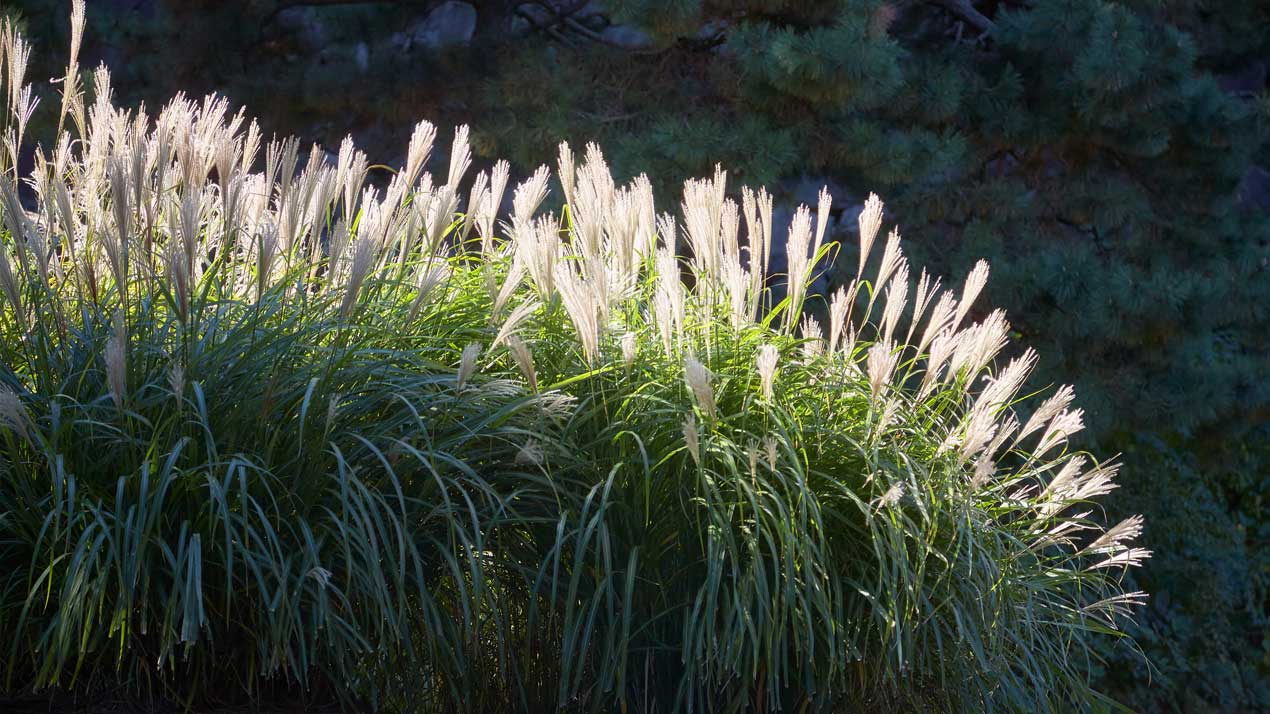
Enkianthus Campanulatus
Enkianthus campanulatus, gracing Japanese gardens, holds a special place as a symbol of grace and harmony. This native plant of Japanese woodlands is revered for its bell-shaped blossoms, it reflects the delicate beauty celebrated in Japanese aesthetics. Its presence echoes ancient garden philosophies, embodying the tranquillity and balance sought in these serene landscapes.
Thriving in partial shade to filtered sunlight and acidic, well-draining soil, Enkianthus campanulatus thrives in cool, temperate climates. Consistent moisture, mulching, and protection from strong winds nurture its growth. Its elegant form and cultural significance make it a cherished addition to the contemplative beauty of a Japanese garden.
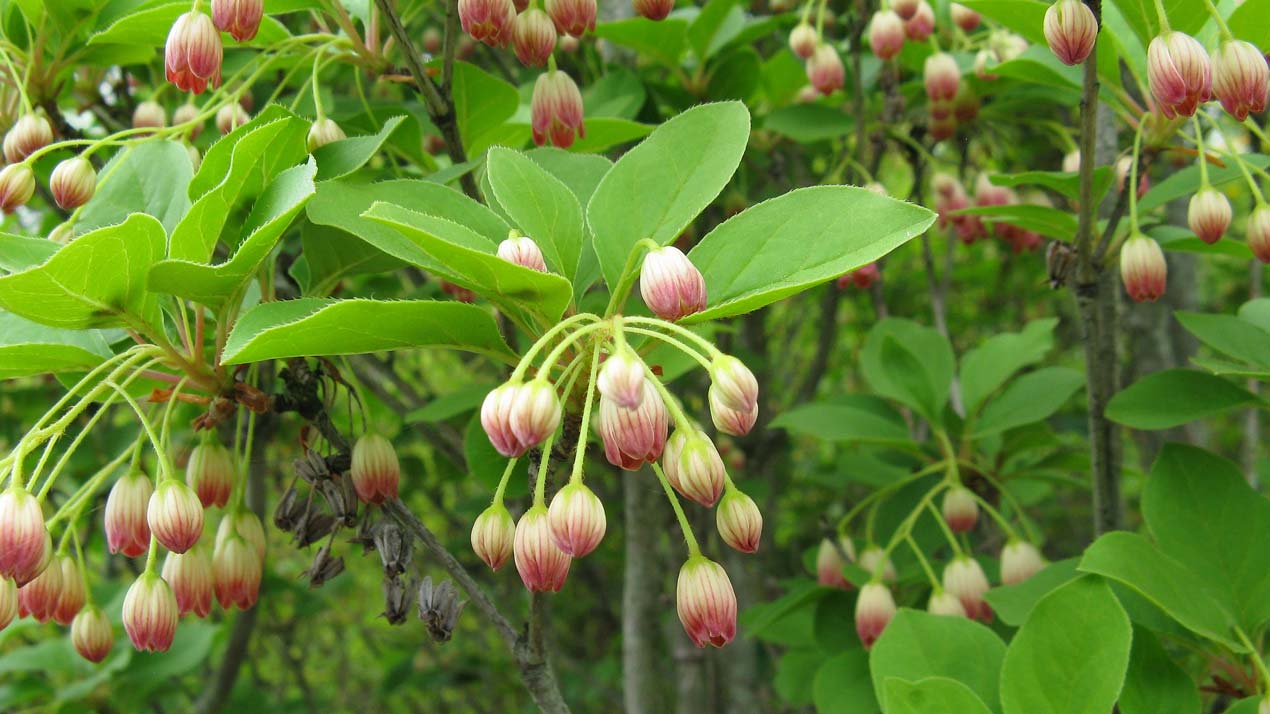
Man-Made Elements
Four Elements of Japanese Gardens
Man-made structures and objects in Japanese gardens play a vital role, shaping the landscape’s essence and symbolism. Lanterns, bridges, and pagodas aren’t mere adornments; they embody history, spirituality, and aesthetic balance. Rocks are deliberate expressions of nature’s spirit, while pathways guide meditative journeys. Every element reflects meticulous design, mirroring Zen philosophies and evoking tranquility. These structures integrate with nature, allowing contemplation, emphasizing impermanence, and inviting harmony. In Japanese gardens, human creativity collaborates with nature’s beauty, transcending time and imparting profound connections between people, culture, and the world around them.
Bridges
Bridges hold deep significance in Japanese garden design, originating from both practical and symbolic considerations. Historically, Japan’s landscapes featured water elements like ponds, streams, and rivers, necessitating the use of bridges for practical access and connectivity. Over time, these functional structures evolved into powerful symbols, reflecting cultural values and philosophies.
Bridges in Japanese gardens often symbolize the transition between different realms or states of being. Crossing a bridge can represent a journey from the mundane to the sacred, the ordinary to the spiritual, or even the passage from life to the afterlife. They encourage visitors to pause, reflect, and mentally transition as they move from one part of the garden to another, aligning with the Zen concept of mindfulness.
The design of Japanese bridges is carefully thought out, often incorporating natural materials like wood, stone, and bamboo to harmonize with the environment. Arched bridges, known as “taikobashi,” create reflections in the water below, enhancing the sense of unity between the physical and spiritual worlds. Zigzag bridges, or “yatsuhashi,” are designed with right-angle turns, intended to ward off evil spirits who can only move in straight lines.
Arched Bridges (Taikobashi)
Taikobashi bridges are iconic features in Japanese gardens, characterized by their gracefully arched design and strategic placement over ponds or streams. Rooted in Zen philosophy, they symbolize a transition from the mundane to the spiritual. These bridges are not merely functional, but also serve aesthetic and contemplative purposes. Crossing them encourages a meditative experience, offering different perspectives of the garden’s landscape. Taikobashi bridges embody the harmonious blend of nature and human creativity, inviting visitors to engage in a tranquil and introspective journey within the serene ambiance of the garden.
Usually constructed from wood, and often painted red, these bridges are synonymous with Japanese gardens.
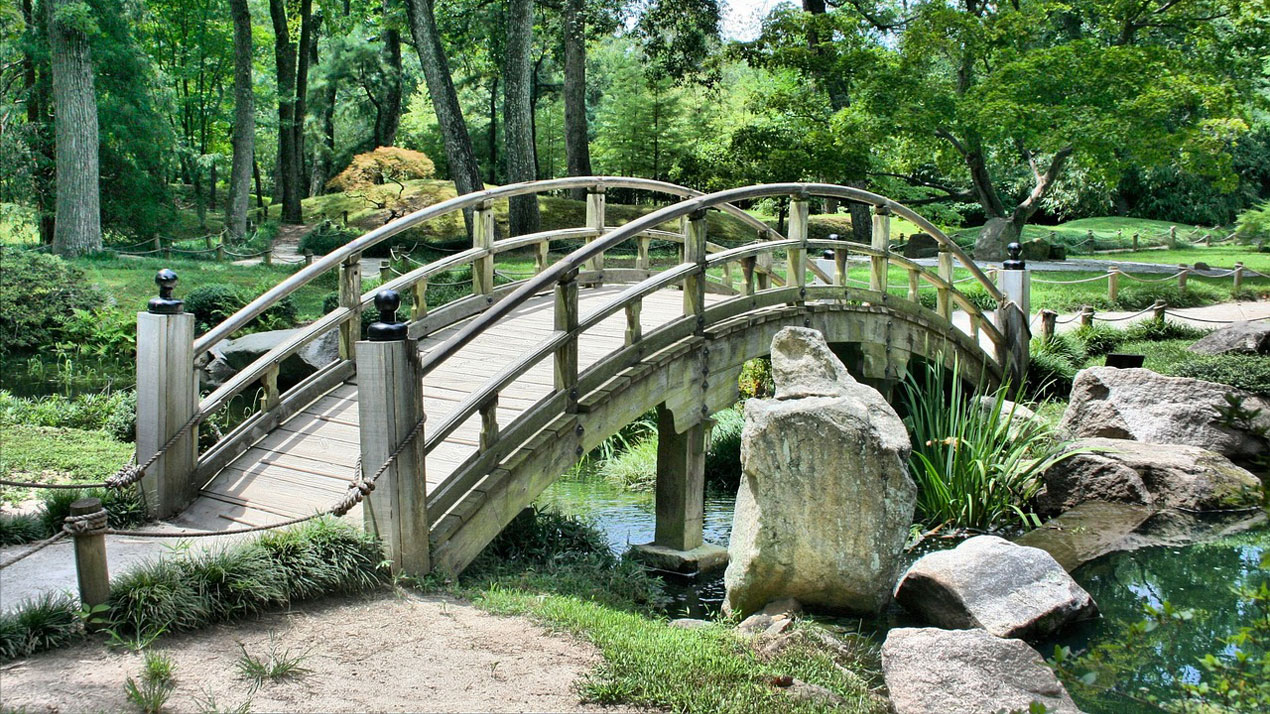
Gangway Bridges (Yatsuhashi)
Yatsuhashi bridges, usually constructed from wood or bamboo, are prominent elements found in Japanese gardens. They are specifically designed to traverse ponds or small bodies of water. These bridges, often with zigzag patterns, symbolize continuity and connection. The unique zigzag design serves both an aesthetic purpose, enhancing the scenic beauty, and a functional role, allowing visitors to enjoy varying viewpoints of the water and surrounding landscape. Yatsuhashi bridges encapsulate the harmony between human design and nature, inviting contemplation and serenity as visitors engage with the garden’s tranquil environment.
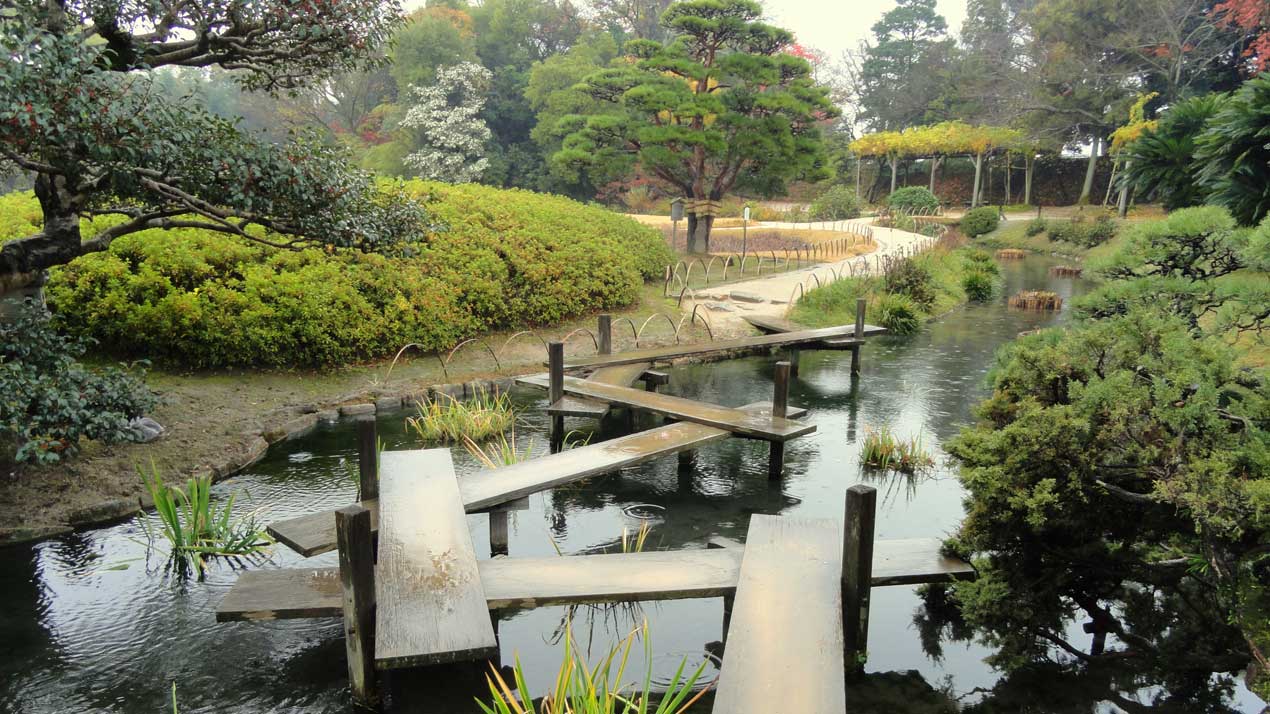
Stone Pagoda Lanterns (Ishidoro)
Ishidiro is a type of Japanese ornamental stone lantern typically used in traditional Japanese gardens as an outdoor decoration. The lantern’s design is inspired by pagodas, a tiered tower structure commonly found in East Asia. It typically consists of a tall central pedestal with several roofs or tiers stacked on top of it.
The Ishidoro lanterns are typically made from granite or other durable stones, and they often feature intricate carvings and designs on the side of each tier. These lanterns were hysterically used to light the way at night, and they continue to be popular decorations in Japanese gardens and outdoor spaces around the world.
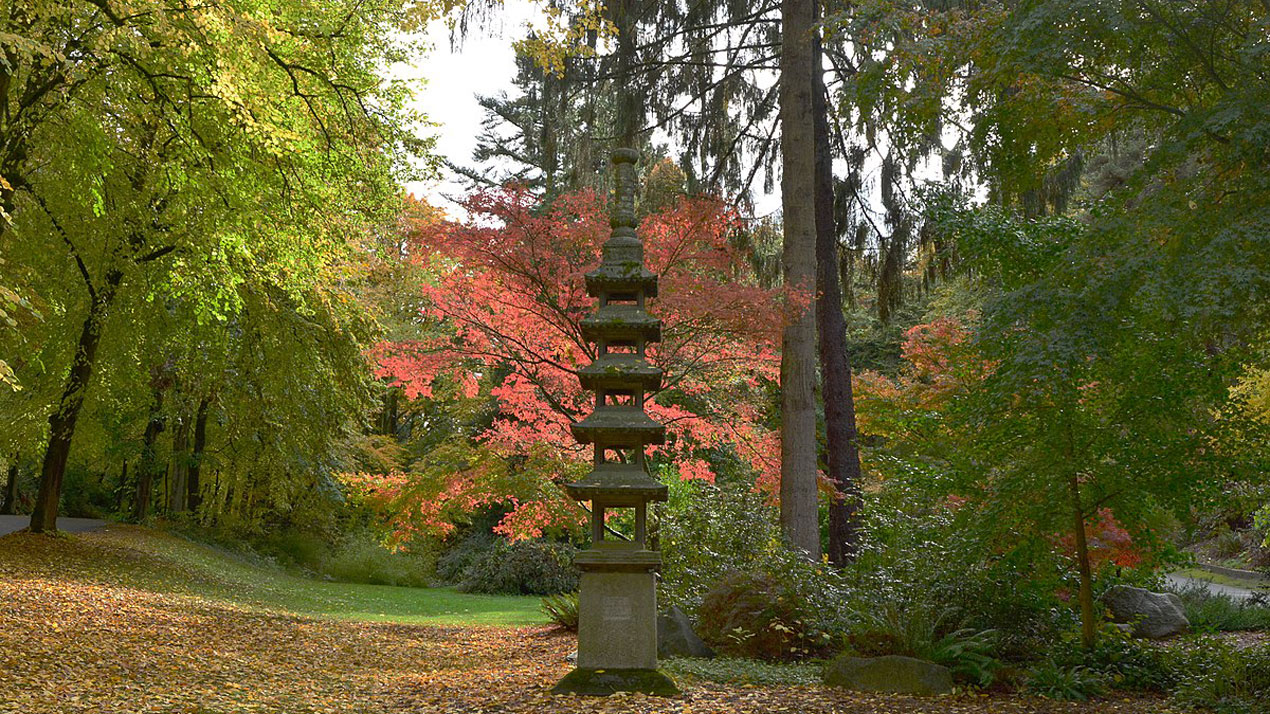
Deer Scarer Fountain (Shishi Odoshi)
Shishi Odoshi is a traditional Japanese device used in gardens to scare away animals, such as deer or wild boar, by creating a sound and motion that is designed to startle them.
The device consists of a bamboo tube that is balanced on a pivot point so that it can be easily tipped.
When the bamboo tube is filled with water, it slowly tips forward until it empties its contents into a stone basin below, causing it to swing back and hit a rock, making a loud clunking sound. The sudden noise and movement of the bamboo tube startles the animals, and they typically run away.
Shishi Odoshi is also used in traditional Japanese tea ceremonies and is often seen as a symbol of Zen Buddhism.
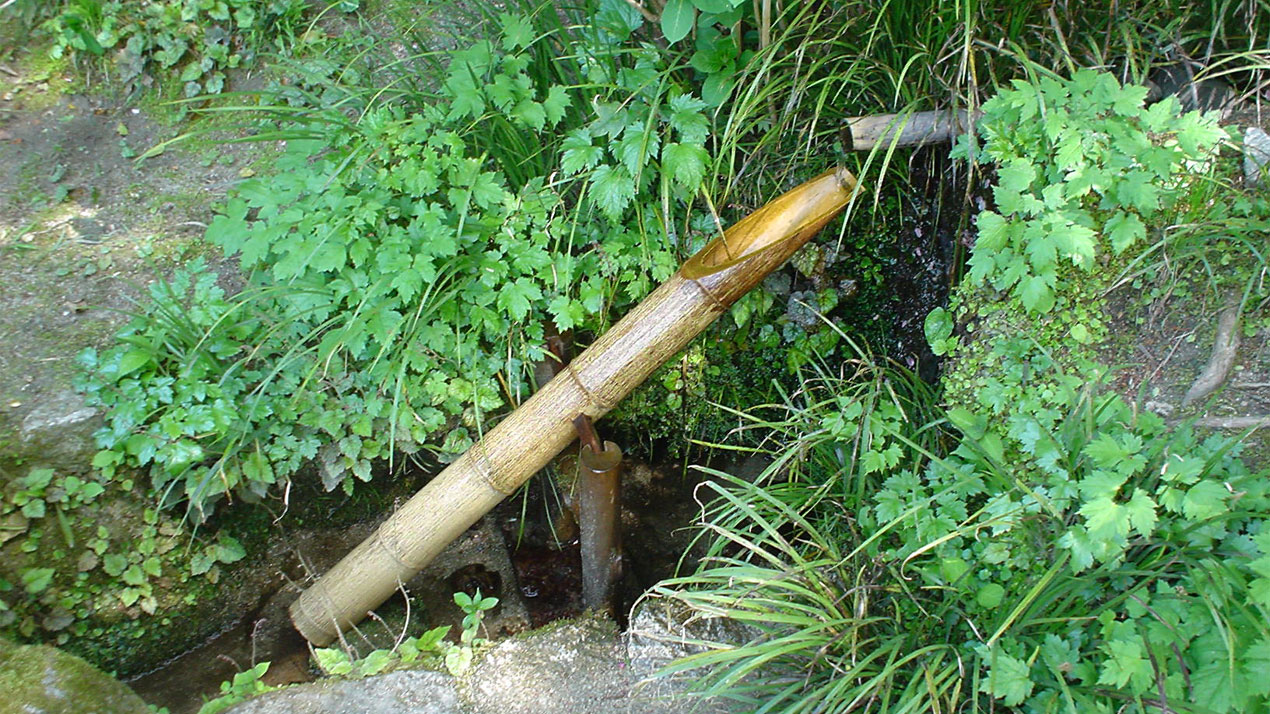
Teahouses (Chashitsu)
Teahouses and pagodas are common elements found in Japanese gardens, which are designed to create a peaceful and harmonious atmosphere that reflects the beauty of nature. Teahouses, also known as chashitsu, are small traditional buildings where the Japanese tea ceremony is performed.
They are typically constructed from natural materials such as wood, bamboo, and paper, and are designed to be simple and understated, with a focus on creating a tranquil and serene environment. Teahouses are often located near a water feature such as a pond or stream, and they are often positioned to take advantage of views of the garden.
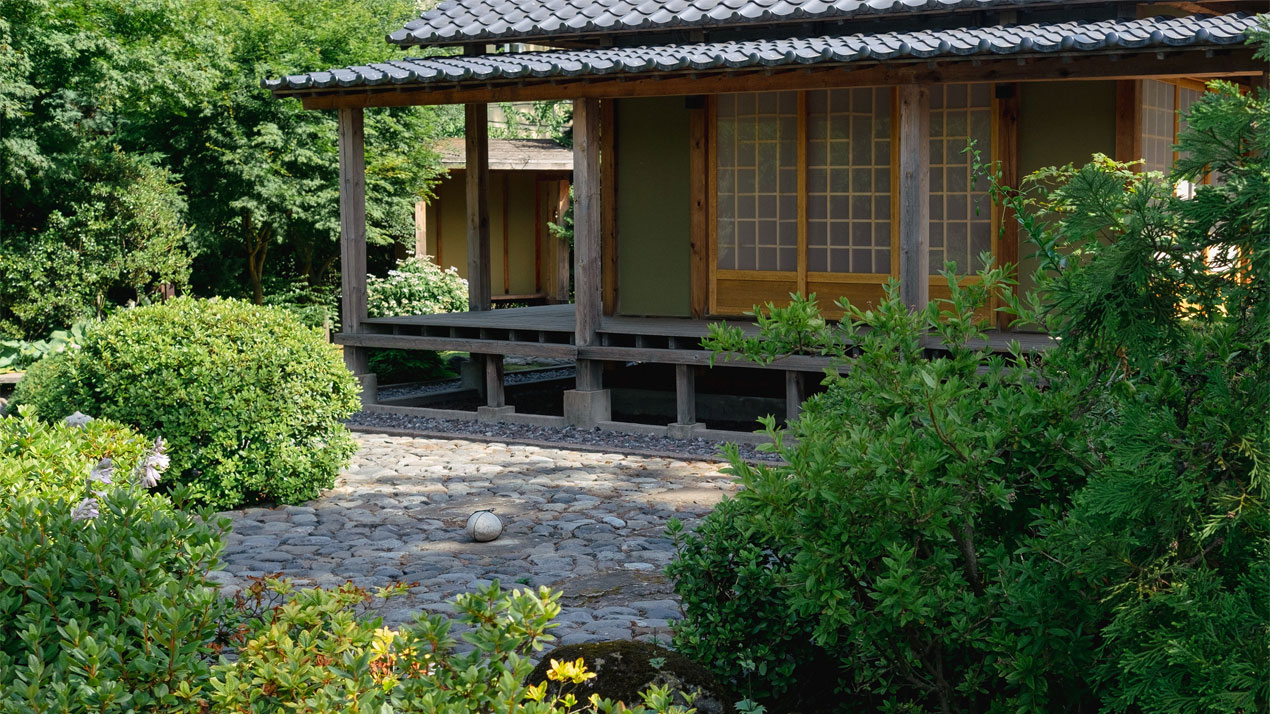
Pagodas (Tō)
Pagodas, are taller structures that are typically made of wood or stone, and feature multiple tiers or levels.
They are often placed in prominent locations within the garden, such as the top of a hill or near a water feature, and are designed to provide a focal point for the eye to rest on. Pagodas are also used to symbolise various aspects of Buddhism, such as the levels of enlightenment or the elements of nature.
Together, teahouses and pagodas help to create a sense of balance and harmony within the Japanese garden, and they provide a space for visitors to connect with nature and find inner peace.
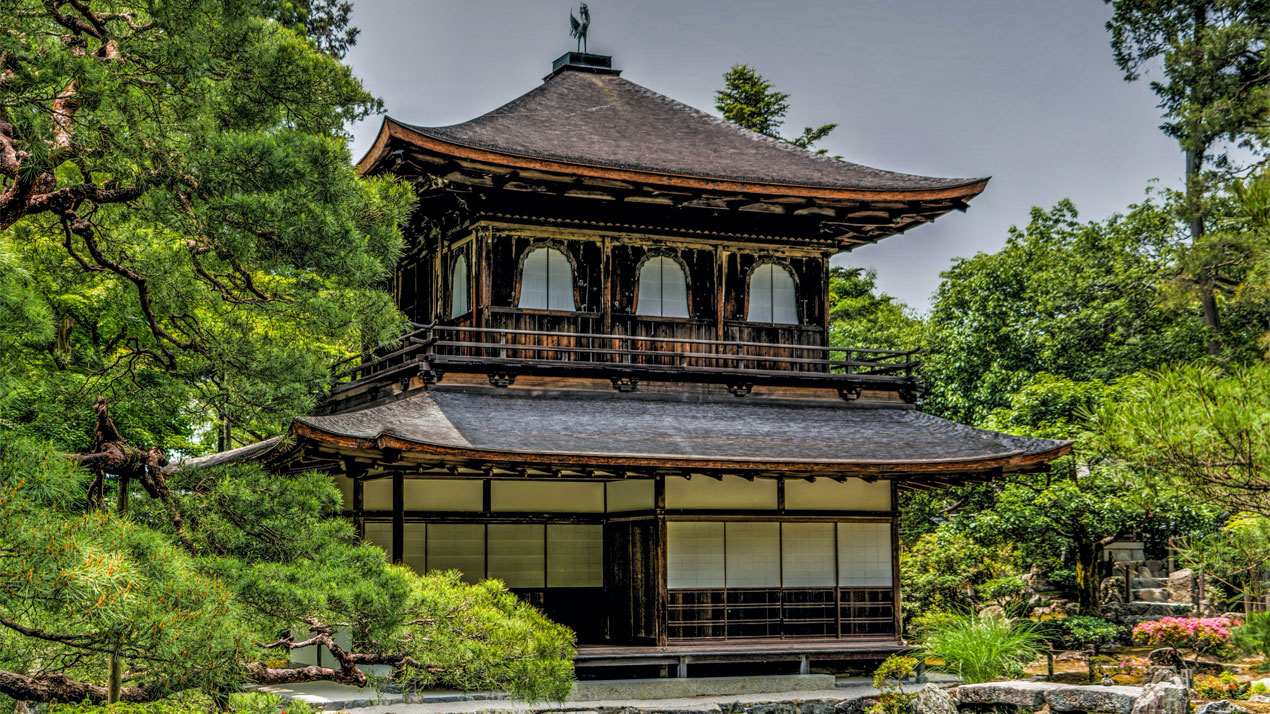
Ornamental Gates (Hogei Niwamon)
Hogei Niwamon, also known as”Carpentry Garden Gates”, are a type of gate commonly found in traditional Japanese gardens. These gates are characterised by their “winged” appearance and intricate wooden designs and constructions, which often incorporate joinery techniques without the use of nails or screws.
Hogei Niwamon gates can be found in various sizes and styles, ranging from small entrance gates to larger gates that span entire walkways. The designs of these gates often feature natural elements, such as trees and animals, and may also incorporate traditional Japanese symbols and motifs. In addition to their aesthetic appeal, Hogei Niwamon gates are also functional, serving as a means to control the flow of foot traffic throughout the garden.
The craftsmanship and attention to detail that goes into constructing these gates make them an important part of the overall aesthetic and experience of a traditional Japanese garden.
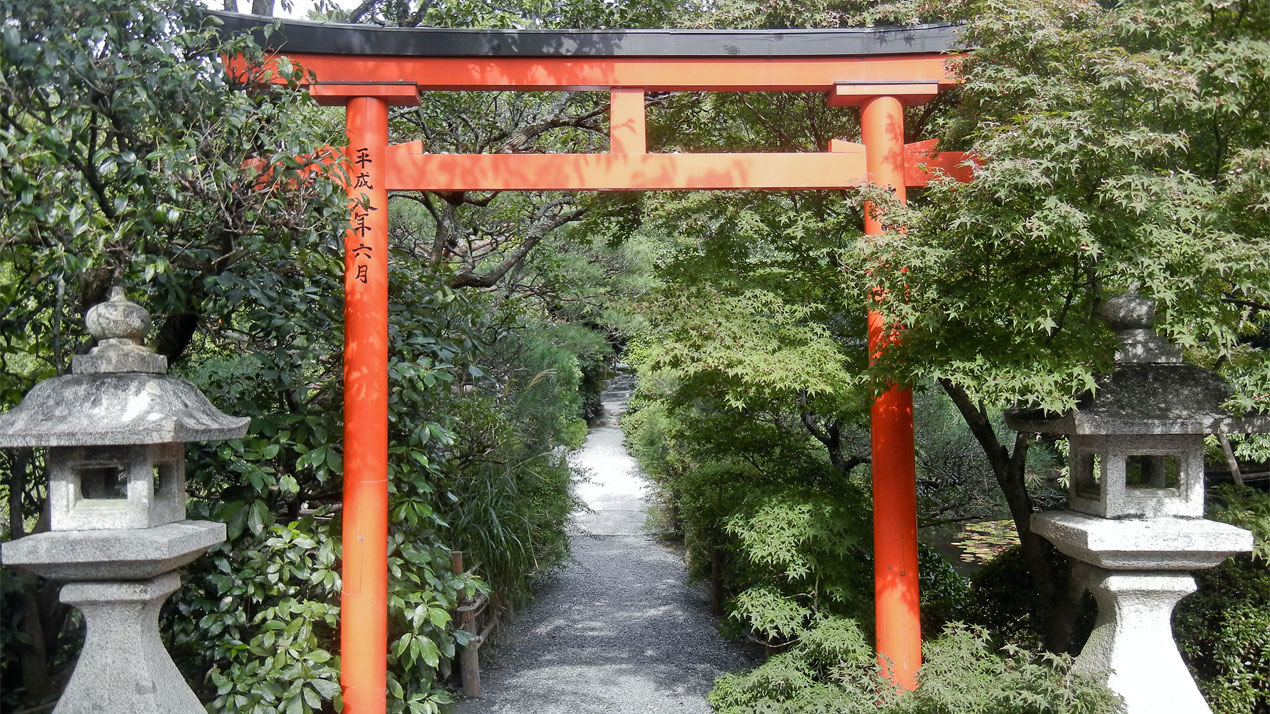
Boundary Fences & Walls
Boundary fences are also commonly used in Japanese gardens, and can be made of a variety of materials, including bamboo, wood, and stone. These fences may be used to define the boundaries of the garden, or to create visual interest and texture.
Overall, exterior walls and boundary fences play an important role in Japanese garden style, helping to create a sense of harmony and balance between the natural and man-made elements of the space.
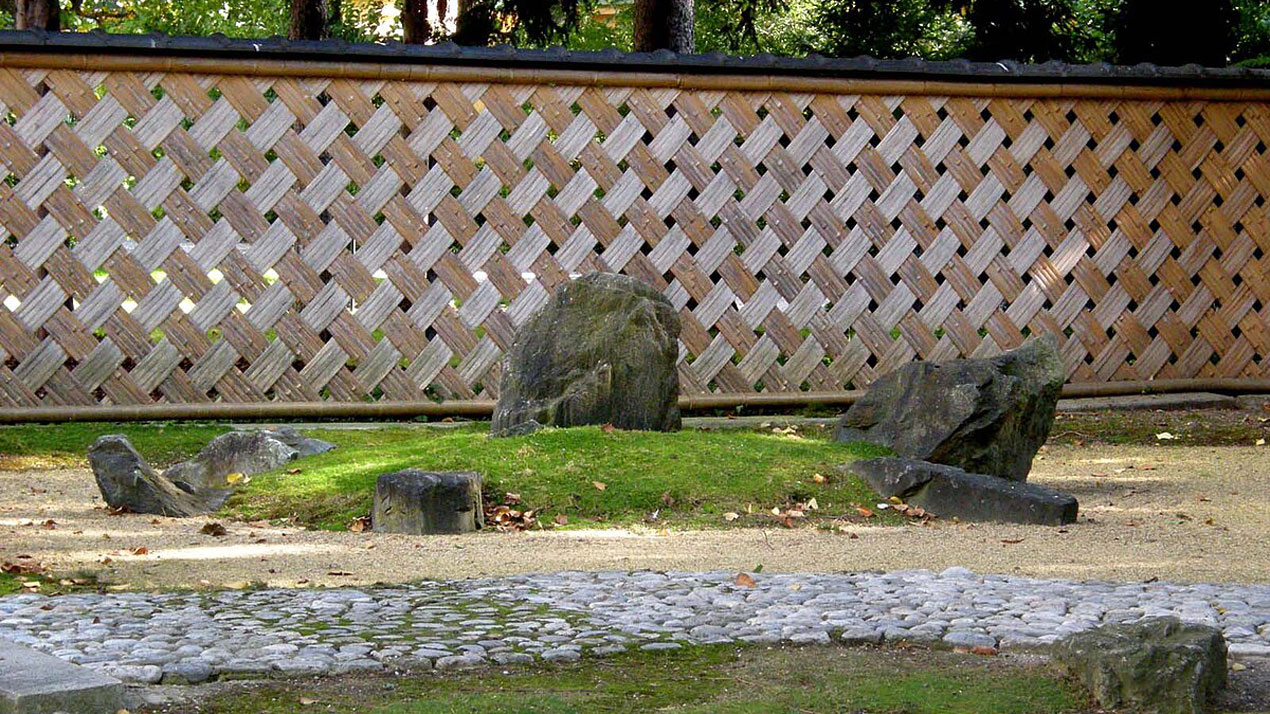
Creating a Beautiful Japanese Garden
Creating a Japanese garden requires careful planning, attention to detail, and an understanding of Japanese gardening principles. Here are some steps to help you create a stunning Japanese garden:
Planning
As with most practical activities, landscaping and garden design is best served with some decent planning. Japanese gardens are about balance and harmony. So, you need to be thoughtful about where things will go and what sort of aspects and views you wish to create.
Carefully consider elements like groundwork, structures, layout, plant selection, pathways, and water features in advance. This allows for proper utilization of space and resources. This planning minimizes mistakes and maximizes the garden’s beauty, functionality, and adherence to traditional Japanese aesthetics.
Research
Before you start planning, research the different styles of Japanese gardens, including their history and key elements. This will help you decide which style of garden you want to create.
Design the purpose
What is the purpose of your Japanese garden?
Will it be a place for relaxation, meditation, or entertainment? Knowing the purpose of the garden will help you decide on the layout and features you need to include.
Choose the location
Select a suitable location for your garden. Consider the amount of sunlight and shade, the type of soil, and the existing vegetation.
Create a layout
Create a layout of the garden. Decide on the size, shape, and location of the main elements, such as the pond, bridge, and pathways.
Choose the materials
You choose the materials you will use in your garden, such as rocks, pebbles, and plants. Consider the texture, colour, and size of the materials to create a harmonious and balanced look.
Consider the seasons
Japanese gardens are designed to look beautiful all year around. Consider the seasonal changes and how they will affect the garden’s appearance. Where are the spring blossoms and autumnal hues going to be sited?
Seek inspiration
Look for inspiration from other Japanese gardens, books, and online resources. This will help you get a better idea of what you want your garden to look like.
Hire a professional
If you are not experienced in landscaping or gardening, consider hiring a professional to help you with the planning and implementation of your future Japanese garden.
Planning throughout the year
Seasonality profoundly influences Japanese garden design, embodying nature’s dynamic essence. Spring cherry blossoms, vivid maples in autumn, and serene winter landscapes are meticulously incorporated. Plants, structures, and arrangements shift to mirror the evolving seasons, creating an ever-changing tapestry that resonates with the passage of time and the beauty of impermanence. Carefully plan a Japanese garden by selecting plants and elements that showcase seasonality.
Spring: Cherry blossoms
Cherry trees should be sited so that their stunning springtime blossom creates a nebulous swathe of pink and white colour. Consider siting near building and structures or beside reflective, tranquil water features.
Plant cherry blossom trees in well-draining, slightly acidic to neutral soil with added organic matter. Choose a sunny location, space trees for air circulation, and dig a shallow, wide hole for planting. Avoid deep planting and mulch to retain moisture. Water, stake if needed, and prune for balanced growth.
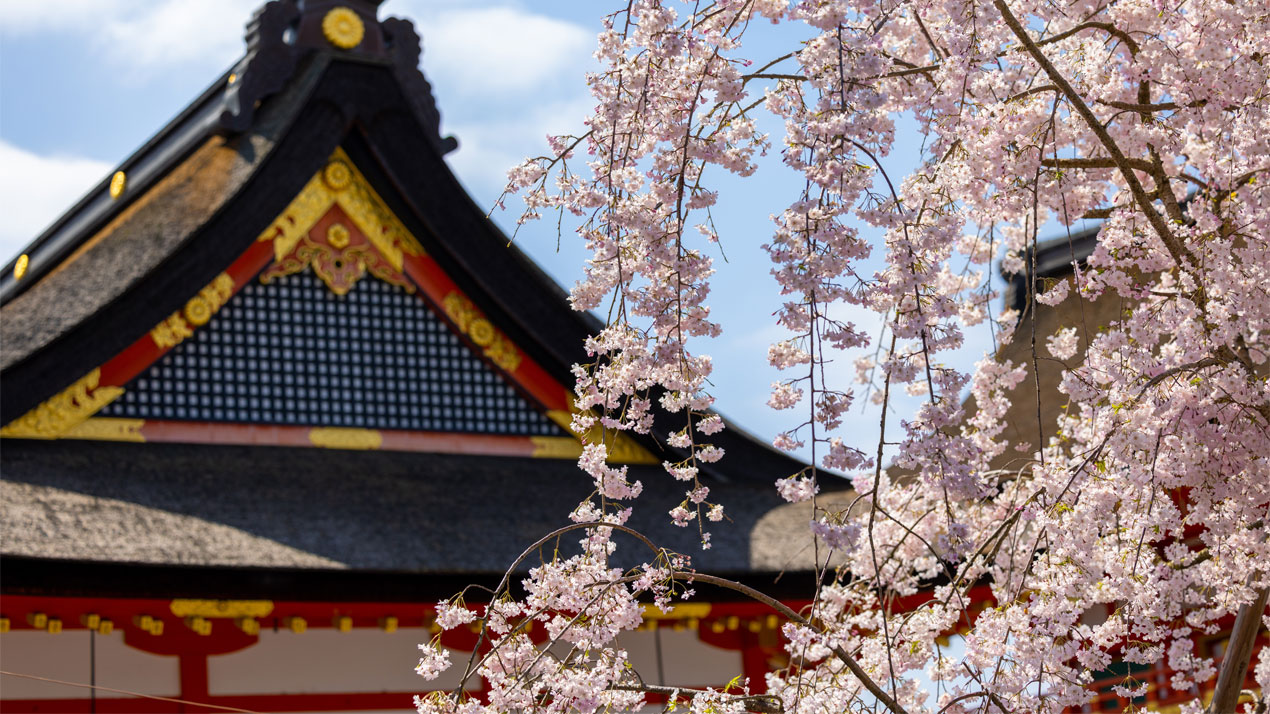
Summer: Japanese Anemone
Japanese Anemone shines as a superb summer bloomer, its elegant flowers embodying grace and tranquillity. Thriving in partial shade, they offer a serene touch to gardens, with delicate petals and timeless beauty that captivates the eye.
Japanese Anemone, cherished summer bloomers, thrive in partial shade and well-drained, moist soil. Their enchanting presence brings serenity to gardens, and their adaptability to varying conditions makes them perfect for adding elegance to diverse landscapes.
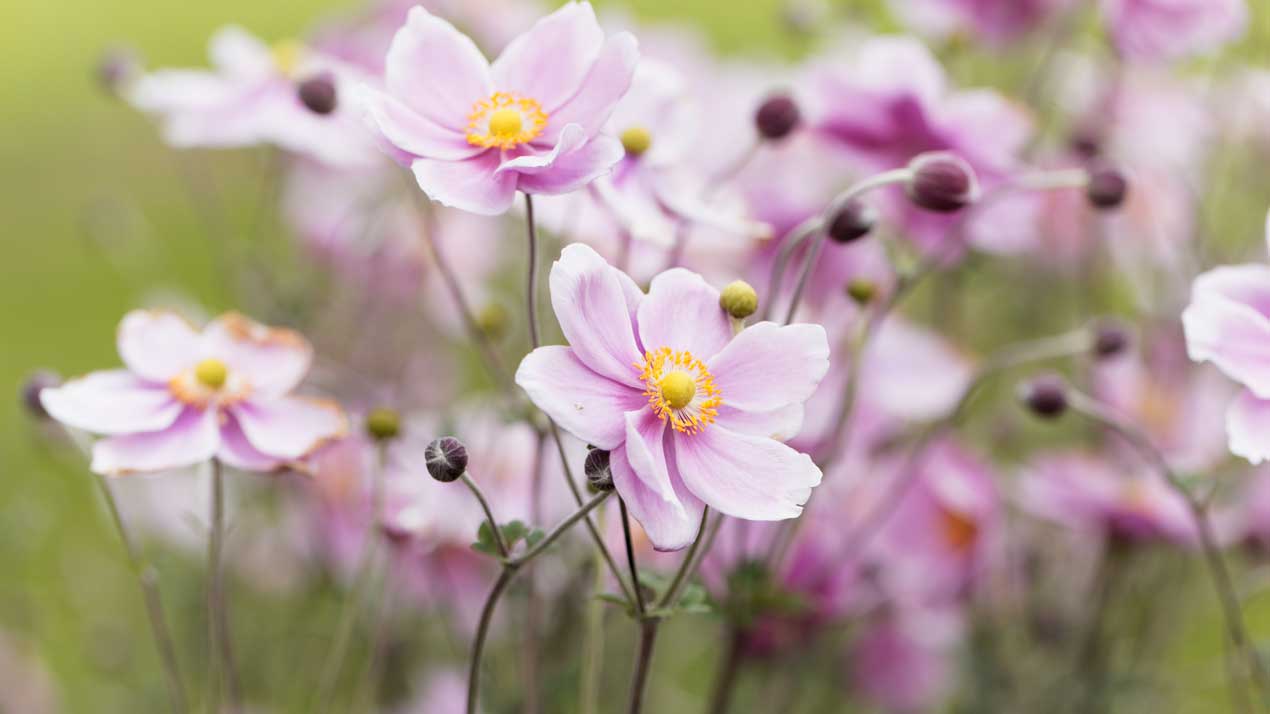
Autumn: Japanese Maple
Planting Japanese maples involves choosing a suitable location with dappled shade and well-draining soil.
These trees display their stunning bright colours in autumn due to the breakdown of chlorophyll, revealing pigments like red and orange. Their graceful, delicate leaves create a mesmerizing spectacle, adding a touch of elegance to any landscape.
Japanese Maples flourish in dappled shade and well-drained, slightly acidic soil. Their exquisite foliage ranges from vivid reds to soft greens, enhancing gardens. These trees thrive in loamy or sandy soil, their color palette vibrant under the right pH conditions.
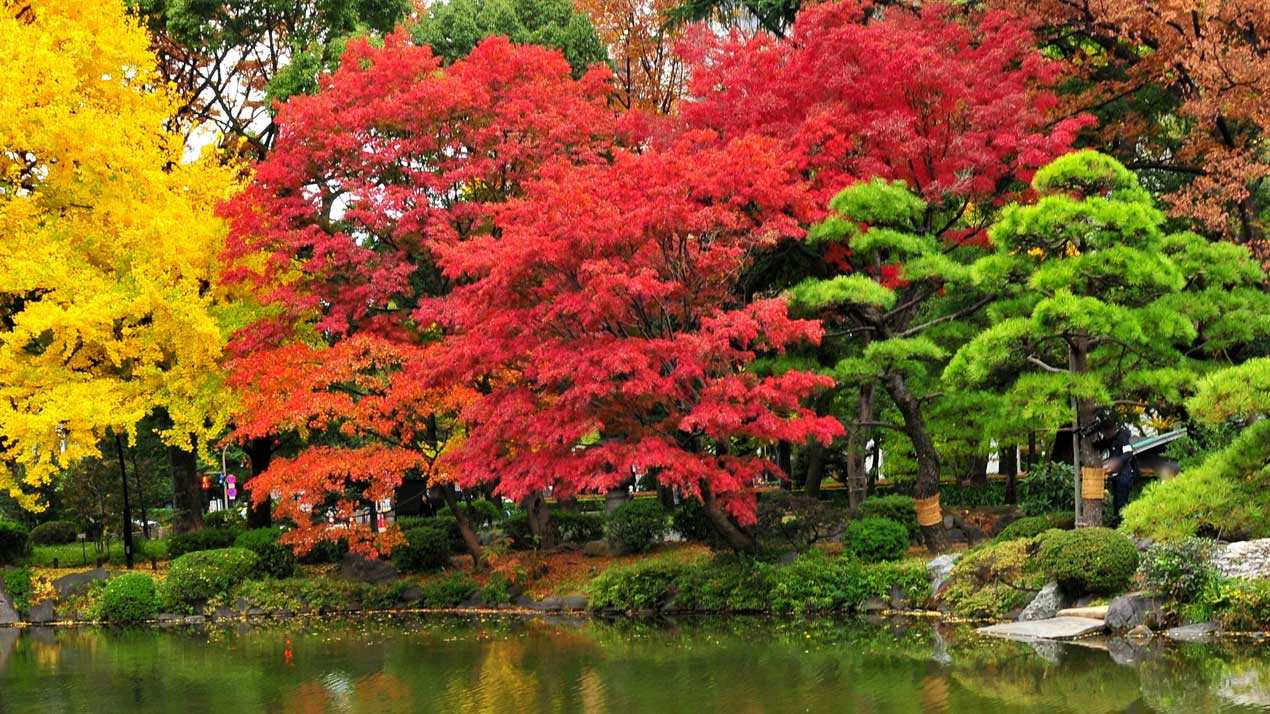
Winter: Magnolia
Magnolias contribute to the allure of Japanese gardens due to their exquisite, fragrant blooms and elegant, timeless beauty. The flowers symbolize purity, nobility, and perseverance in Japanese culture, harmonizing with the garden’s Zen aesthetic. Plant magnolias in early spring when the ground is workable for optimal growth.
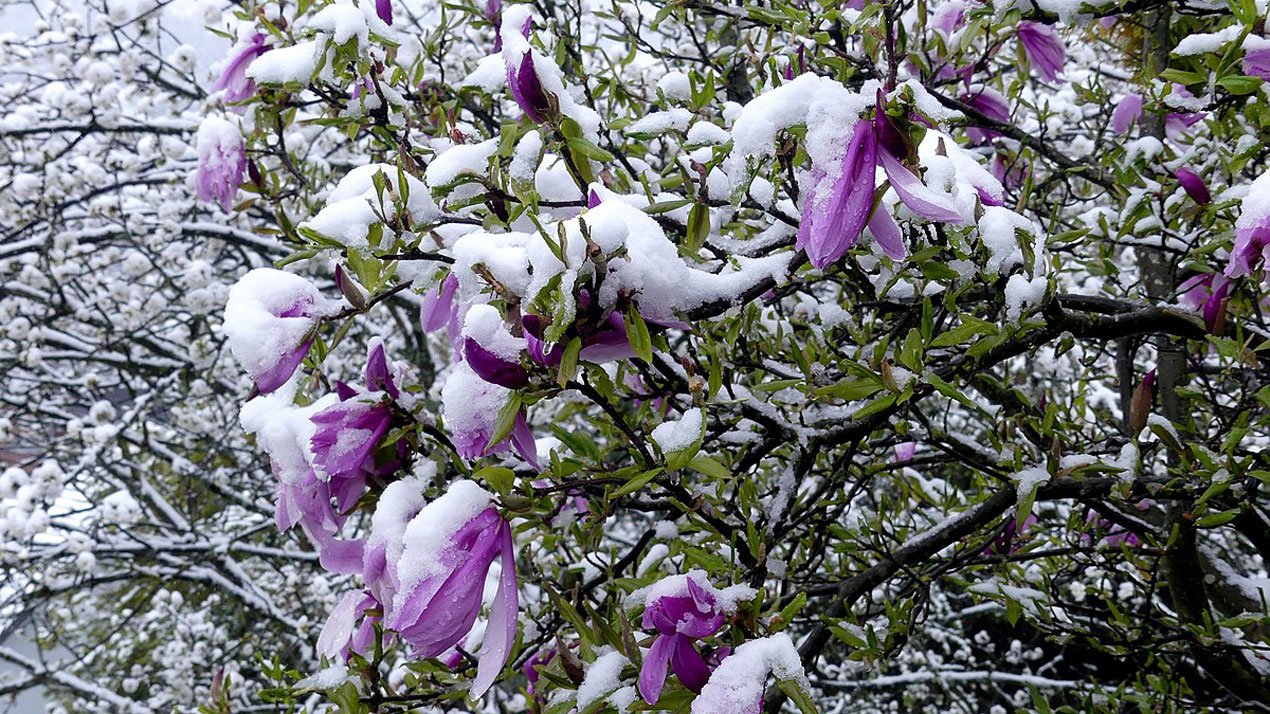
Add decorative elements
Decorative elements such as lanterns, statues, and rock formations can add interest and depth to your garden. Think about placement and how that effects their viewing in sunshine, shade and other changing conditions.
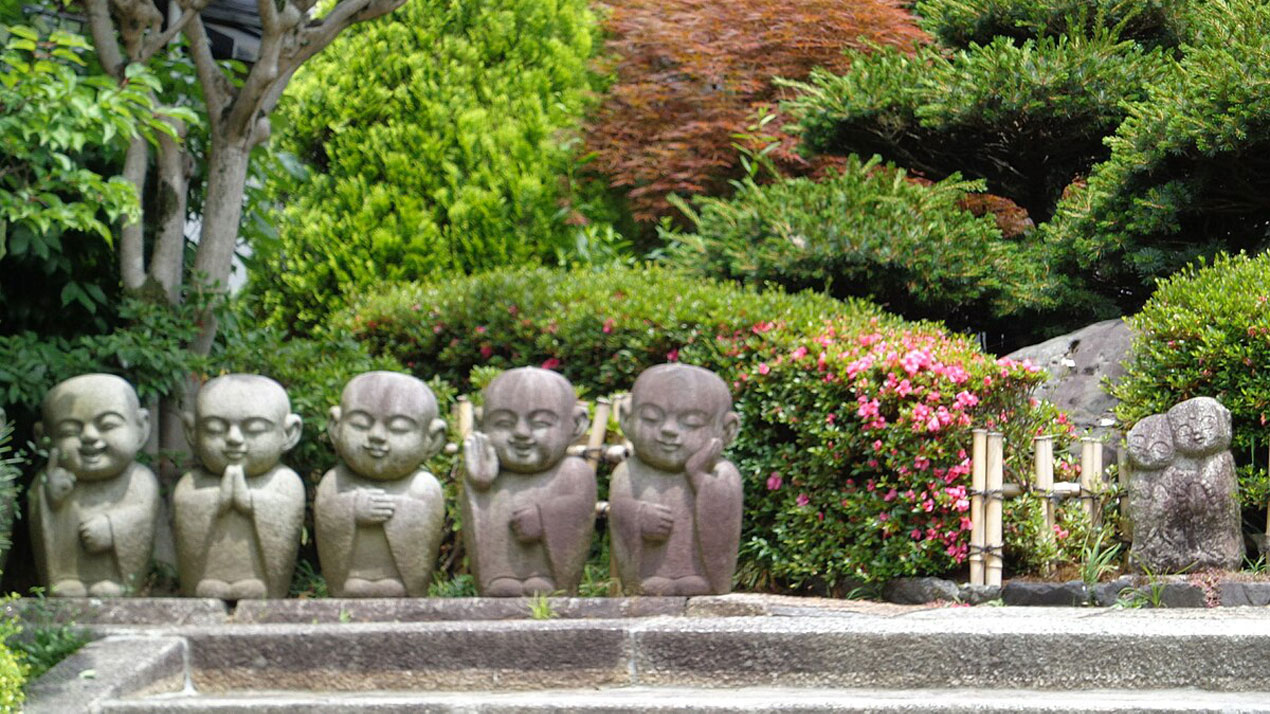
Shrubs/Topiary
Maintain topiary in a Japanese garden by carefully shaping shrubs into desired forms using precise trimming techniques.
Regularly prune to preserve the shapes, ensuring they harmonize with the garden’s tranquil and ordered ambiance.
Mindful attention and consistent care will uphold the artful essence of the topiary within the Japanese garden.
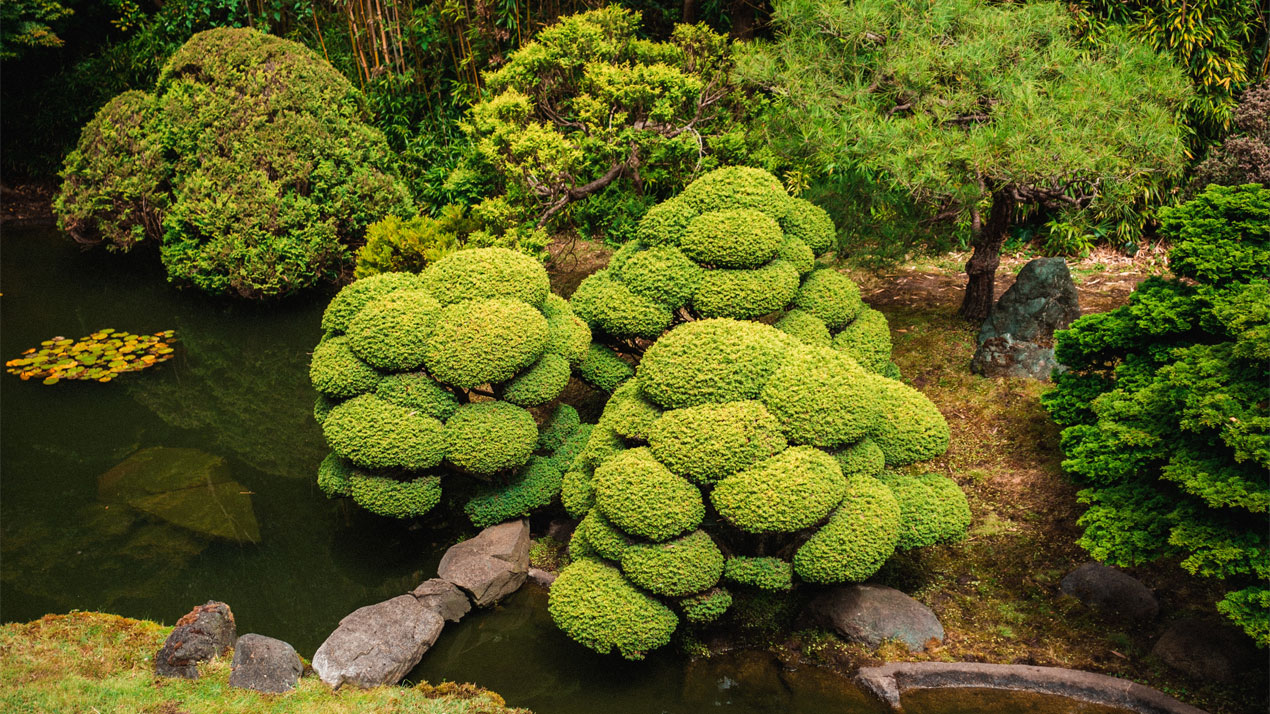
Lawns
To maintain the lawn in Japanese gardens, regularly mow it to an appropriate height, keep it free from weeds, and water it adequately.
Avoid excessive fertilization to maintain a natural and harmonious appearance, in line with the serene and minimalist aesthetic of the Japanese garden.
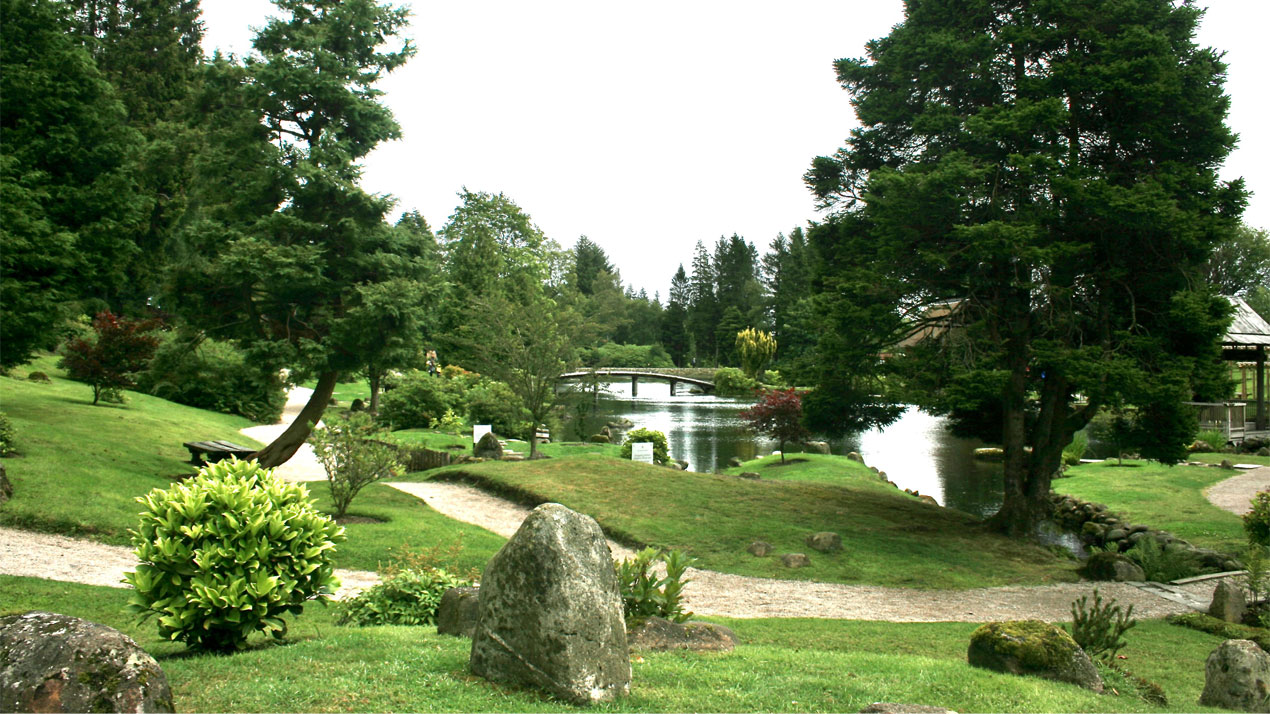
Maintain your garden
Japanese gardens require regular maintenance to keep them looking their best. Make sure to weed, prune, and water your plants regularly, and clean your water elements as needed.
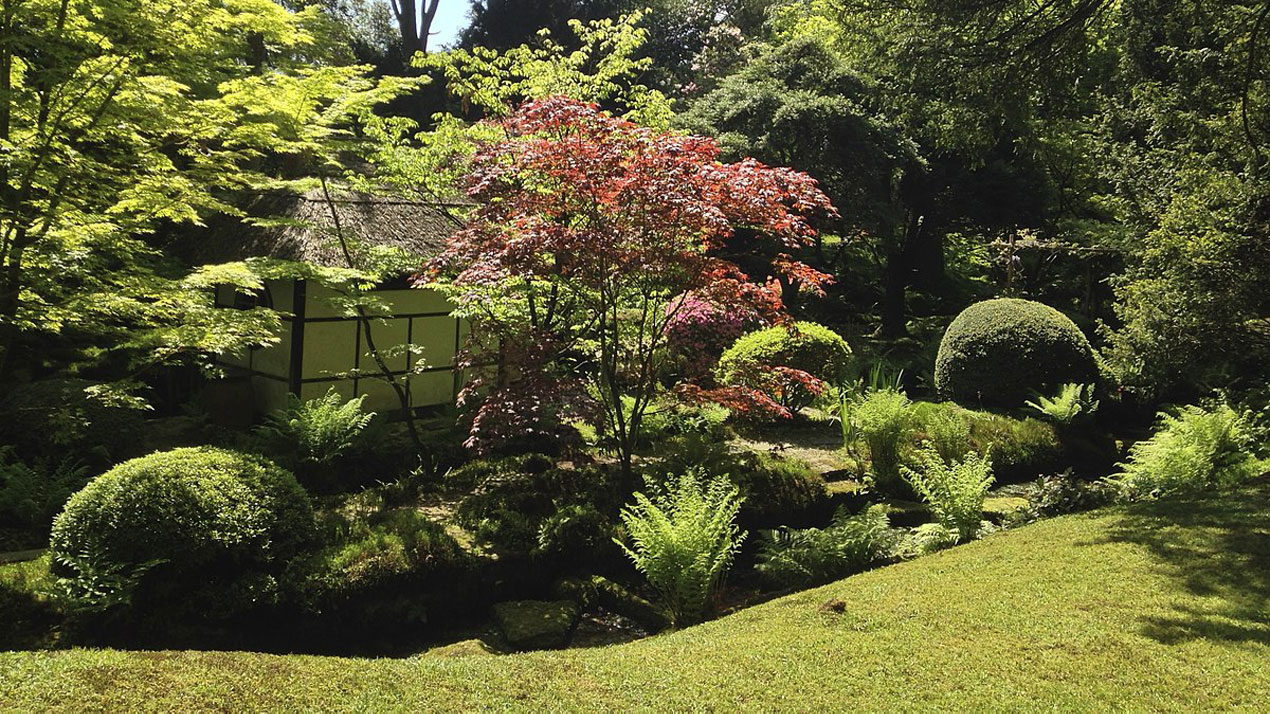
Creating a beautiful Japanese garden is a labour of love, but with careful planning and attention to detail, you can create a stunning outdoor space that will bring peace and tranquillity to your home.
Famous Japanese Gardens
Japan is famous for its traditional gardens that are designed to showcase the beauty of nature and inspire contemplation and meditation.
Here are some of the most famous Japanese gardens:
Katsura Imperial Villa
The Katsura Imperial Villa’s gardens (a UNESCO World Heritage Site), nestled in Kyoto, Japan, are a living masterpiece of harmony and design. Encompassing tranquillity, these meticulously arranged landscapes evoke the essence of Japanese aesthetics. Reflecting the changing seasons, the gardens feature winding pathways, elegant bridges, and artful ponds. Pruned trees, meticulous moss arrangements, and architectural elements form a mesmerizing blend of natural and man-made beauty, inviting contemplation and reverence in this serene sanctuary.
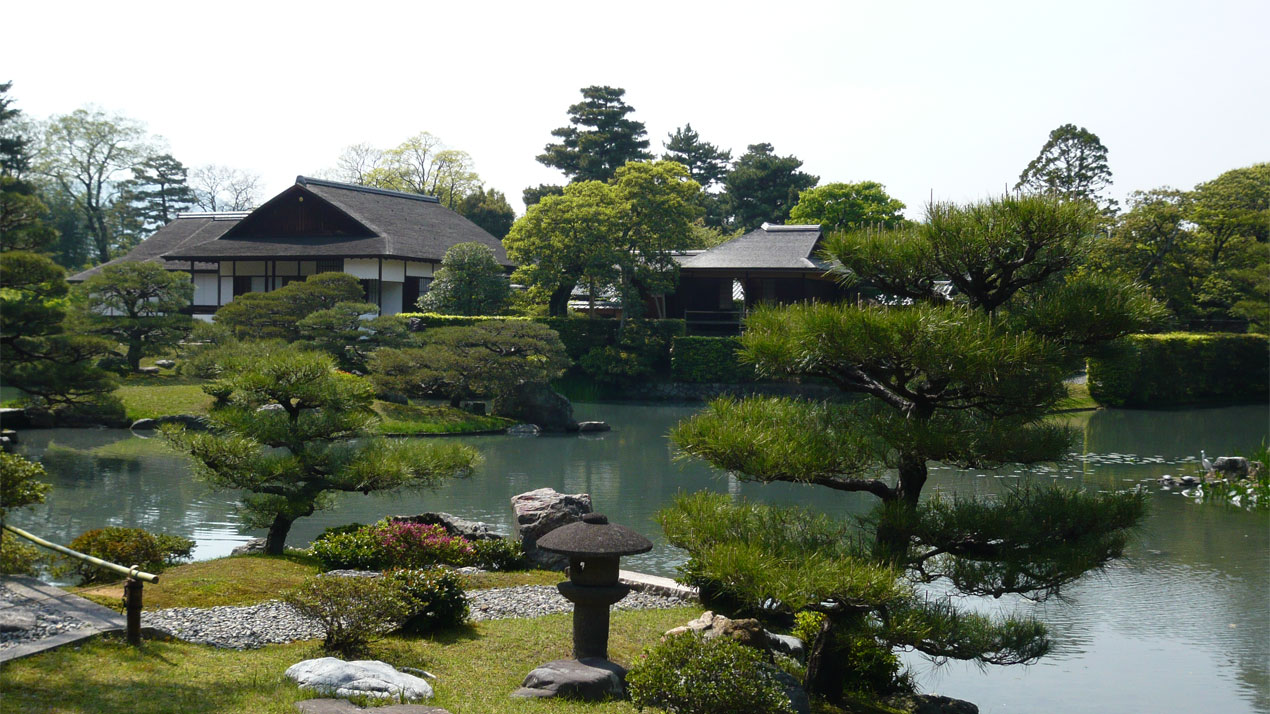
Ryoan-ji Temple Garden
The Ryoan-ji Temple Garden, located in Kyoto, Japan, is an embodiment of Zen minimalism and contemplation. Its raked gravel expanse, punctuated by precisely placed rocks, creates a space for quiet introspection. This iconic dry landscape garden, known as karesansui, encourages meditative engagement with its abstract simplicity. The arrangement’s profound serenity and enigmatic design invite visitors to explore their thoughts and seek tranquillity amid the beautifully composed harmony of elements and emptiness.
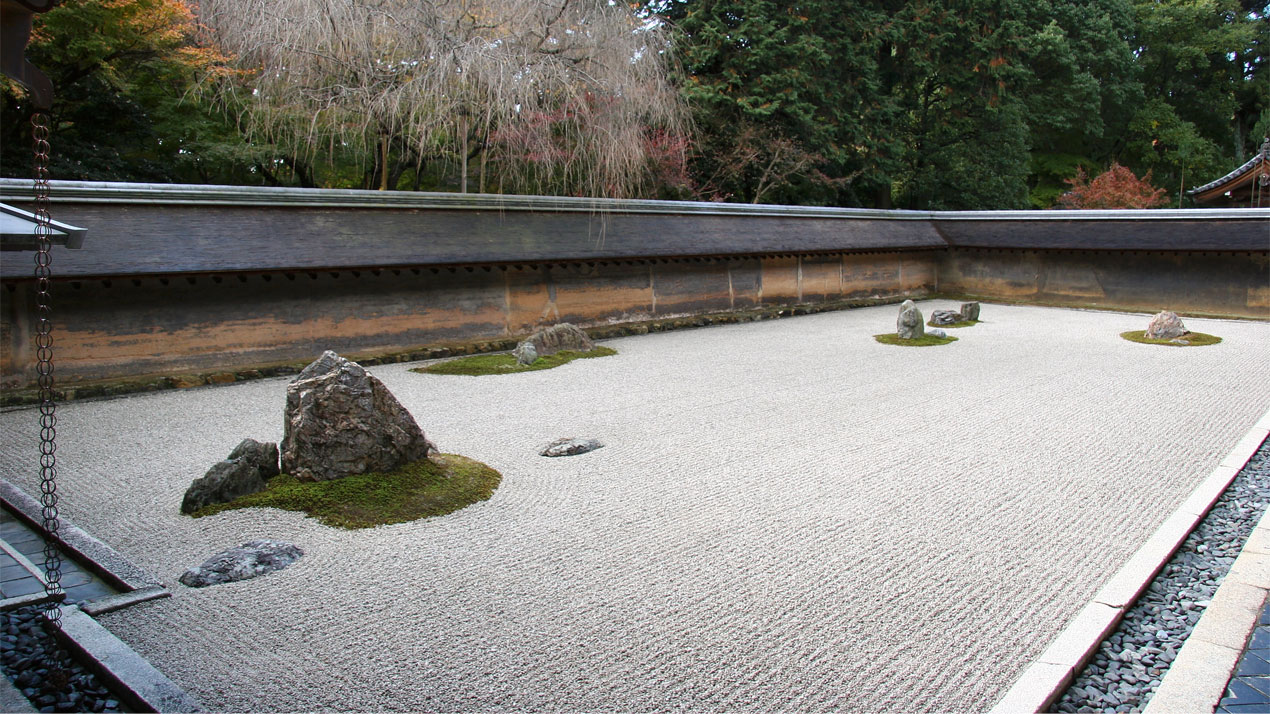
Adachi Museum of Art
This museum, situated in Yasugi, is famous for its garden, which has been ranked the best in Japan for 18 consecutive years. The gardens are a living canvas where nature and art harmonize. Renowned for their meticulously curated landscapes, these gardens offer breathtaking vistas through carefully placed windows, creating a seamless fusion of painting and reality. Verdant hills, tranquil ponds, and meticulously pruned trees frame each composition, inviting visitors to explore a world where the boundaries between art and nature blur, inspiring contemplation and serenity.
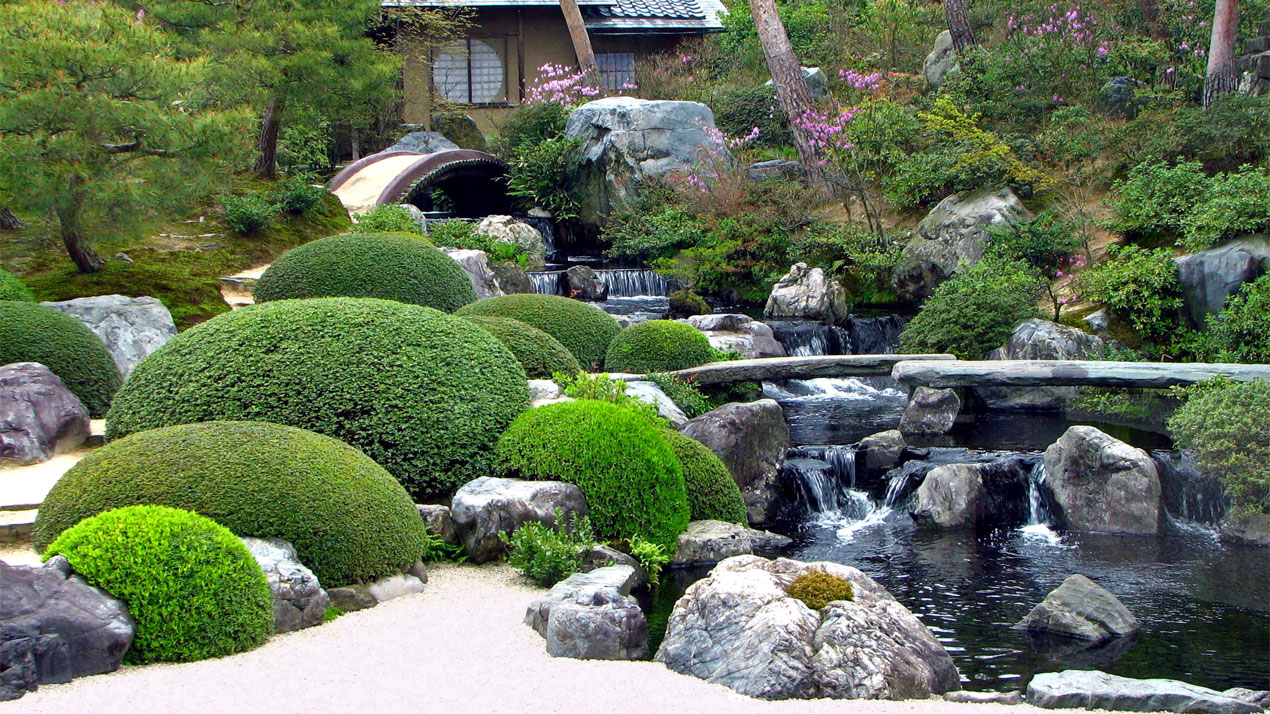
Kiyosumi Teien Garden
Based in Tokyo, this garden is located in the former grounds of Kinokuniya Bunzaemon‘s house (a wealthy merchant of the Edo period). The garden was constructed along classic principles in 1878–85, by the shipping financier and industrialist Iwasaki Yatarō during the Meiji Period.
The Garden is a captivating blend of traditional and modern design. With a central pond surrounded by meticulously placed stones, artful bridges, and thoughtfully arranged plantings, the garden radiates tranquillity. Seasonal changes provide an ever-evolving landscape, while the garden’s historical significance adds depth to its charm. An oasis in the heart of the city, Kiyosumi Teien offers a serene escape that celebrates Japan’s rich gardening heritage.
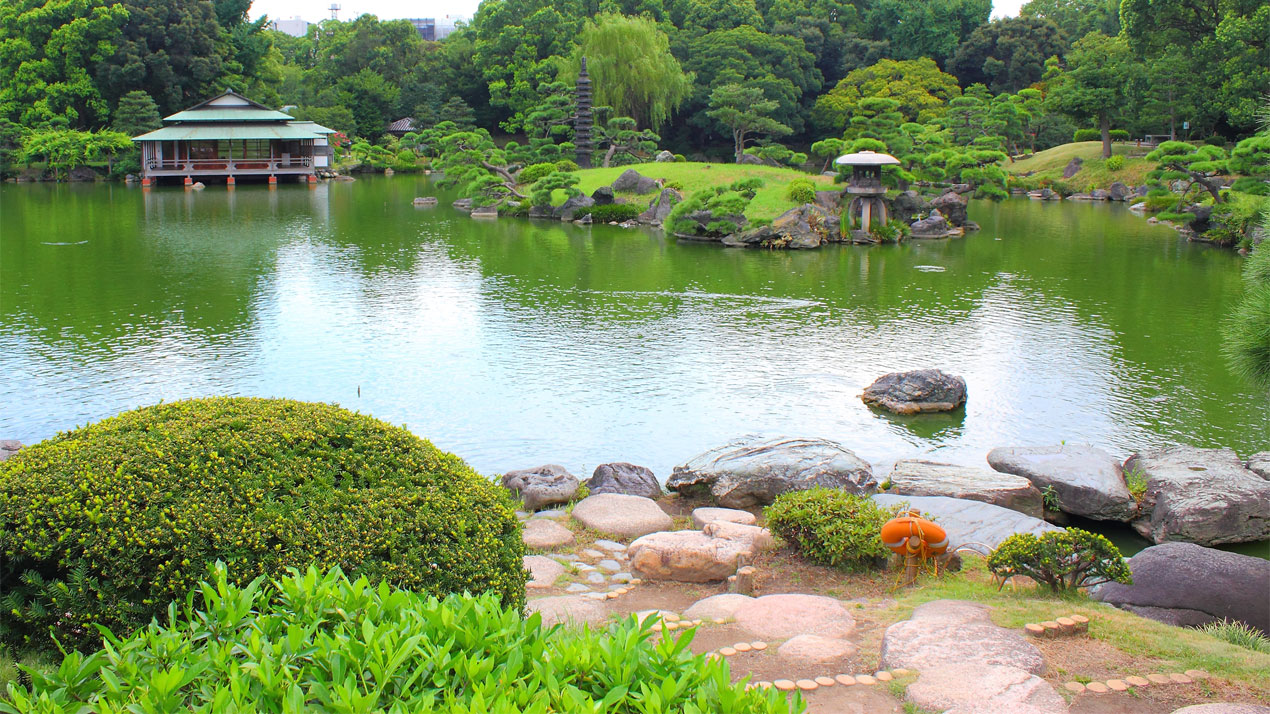
Korakuen Garden
Korakuen Garden, located in Okayama, Japan, is a storied masterpiece of Edo-period landscaping, dating back to the early 17th century. Created by Ikeda Tsunamasa, it was one of Japan’s Three Great Gardens. With its meandering streams, meticulously pruned trees, and symbolic teahouses, the garden showcases the blending of natural beauty and human design. Surviving through centuries of history, Korakuen Garden remains an embodiment of harmony, evolving to accommodate modern visitors while retaining its historical essence. This cultural gem, offering an oasis of tranquillity amidst urban life, continues to enchant with its timeless beauty and legacy.
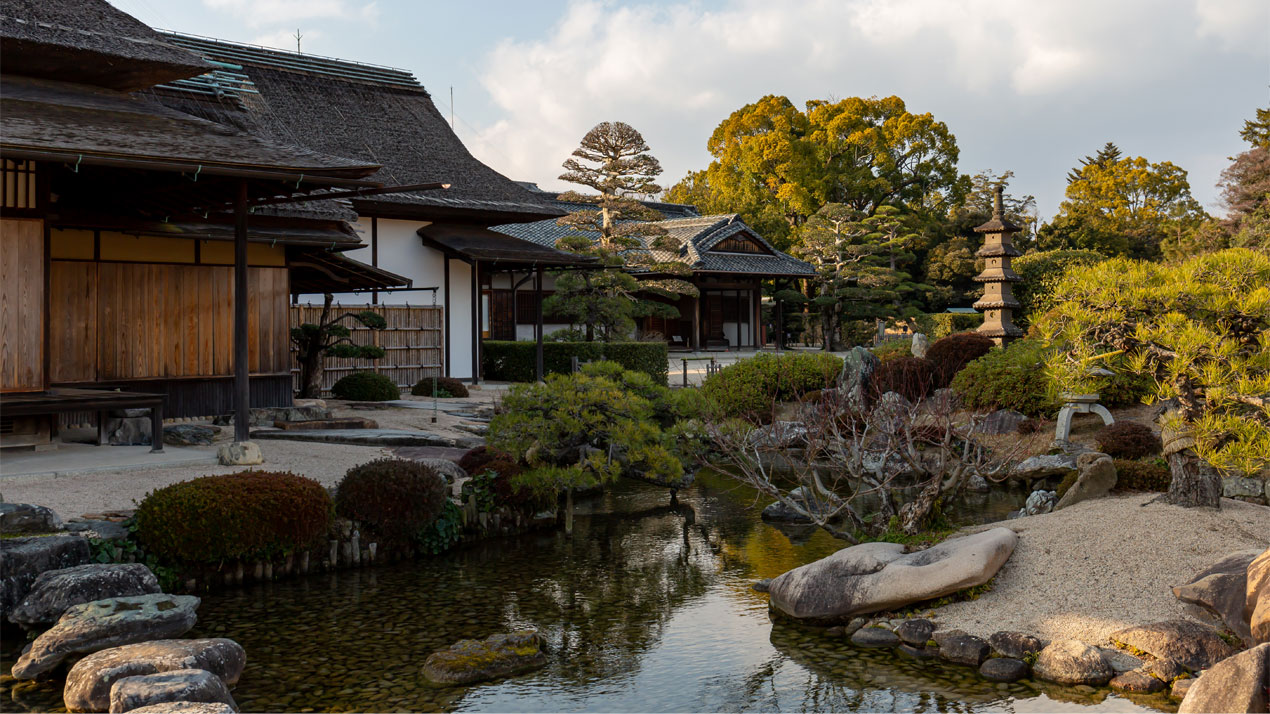
Japanese Gardens Around the World
Japanese gardens gained popularity worldwide due to their serene and harmonious design, incorporating elements like water, rocks, and plants.
Influenced by Zen Buddhism, they symbolize tranquillity and nature’s beauty. As global interest in Japanese culture and aesthetics grew, the appeal of these gardens expanded, becoming a cherished aspect of landscape architecture globally.
Parc Oriental de Maulévrier, France
Parc Oriental de Maulévrier is a stunning Japanese-style garden located in Maulévrier, France. Spanning over 29 acres, it showcases traditional and authentic Japanese landscaping techniques with picturesque ponds, bridges, pagodas, and lush flora. Visitors can immerse themselves in serene ambiance and experience the essence of Japan’s natural beauty.
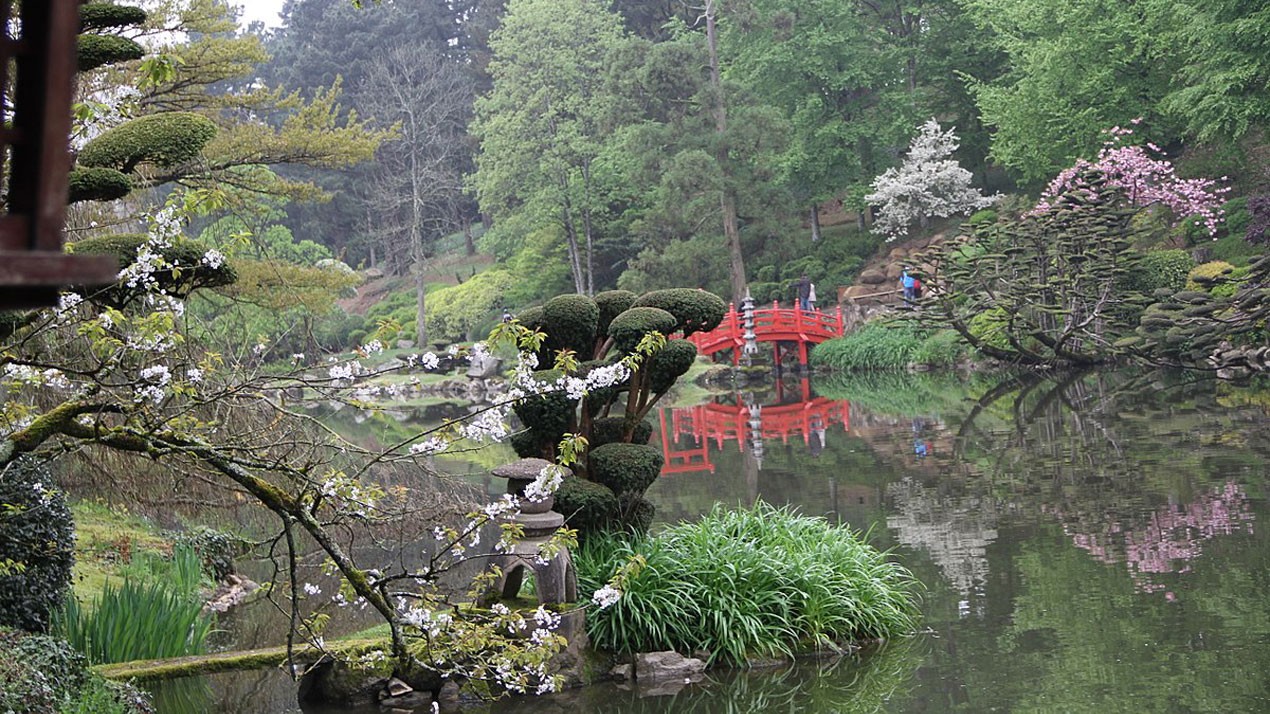
Portland Japanese Garden, Oregon, US
Portland Japanese Garden, nestled in Oregon, USA, is a captivating haven of tranquillity.
Described by the former Ambassador of Japan to the US as”the most beautiful and authentic Japanese garden in the world outside of Japan”, this Japanese garden consists of five unique gardens.
It epitomizes traditional Japanese landscaping and design, featuring Zen elements, serene ponds, intimate pathways, and meticulously crafted plants. Visitors revel in its serene ambiance, reflecting the beauty and grace of Japan’s landscapes.
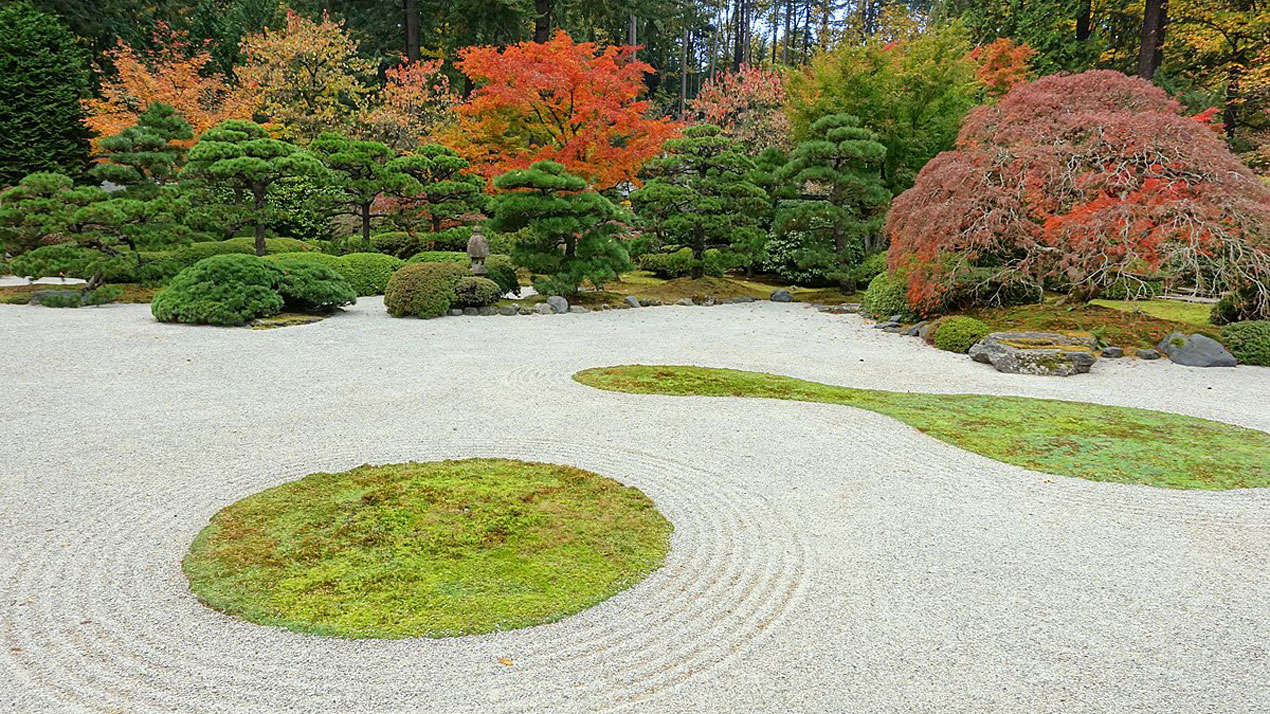
Parque Masayoshi Ohira, Mexico
Parque Masayoshi Ohira, Mexico’s grandest Japanese garden, captivates with its serene ambiance and breathtaking beauty. Vast landscapes of meticulously curated flora, tranquil water features, and traditional architecture create a harmonious haven, offering a blissful escape into nature’s tranquillity.
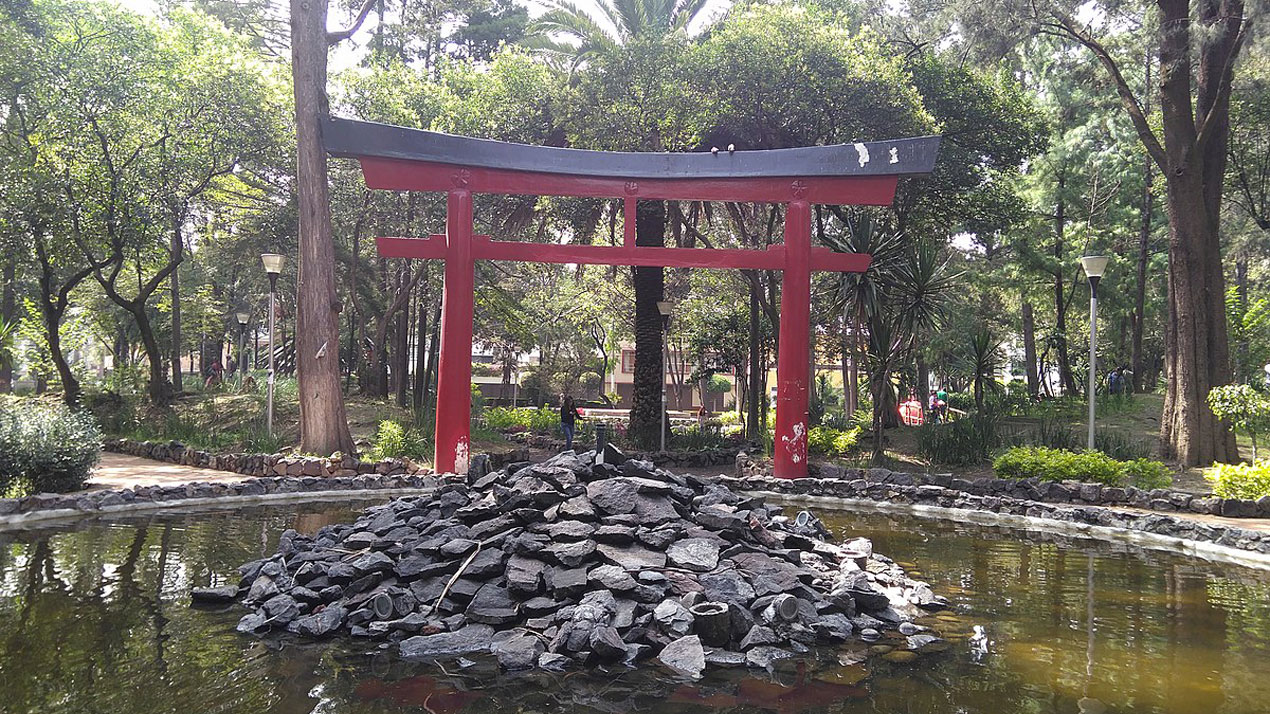
Three Japanese gardens to visit in the UK
Japanese gardens in the UK artfully showcase traditional elements like serene water features, meticulous rock arrangements, and harmonious plant compositions, creating a tranquil atmosphere. With careful attention to balance and symbolism, they captivate visitors with the grace of nature, Zen contemplation, and the time-honoured aesthetics that celebrate the beauty of Japanese culture. The following are our top three Japanese Gardens to visit in the UK:
Tatton Park Japanese Gardens, Cheshire
Tatton Park’s Japanese garden is renowned in the UK for its authenticity and striking design. Created in 1910, it captures the essence of a classic Japanese landscape, featuring a picturesque lake, authentic teahouse, and meticulously placed stones and plants, providing visitors with a serene and immersive cultural experience.
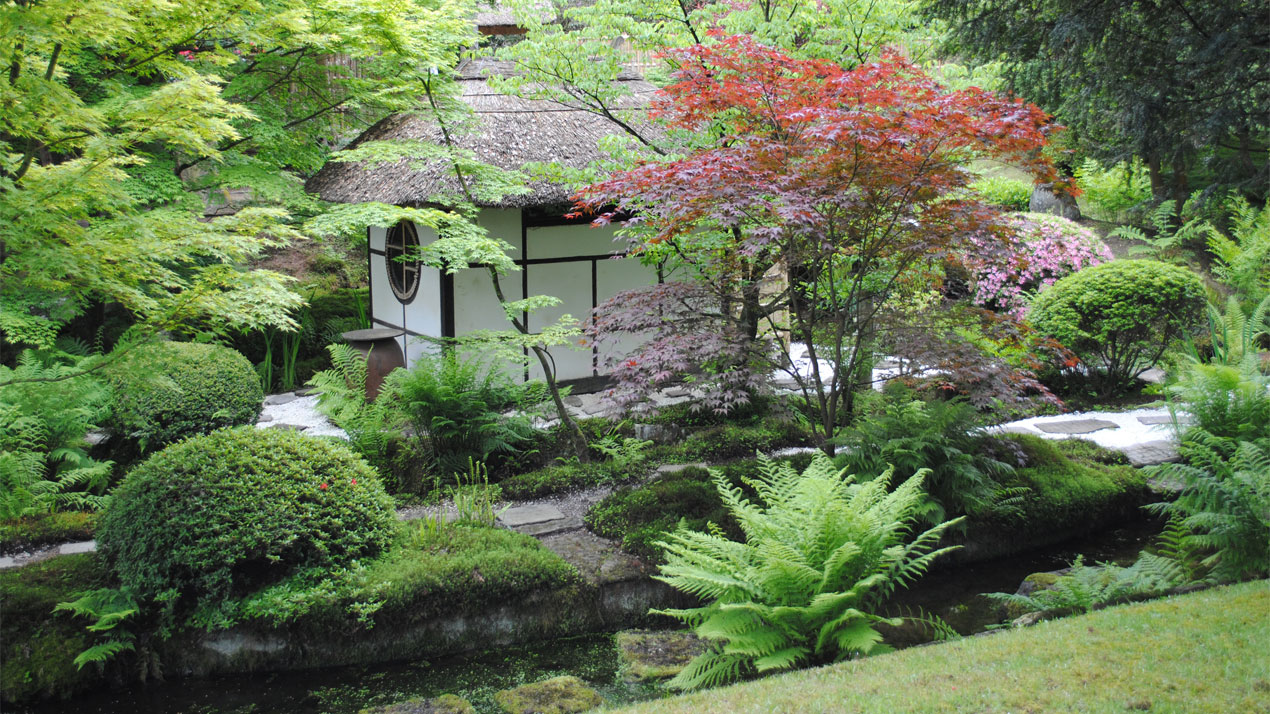
Birmingham Botanical gardens
Birmingham Botanical Gardens are a breathtaking oasis, showcasing diverse flora from around the world.
Lush greenery, vibrant flower displays, serene ponds, and enchanting architecture create a harmonious escape. The gardens’ beauty lies in their captivating blend of natural wonders, providing a serene sanctuary for visitors to immerse themselves in nature’s splendour.
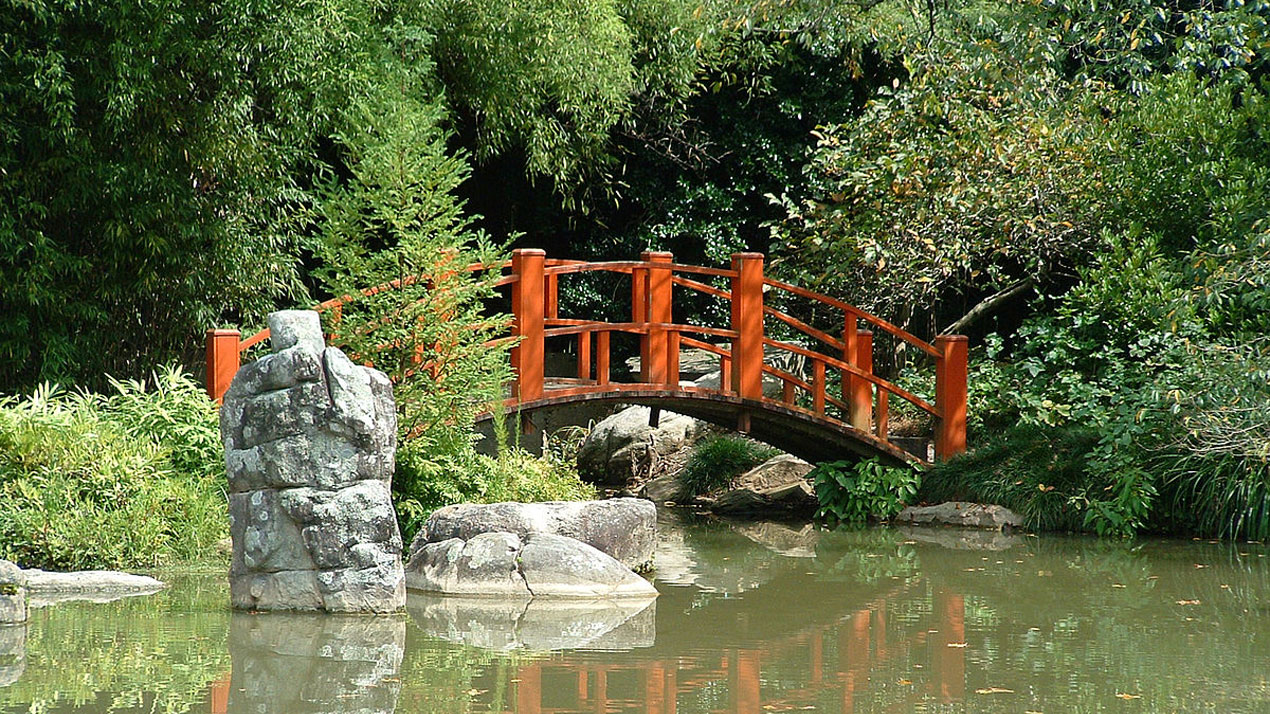
Kyoto Garden, Holland Park, London
Kyoto Garden in Holland Park, London, is a serene Japanese paradise.
Adorned with a picturesque pond, tranquil waterfalls, and vibrant flora, it offers a peaceful escape from the bustling city.
Delicate cherry blossoms and traditional Japanese architecture create a harmonious ambiance for visitors seeking tranquillity and natural beauty.
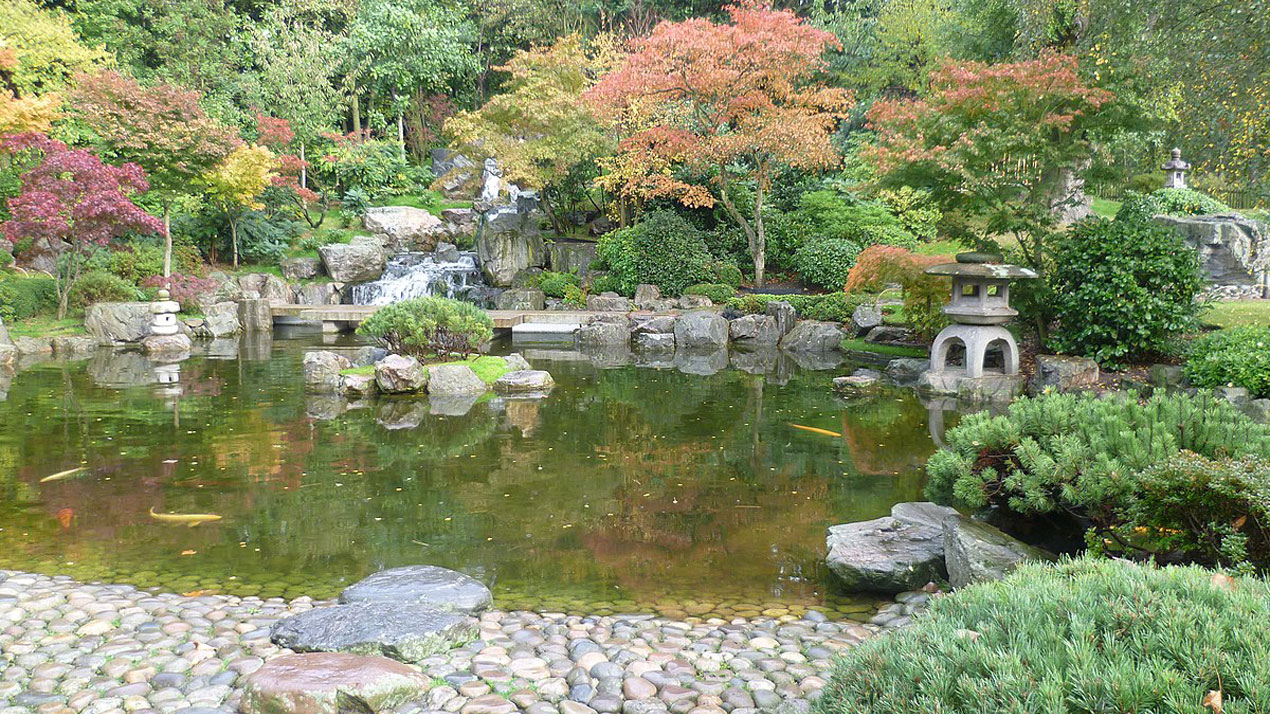
Conclusion
In essence, Japanese garden design is an exquisite testament to the profound connection between humans and nature. The intricate interplay of elements, from the deliberate arrangement of rocks to the meticulous pruning of trees, weaves a story of balance, symbolism, and serenity. These gardens transcend their physical forms, serving as reflective havens that invite contemplation, introspection, and a deeper understanding of life’s transient beauty.
Whether nestled in bustling urban centers or tucked away in tranquil corners, Japanese gardens exemplify the harmony that can be achieved through meticulous craftsmanship and a deep reverence for nature. As we’ve explored the rich history, philosophies, and design principles, it becomes clear that these landscapes are not merely cultivated spaces, but expressions of an ancient, enduring wisdom.
By embracing the art of Japanese garden design, we open ourselves to a transformative journey—an opportunity to reconnect with the earth, find solace in simplicity, and foster a sense of calm amidst the complexities of our modern lives. These gardens remind us that in nurturing nature, we ultimately nurture ourselves.

